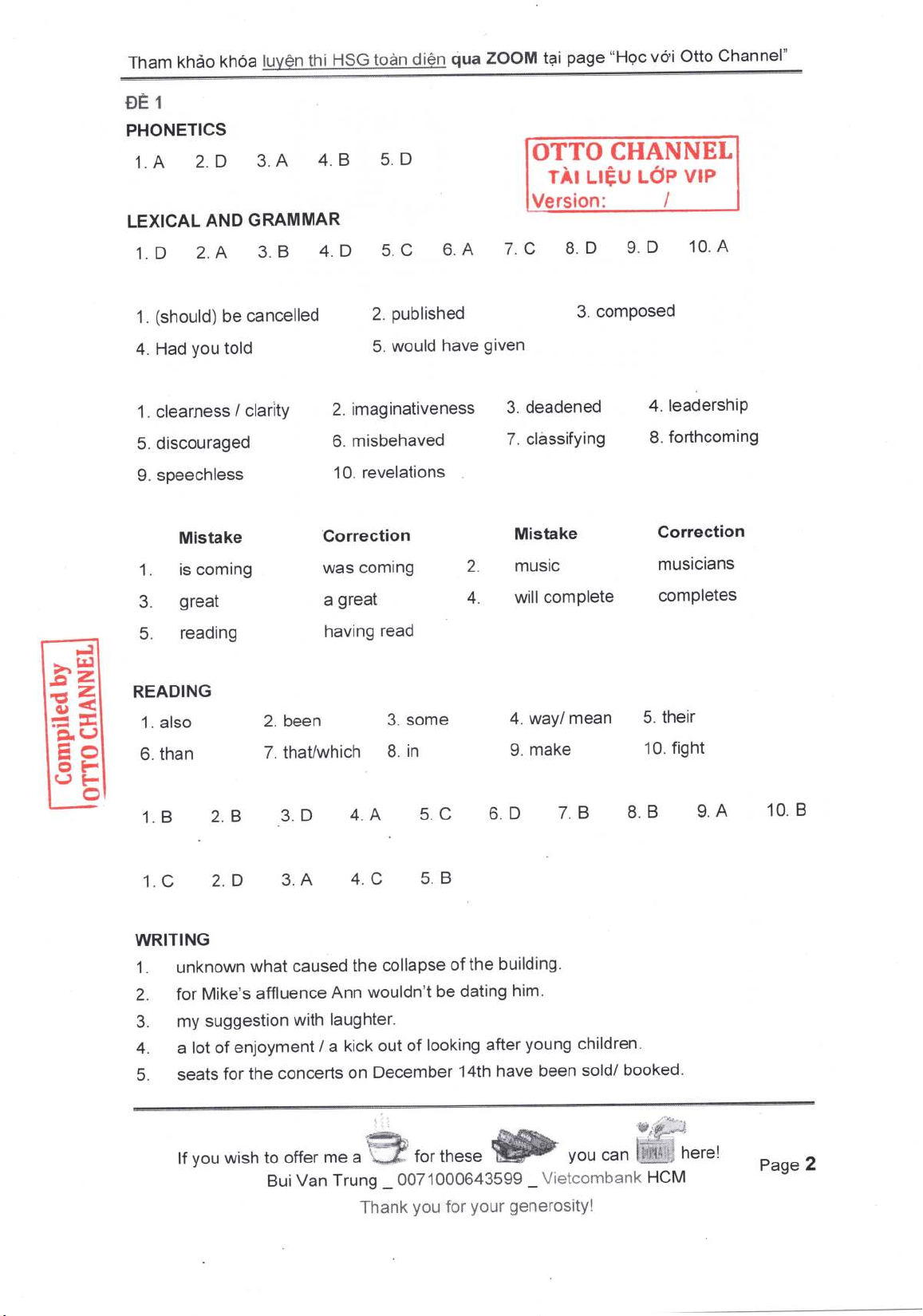
OTTO CHANNEL
Keeping the fire of Passion
Teach from
not from
Thân tặng các bạn đã ủng hộ Otto Channel
TUYỂN TẬP
ĐỀ THI
HỌC SINH GIỎI LỚP 8
With Answer Key
Sưu tầm & Tổng hợp

ĐỪNG LO LẮNG!
Trong nhóm có rất nhiều bạn giỏi, có những anh / chị
đạt kết quả
cao
trong các kỳ thi Chuyên / HSG sẽ nhiệt tình giải đáp & giúp đỡ
Bạn nhé!
➢ Hỏi thăm chị Google
về page “Hỗ trợ tự luyện thi chuyên Anh
và HSG với Otto Channel”
➢ Sau khi có thông tin thì chỉ việc
Click tham gia
nhóm thôi
nè…
OPTION 1
Tham gia Nhóm “Hỗ trợ tự luyện thi chuyên
Anh và HSG với Otto Channel”
Đăng câu hỏi của mình
OPTION 2
Đăng ký ngay lớp VIP luyện thi chuyên Anh qua Zoom
để cùng
Thầy Otto chinh phục ước mơ của Bạn nhé!
BẠN CÓ TỚI 2 OPTIONS ĐỂ LỰA CHỌN OR CHỌN LUÔN CẢ 2
Released!!!
Trong quá trình tự học, Bạn sẽ cảm
thấy khó khăn vì có
hàng loạt chỗ
không hiểu
…

Tham khảo khóa luyện thi HSG toàn diện qua ZOOM tại page “Học với Otto Channel”
If you wish to offer me a
for these
you can
here!
Bui Van Trung _ 0071000643599 _ Vietcombank HCM
Thank you for your generosity!
Page 3
PHÒNG GIÁO DỤC & ĐÀO TẠO
OTTO CHANNEL
ĐỀ THI HỌC SINH GIỎI LỚP 8
ĐỀ THI SỐ 01
Môn: TIẾNG ANH
Thời gian làm bài: 120 phút
ĐỀ 1
LISTENING
I. Listen to the radio interview about high-achieving teenagers and choose
the best option to complete the sentences.
1. Many famous and successful teenagers have .
A. used new technology
B. worked from an early age
C. been inspired by You Tube videos
2. Some people say Justin Bieber is the most influential person in the world because
.
A. he has had so many number one song
B. he has so many followers on Twitter
C. he is friends with Barack Obama
3. A negative consequence of fame for Justin Bieber is .
A. he has very little privacy
B. people get bored of hearing about him
C. people criticise his appearance
4. Style Rookie .
A. allowed readers to post pictures of themselves
B. soon had a lot of readers
C. was noticed by Karl Lagerfeld.
5. When some people didn’t believe her age, Tavi .
A. was sad and angry at first
B. decided to attack them in return
C. completely ignored them and continued working
6. Louise thinks .
A. it’s difficult for Tavi to have a normal life
B. there’s more pressure when you are a writer
C. there’s more pressure when you are a performer.

Tham khảo khóa luyện thi HSG toàn diện qua ZOOM tại page “Học với Otto Channel”
If you wish to offer me a
for these
you can
here!
Bui Van Trung _ 0071000643599 _ Vietcombank HCM
Thank you for your generosity!
Page 4
II. Which sentences are true about memorization? Listen to the radio interview
about improving your memory and circle four correct answers.
A. We all use memory in the same way.
B. We learn to use our memory as soon as we are born.
C. There are two different forms of memorisation.
D. We are taught how to improve our memory in history lessons.
E. Writing shopping list can improve your memory.
F. Teaching helps us to memorise.
G. We can train our brains to be more effective.
H. We can only use one image at a time as an aid to memorisation.
III. Listen and write one word to fill the gaps.
1. The teacher tells the students to pay to what she is saying.
2. For some people, what they do after school on their exam results.
3. Students with mostly A answers have a good towards studying.
4. Students with mostly B answers can improve and excellent
students.
5. If ‘C’ students don’t change, they might leave school without any .
PHONETICS
I. Choose the word whose underlined part is pronounced differently from the
rest of the group. # page “Học với Otto Channel”#
1.
A. breather
B. feather
C. heather
D. leather
2.
A. audible
B. audience
C. laundry
D. draughty
3.
A. vessel
B. passion
C. impression
D. pressure
II. Choose the word whose stress is different from the rest of the group.
4.
A. influential
B. creative
C. introduction
D. university
5.
A. significant
B. believable
C. committee
D. quantity
LEXICAL AND GRAMMAR
I. Choose the most suitable word or phrase to complete each sentence.
1. I’d like to take this of wishing you all the best of luck with your exams.
A. chance B. possibility C. occasion D. opportunity
2. They said they had the European rights for the product but it was a lie. They were
acting under false .
A. pretences B. eel C. egg D. wool
3. Although he has been dead for many years, Elvis Presley is a person
many people continue to be interested.
A. in that B. in whom C. whom D. in him

Tham khảo khóa luyện thi HSG toàn diện qua ZOOM tại page “Học với Otto Channel”
If you wish to offer me a
for these
you can
here!
Bui Van Trung _ 0071000643599 _ Vietcombank HCM
Thank you for your generosity!
Page 5
4. When asked she has interviewed with other companies, she denied
having done so.
A. when B. whenever C. while D. whether
5. “There’s a car coming!” “ ”
A. Attention! B. Watch! C. Look out! D. Take guard!
6. My mother had to work 12 hours a day in a factory just to
A. make ends meet B. call it a day
C. tighten the belt D. break the ice
7. Jackson was trying to another cyclist when he crashed.
A. overpass B. overcome C. overtake D. overcharge
8. Before railways were built, many goods were carried on
A. channel B. water C. river D. canals
9. You have told me that my skirt was split!
A. needn’t B. must C. all D. might
10. I know this is a big disappointment but I don’t take it to
A. heart B. mind C. soul D. spirit
II. Use the verbs in brackets in the correct tense or form.
It’s vitally important that the order (1. CANCEL) immediately
I think his book will become a best seller when (2. PUBLISH)
The symphonies (3. COMPOSE) by Moza are wonderful.
“I had to walk home because my bike was broken.”
“You (4. TELL) me, I (5. GIVE ) you a lift.”
III. Supply the correct form of the word in capital letter
1. She often explains her ideas with (CLEAR)
2. Without (IMAGINE) , you can hardly become a writer.
3. Your constant criticism has (DIE) to apologize.
4. The successful candidate will have superb (LEAD) skills.
5. He felt very (COURAGE) when he saw he had failed the exam
again.
6. The teacher warned the children that if they (BEHAVE) again,
they’d be punished.
7. Librarians spend a lot of time (CLASS) books.
8. A list of (COME) events will be posted on the notice board.
9. I was so angry that I was (SPEAK)
10. Have you read the latest (REVEAL) about Madonna’s private life.

Tham khảo khóa luyện thi HSG toàn diện qua ZOOM tại page “Học với Otto Channel”
If you wish to offer me a
for these
you can
here!
Bui Van Trung _ 0071000643599 _ Vietcombank HCM
Thank you for your generosity!
Page 6
IV. Find and correct mistake in each following sentence. # page “Học với Otto
Channel”#
Mistake
Correction
1. Two days ago, the weather forecast warned us
that a tornado is coming.
2. For centuries, music have played acoustical
guitars, which produce sound from the vibration
of the strings.
3. The earliest steam-driven vehicles produced
great amount of noise.
4. Halley’s Comet is coming back in 2062 after it
will complete another orbit.
5. Reading several books on that subject, Bill
considered himself an expert.
READING
I. Fill in each numbered blank with ONE appropriate word
You not only laugh more when you are relaxed, but you (1)
relax when you laugh, and it has (2)
found that when you’re on holiday it is easier to do both.
But for (3) people laughter is not just a pleasure, it
is a (4) of fighting illness. Some hospitals have
begun to bring in clowns to relieve the silent, depressing
atmosphere, especially in children’s wards.
This scheme is called “Medical Smile” and it helps sick
children in a way that doctors, with all (5)
knowledge, can’t do. The effect of the clowns is more (6)
psychological. Laughter helps strengthen the immune system
- that is, the part of our bodies (7) fight
off disease. We take (8) more oxygen when we
laugh, and our heartbeat slows down.
Hospital clowns are becoming more and more popular because of the positive effects
they have. They both relieve depression, which tends to (9) illness
worse, and give people the will to (10) their illnesses themselves.
II. Read the following passage and choose the best word for each blank.
Over the last few centuries, great (1) have been made in the field of medicine.
More treatments have become available, so that a range of illness can be (2)
and the life (3) of people in developed countries has extended. It is still a matter
of debate, however, whether governments should focus on prevention or cure.

Tham khảo khóa luyện thi HSG toàn diện qua ZOOM tại page “Học với Otto Channel”
If you wish to offer me a
for these
you can
here!
Bui Van Trung _ 0071000643599 _ Vietcombank HCM
Thank you for your generosity!
Page 7
Nowadays the media is used to promote a (4) approach to preserving health.
In the other words, people are encouraged to look after not only their bodies, but also
their mental and emotional (5) . We have had anti-smoking campaigns and
advice on nutrition for decades, and many people have quit their nicotine habit or
reduce their fat intake. Thus, there has been some decline in lung and heart disease.
The government also supports childhood (6) programmes. Thus, few
children suffer from previously fatal illness such as rubella or hepatitis B. Now we also
have leaflets available in doctor’s waiting room on relaxation techniques to reduce
stress. Alongside these are posters recommending how much exercise should be
taken.
However, when it comes to most forms of cancer and inherited genetic disorders, the
only option available is treatment and so it is vital that governments continue to (7)
research into medication. More effective pain (8) and drugs with
fewer (9) effects should be available to all citizens, not just to the minority
who can afford the prices that (10) companies charge. Prevention only
works when a person has active control over the way their body functions.
1.
A. stage
B. advances
C. results
D. answers
2.
A. healed
B. cured
C. dealt
D. aided
3.
A. expansion
B. longevity
C. period
D. expectancy
4.
A. holistic
B. conservation
C. supplementary
D. detailed
5.
A. aspects
B. situation
C. well-being
D. background
6.
A. injection
B. antidote
C. antibiotics
D. immunization
7.
A. pay
B. fun
C. donate
D. afford
8.
A. delay
B. relief
C. support
D. assistance
9.
A. side
B. extra
C. margin
D. down
10.
A. chemistry
B. pharmaceutical
C. medicinal
D. surgical
III. Read the passage and choose the best answers to questions below. # page
“Học với Otto Channel”#
Since the world has become industrialized, there has been an increase in the number
of animal species that have either become extinct or have neared extinction.
Bengal tigers, for instance, which once roamed the jungles
in vast numbers, now number only about 2,300 and by the
year 2025, their population is estimated to be down to zero.
What is alarming about the case of the Bengal tiger is that
this extinction will have been caused almost entirely by
poachers who, according to some sources, are not
interested in material gain but in personal gratification. This
is an example of the callousness that is part of what is
causing the problem of extinction.

Tham khảo khóa luyện thi HSG toàn diện qua ZOOM tại page “Học với Otto Channel”
If you wish to offer me a
for these
you can
here!
Bui Van Trung _ 0071000643599 _ Vietcombank HCM
Thank you for your generosity!
Page 8
Animals like the Bengal tigers, as well as other endangered species, are a valuable
part of the world’s ecosystem. International laws protecting these animals must be
enacted to ensure their survival, and the survival of our planet.
Countries around the world have begun to deal with the problem in various ways. Some
countries, in order to circumvent the problem, have allocated large amounts of land to
animal reserves. They, then charge admission to help defray the costs of maintaining
the parks, and they often must also depend on world organizations for support. With
the money they get, they can invest equipment and patrols to protect the animals.
Another solution that is an attempt to stem the tide of animal extinction is an
international boycott of products made from endangered species. This seems fairly
effective, but will not by itself, prevent animals from being hunted and killed.
1. What is the main topic of the passage?
A. The bengal tiger C. Endangered species
B. International boycotts D. Problem with industrialization
2. The word “callousness” in the first paragraph could be best replaced by which
of the following?
A. indirectness B. independence C. incompetence D. insensitivity
3. The above passage is divided into two paragraphs in order to contrast .
A. a problem and a solution C. a comparison and a contrast
B. a statement and an illustration D. a specific and general information
4. What does the word “This” in the first paragraph refers to?
A. Endangered species that are increasing
B. Bengal tigers that are decreasing
C. Poachers who seeks personal gratification
D. Sources that may not be accurate
5. Which of the following best describes the author’s attitude?
A. forgiving B. concerned C. vindictive D. surprised
WRITING
I. Complete each of the following sentences in such a way that it means the
same as the sentence printed before it. # page “Học với Otto Channel”#
1. Nobody knows what caused the collapse of the building.
→ It’s ................................................................................................................
2. Were Mike not as affluent a man, Ann wouldn’t be dating him.
→ But ................................................................................................................
3. When I made my suggestion, he laughed.
→ He greeted ...................................................................................................

Tham khảo khóa luyện thi HSG toàn diện qua ZOOM tại page “Học với Otto Channel”
If you wish to offer me a
for these
you can
here!
Bui Van Trung _ 0071000643599 _ Vietcombank HCM
Thank you for your generosity!
Page 9
4. Jane enjoys looking after young children very much.
→ Jane gets .....................................................................................................
5. We have no seats left for the concert on December 14th.
→ All the ...........................................................................................................
6. Mary knew what the answer was after reading the book.
→ By the time ...................................................................................................
7. The people who were at the meeting will say nothing to the press.
→ Nobody .........................................................................................................
8. You must never mention this to him.
→ Under ...........................................................................................................
9. His efforts to find a solution didn’t deserve such savage criticism.
→ He shouldn’t .................................................................................................
10. She took extra night classes, so as not to have to repeat the course.
→ She avoided .................................................................................................
II. Complete the second sentence so that it has a similar meaning to the first
one. Do not change the word given. # page “Học với Otto Channel”#
1. Don’t run away with the idea that this job is easy. (CONCLUSION)
→ Don’t .............................................................................................................
2. They say the ice in Antarctica is getting thinner all the time. (SAID)
→ The ice .........................................................................................................
3. It was wrong of you not to tell me that information. (KEPT)
→ You should ...................................................................................................
4. We managed to escape just before the whole building caught on fire. (HAD)
→ No ................................................................................................................
5. The coach’s tactics were directly responsible for the team’s defeat.
(CONSEQUENCE)
→ The team’s ...................................................................................................
III. Essay
Write an essay in about 120-150 words to express your ideas.
Some students prefer to study alone. Others prefer to study with a group of
students. Which do you prefer?
Use specific reasons and examples to support your answer.

Tham khảo khóa luyện thi HSG toàn diện qua ZOOM tại page “Học với Otto Channel”
If you wish to offer me a
for these
you can
here!
Bui Van Trung _ 0071000643599 _ Vietcombank HCM
Thank you for your generosity!
Page 10
PHÒNG GIÁO DỤC & ĐÀO TẠO
OTTO CHANNEL
ĐỀ THI HỌC SINH GIỎI LỚP 8
ĐỀ THI SỐ 02
Môn: TIẾNG ANH
Thời gian làm bài: 120 phút
ĐỀ 2
LISTENING
I. Circle the correct information about each invitation.
1. A. Lynne refuses Dave’s invitation.
B. The invitation is for Saturday.
C. Lynne will meet Dave’s parents
on Saturday.
2. A. Paula already has plans.
B. They will meet at the bookstore.
C. The invitation is for Friday.
3. A. Ron accepts the invitation.
B. Ron has to study for a big exam.
C. Ron has to work late.
4. A. There will be free drinks and food.
B. Rose refuses the invitation.
C. Rose doesn’t think it will be fun
5. A. They will go downtown after
class.
B. They both hate listening to
music.
C. The invitation is for next month.
6. A. The invitation is for Sunday.
B. George likes those kinds of shows.
C. They will go to the show in the
morning.
II. Listen and fill in the blank with a suitable word you hear.
Many (1) believe blood types are linked to (2) .
The (3) started in 1927 by Takeji Furukawa. He came up with the (4)
after working in a high school Takeji was not a (5) , but his
theory was popular news. Then, in the 1970s, a (6) wrote books
about the idea. The books were well- known There is no scientific (7)
supporting the idea that blood types are (8) to personalities. But the idea is
still (9) in Japan, and that is why ninety percent of Japanese people know
their blood type.
VOCABULARY AND GRAMMAR
I. Choose one word whose underlined part is pronounced differently from the
others. # page “Học với Otto Channel”#
1.
A. great
B. bread
C. break
D. veil
2.
A. foreign
B. continent
C. scholarship
D. almost
3.
A. painted
B. looked
C. jumped
D. missed
4.
A. boot
B. shoot
C. good
D. food
5.
A. species
B. pollute
C. accept
D. receipt

Tham khảo khóa luyện thi HSG toàn diện qua ZOOM tại page “Học với Otto Channel”
If you wish to offer me a
for these
you can
here!
Bui Van Trung _ 0071000643599 _ Vietcombank HCM
Thank you for your generosity!
Page 11
II. Choose one word whose stress pattern is different from the others.
6.
A. gravity
B. deposit
C. pyramid
D. colorful
7.
A. industrial
B. exhibition
C. preparation
D. decoration
8.
A. brilliant
B. insect
C. lunar
D. proceed
9.
A. reference
B. important
C. refusal
D. decision
10.
A. curriculum
B. tropical
C. historical
D. grammatical
III. Choose the best answer to complete the sentences.
1. She is not to be at home until six.
A. likely B. sure C. possible D. certain
2. Could you get an extra of milk for me, please?
A. bar B. slice C. carton D. packet
3. The human brain only two percent of an adult's body weight.
A. which makes up B. it makes up C. makes it up D. makes up
4. We have worked out the plan and now we must put it into .
A. practice B. reality C. fact D. deed
5. Katie really her mother. She has got the same character.
A. takes after B. takes up C. takes in D. takes on
6. Some of the passengers spoke to reporters about their in the burning
plane.
A. knowledge B. experience C. occasion D. event
7. She tries to set an hour a week for practice.
A. about B. down C. aside D. in
8. stay the night if it’s too difficult to get home.
A. At all costs B. By all means C. In all D. On the whole
9. Robert and his wife to my house for tea yesterday evening.
A. came round B. came about C. came down D. came away
10. Each of the guests a bunch of flowers.
A. are given B. is given C. were given D. give
IV. Give the correct tense or form of the verbs in brackets to complete the
following sentences. # page “Học với Otto Channel”#
Can you tell me when the bus for Ho Chi Minh City (1. LEAVE) ?
At 8 every morning.
This is the first time I (2. READ) a novel (3. WRITE) by
an English novelist.

Tham khảo khóa luyện thi HSG toàn diện qua ZOOM tại page “Học với Otto Channel”
If you wish to offer me a
for these
you can
here!
Bui Van Trung _ 0071000643599 _ Vietcombank HCM
Thank you for your generosity!
Page 12
I (4. SIT) down for a rest while my bike (5. REPAIR) .
I don’t believe it! It’s three in the morning and that party still (6. NOT FINISH)
.
Two miles (7. BE) enough for her to go jogging every morning.
Don’t call him at 2.30 p.m. He (8. INTERVIEW) job applicants at that
time.
I didn’t do the test well. I (9. PREPARE) it very carefully at
home.
I don’t mind her (10. APPOINT) above me.
V. Fill in the blanks with the correct form of the words in capital letters.
From what we had read in the (1. ADVERTISE) , it promise to be
the holiday of a lifetime – not only a quality hotel in a top (2. SEA)
resort, but also (3. SURPRISE) cheap with it! We should have known
it was too good to be true! We arrived at the airport to discover we only had (4. STAND)
tickets and there was no guarantee we would be flying. Luckily, two
places became free at the last minute and we took off. The flight lasted at least (5.
TWO) as long as it should have and by the time we arrived, we were
both feeling rather (6. POOR) , probably because of the dubious in-
flight meal we had had. We were met by our guide, who seemed (7. LANGUAGE)
incompetent and understood very little of what we said to him. Instead
of the hotel we had seen in the photograph back home, he took us to a squalid little
guesthouse much (8. FAR) away from the resort than we were
expecting. We wanted to explain that there had been a (9. DREAD)
mistake but it was (10. USE) trying to complain – nobody could
understand us.
VI. Each of the following sentences contains one error. Find and correct it. #
page “Học với Otto Channel”#
Mistake
Correction
1. The King was too happy that he decided to build
a pagoda of lotus shape over water.
2. If I knew you were coming, I would have met
you at the airport.
3. The effectiveness of learning with computers
depend on some factors.
4. For such an experience and able teacher,
discipline was not a problem.
5. Never before have so many people in the
United States interested in soccer.

Tham khảo khóa luyện thi HSG toàn diện qua ZOOM tại page “Học với Otto Channel”
If you wish to offer me a
for these
you can
here!
Bui Van Trung _ 0071000643599 _ Vietcombank HCM
Thank you for your generosity!
Page 13
READING
I. Read the following passage and choose the word (A, B, C or D) to complete
each blank. # page “Học với Otto Channel”#
“My home is in the air – I do an enormous amount of traveling. It is a fast life and (1)
of work, but I like it and that is the only way (2) me. Everything is tiring
– music, traveling – but what can I do? I am not (3) to complaining. It is
hard to imagine now (4) I will ever be very long in one place. My home town is on
the Caspian Sea. There is sea, wind, sun and (5) (many tourists and hotels. I
have my own flat with four or five rooms, but I am seldom there. If I am there for a day
or two I prefer to (6) with my mother and grandmother. They live in a small
house, (7) it is very comfortable and my mother cooks for me. I like good,
simple food. I have no wife, no brothers or sisters and my father (8) when I
was seven. He was an engineer and I don’t (9) him very well. He liked music
very much and wanted me to (10) a musician.”
1.
A. most
B. full
C. complete
D. more
2.
A. for
B. to
C. in
D. by
3.
A. wanted
B. taken
C. used
D. known
4.
A. and
B. so
C. while
D. that
5.
A. far
B. too
C. much
D. more
6.
A. stay
B. go
C. do
D. spend
7.
A. but
B. since
C. even
D. which
8.
A. killed
B. gone
C. passed
D. died
9.
A. know
B. remember
C. remind
D. see
10.
A. become
B. turn
C. develop
D. grow
II. Read the passage below and then choose the correct answer A, B, C or D.
The culture of Vietnam is one of the oldest in the Southeast Asia region. Although
Vietnam lies geographically in Southeast Asia, long periods of Chinese domination and
influence has resulted in the emergence of many East Asian characteristics in
Vietnamese culture, and generally Vietnam is said to be a part of the East Asian
cultural sphere, known widely as Chinese cultural sphere. Despite considerable foreign
influence, Vietnamese people have managed to retain many distinct customs. While
Chinese culture has the largest influence on traditional Vietnamese culture, there is
also a much smaller influence from the Cham and later Western cultures, most notably
of France, Russia and the United States.
In term of prehistory, most Vietnamese historians consider the ancient Dong Son
Culture to be one of the defining aspects of early Vietnamese civilization. Vietnam’s
population in 2006 was 84,402,966, with a population density of 253 people per km
2
.
Most people live in or near the densely populous Red River or Mekong deltas. Due to

Tham khảo khóa luyện thi HSG toàn diện qua ZOOM tại page “Học với Otto Channel”
If you wish to offer me a
for these
you can
here!
Bui Van Trung _ 0071000643599 _ Vietcombank HCM
Thank you for your generosity!
Page 14
the nation’s southward expansion throughout its history, along with the different climate
and environment met by the settlers as they moved further south, slightly different
regional cultures began to emerge, most notably between Northern and Southern
Vietnam.
1. The culture of Vietnam
A. is the youngest in Asia
B. does not get any Asian characteristics
C. was influenced by that of China
D. was greatly dominated by that of Western
2. Which culture has not affected the Vietnamese one?
A. of the United States B. of the United Kingdom
C. of Russia D. of France
3. Vietnamese people
A. cannot keep their own culture in their daily life
B. have many diverse nation customs
C. highly appreciate the Western influence on their culture
D. failed to retain the native customs
4. Through history, Vietnam expended to the
A. south B. north C. east D. west
5. Which statement is true?
A. The North and the South of Vietnam have the same regional cultures.
B. The Mekong delta is more populous than the Red River one.
C. Red River delta is densely populous.
D. Vietnamese people do not like living in the deltas.
III. Fill in each blank with one suitable word to complete this passage.
Travelling to all corners of the world is (1)
easier and easier. We live (2) a global village,
but how well do we know and understand each other?
Here is (3) simple test. Imagine you have
arranged a meeting at 4 p.m. What time should you expect
your foreign business colleagues to arrive? If they are
German, they ‘ll be exactly (4) time.
If they are American, they ‘ll probably be 15 minutes early.
If they are British, they be 15 minutes (5) ,
and you should allow up to an hour for the Indians.
Therefore, these are some small advice in (6) not
to behave badly abroad.

Tham khảo khóa luyện thi HSG toàn diện qua ZOOM tại page “Học với Otto Channel”
If you wish to offer me a
for these
you can
here!
Bui Van Trung _ 0071000643599 _ Vietcombank HCM
Thank you for your generosity!
Page 15
In France you shouldn’t sit down in a cafard until you are shaken hands with everyone
you know. In Afghanistan you’d better spend at last 5 minutes (7) hello. In
Pakistan you mustn’t wink. It is offensive. In the Middle East you must never use the
left hand for greeting, eating, drinking or smoking. Also, you should care not to admire
(8) in your host’s home. They will feel that they have to give it to you. In
Russia you must match your hosts drink for drink or they will think you are unfriendly.
In Thailand you should clasp your hands (9) and lower your head and your
eyes when you greet someone. In America you should eat your hamburger with both
hands and as quickly as (10) . You shouldn’t try to have a conversation
until it is eaten.
WRITING
I. Rewrite the sentences in such a way that they mean the same as those
printed before. # page “Học với Otto Channel”#
1. My brother studies now harder than he used to.
→ My brother ....................................................................................................
2. Please don’t ask me that question.
→ I’d rather .......................................................................................................
3. I last saw Bob when I was in Ho Chi Minh City.
→ I haven’t ......................................................................................................
4. John only understood very little what the teacher said.
→ John could hardly .......................................................................................
5. Tom will be twenty next week.
→ It’s Tom’s .....................................................................................................
6. She is fond of her nephew although he behaves terribly.
→ She is fond of her nephew in .......................................................................
7. “Could I borrow five pounds from you, Jane?” asked Nick.
→ Nick asked Jane if ......................................................................................
8. He didn’t hurry, so he missed the bus.
→ If .................................................................................................................
9. The train takes longer than the plane.
→ The plane ...................................................................................................
10. I don’t suppose you have change for 2 pounds, do you?
→ Do you happen ...........................................................................................

Tham khảo khóa luyện thi HSG toàn diện qua ZOOM tại page “Học với Otto Channel”
If you wish to offer me a
for these
you can
here!
Bui Van Trung _ 0071000643599 _ Vietcombank HCM
Thank you for your generosity!
Page 16
II. Use the given suggestions to complete sentences.
1. About five million/ bottle/ champagne/ produced/ France/ next year/.
→ .....................................................................................................................
2. I/ now/ tired/ since/I /stay/ late/ do/ homework/.
→ .....................................................................................................................
3. That/ one/ most/ interesting/ books/I/ read/.
→ .....................................................................................................................
4. Know/ how/ use/ computer/ very important/ nowadays/.
→ .....................................................................................................................
5. He/ show/ photograph/ hotel/ stay/ holiday/.
→ .....................................................................................................................
6. The watch / which / mother / give / me / last week / be / valuable / present.
→ .....................................................................................................................
7. Since / beginning / course / she / never / late / school.
→ .....................................................................................................................
8. My friend David / cannot / get / used / have meals / with chopsticks.
→ .....................................................................................................................
9. Passover / celebrate / every / country / world?
→ .....................................................................................................................
10. We / be / close friend / because / have / many things / common.
→ .....................................................................................................................
III. Use the given word to write the second sentence in such a way that it is as
similar as possible in meaning to the original sentence. Do not change the
form of the given word. # page “Học với Otto Channel”#
1. There’s hardly anything he doesn’t know about whales. (KNOWS)
→ .....................................................................................................................
2. He enjoys walking in the rain. (PLEASURE)
→ .....................................................................................................................
3. Joanne has a rather unsatisfactory relationship with her sisters. (GET)
→ Joanne .........................................................................................................
4. The committee decided that the crash was not the pilot’s fault. (BLAME)
→ The committee .............................................................................................
5. If we tried to force him to repay the debt, we would be wasting of time. (POINT)
→ There was ....................................................................................................

Tham khảo khóa luyện thi HSG toàn diện qua ZOOM tại page “Học với Otto Channel”
If you wish to offer me a
for these
you can
here!
Bui Van Trung _ 0071000643599 _ Vietcombank HCM
Thank you for your generosity!
Page 17
PHÒNG GIÁO DỤC & ĐÀO TẠO
OTTO CHANNEL
ĐỀ THI HỌC SINH GIỎI LỚP 8
ĐỀ THI SỐ 03
Môn: TIẾNG ANH
Thời gian làm bài: 120 phút
ĐỀ 3
LISTENING
I. You are going to listen to a conversation between Carl and Pancho, then
choose the best answer.
1. Where is Pancho from?
A. Paraguay B. Peru C. Portugal D. Vietnam
2. How many brothers and sisters does Pancho have?
A. 11 B. 12 C. 13 D. 14
3. What is his father's job?
A. Taxi driver B. Dentist C. Farmer D. Police officer
4. What does his mother do?
A. She owns a beauty salon B. She runs a small family store
C. She works at a bread shop D. She works in a factory
5. Which thing does Pancho NOT say?
A. His brothers and sisters help his mom
B. His mom sells food like eggs and sugar
C. His mother enjoys her job very much
D. His father works hard to support the family
II. Listen to the text and write down the missing words or numbers. (15 points).
Hi, I'm Conrad and I'm going to talk about (1) . This first sport was invented
by a Canadian man, although most people believe it was invented by an American. In
this sport you need at least (2) players on each team and the goal is to
shoot a ball into a basket or hoop. In this next sport, there are usually ten rounds. Each
round is three (3) long. It's man versus man and they are both fighting using
just their (4)
This next sport is in a (5) It's also a very fast-paced sport where swimmers
are swimming back and forth, also throwing a ball into a net. In this sport lots of things
happen under (6) that the referee cannot see. It's a very tough sport to play.
This next sport is on a (7) There is a little white plastic ball that moves very,
very quickly. In Japan there is a famous little girl who plays this sport. Her name is
'love' in English.
This next sport was invented in England. It requires eleven players on each (8)
In this sport you cannot use your hands unless you're the goalie or (9)

Tham khảo khóa luyện thi HSG toàn diện qua ZOOM tại page “Học với Otto Channel”
If you wish to offer me a
for these
you can
here!
Bui Van Trung _ 0071000643599 _ Vietcombank HCM
Thank you for your generosity!
Page 18
And the last sport I'll talk about also happens in the water. This sport is one of the most
(10) sports for the summer Olympics. In this sport, there are four main
strokes, and 'crawl' is the most common.
PRONUNCIATION
Choose the word in each group that has the underlined part pronounced
differently from the rest. # page “Học với Otto Channel”#
1.
A. resources
B. beaches
C. lakes
D. oranges
2.
A. school
B. balloon
C. flood
D. moon
3.
A. collection
B. question
C. nation
D. inspiration
4.
A. turn
B. burn
C. curtain
D. bury
5.
A. naked
B. looked
C. missed
D. worked
Choose the word whose stress pattern is different from the other three in the
following questions.
1.
A. argument
B. reject
C. attract
D. install
2.
A. librarian
B. religious
C. commercial
D. Japanese
3.
A. technology
B. activity
C. experience
D. presentation
4.
A. informality
B. entertainment
C. situation
D. appropriate
5.
A. experience
B. cosmetics
C. economics
D. fertility
LEXICO – GRAMMAR
I. Choose the best option (A, B, C or D) to complete each of the following
sentences.
1. Much of what he said had little to the issue we were discussing.
A. accordance B. involvement C. concern D. relevance
2. The restless lion kept pacing along the front of its cage.
A. back and fort B. up and down C. on and off D. back and out
3. You can have for the meals during your package vacation.
A. vouchers B. tags C. checks D. records
4. A new motorcycle model has just been on the Internet.
A. delivered B. designed C. launched D. exploited
5. Why don’t you a go? - It’s not difficult!
A. do B. have C. set D. make
6. The Prime Minister has from the dogmatic position he adopted a few
days ago.
A. backed out B. backed down C. backed up D. backed on

Tham khảo khóa luyện thi HSG toàn diện qua ZOOM tại page “Học với Otto Channel”
If you wish to offer me a
for these
you can
here!
Bui Van Trung _ 0071000643599 _ Vietcombank HCM
Thank you for your generosity!
Page 19
7. At the South Pole , the coldest and most desolate region on Earth.
A. Antarctica lies where B. Antarctica lies and
C. where Antarctica lies D. lies Antarctica
8. in the diet is especially important for vegetarians.
A. Enough protein is obtained B. Obtaining enough protein
C. They obtain enough protein D. By obtaining enough protein
9. over long distances is a fact.
A. That electricity can be transmitted B. That electricity transmitting
C. That electricity D. That can be transmitted
10. Don’t leave paraffin heaters in a draught or where they’re
A. dangerously knocked over B. in danger knocked over
C. in danger of being knocked over D. in danger of knocking over
11. My father took of the fine weather to a day’s work in his garden.
A. chance B. advantage C. interest D. charge
12. By 2050, medical technology many diseases.
A. has conquered B. will conquer
C. will have conquered D. is conquering
13. I realized that he was a thief.
A. sooner or later B. all along C. at the beginning D. eventually
14. his assistance in those days, I would not be so successful now.
A. If it had not for B. Had it not been for
C. If there were not D. Unless I had
15. They thought they could deceive me but they were wrong. I could .
A. see them off B. see off them
C. see through them D. see them through
16. Janet will see you if you use the computer without permission. She has eyes like
a .
A. hawk B. bird C. goose D. fox
17. My sister remained very calm. She .
A. kept her temper B. kept her soul
C. kept her head D. lost her head
18. A network of railroads to unite the continent and encourage Western settlement
before the Civil War by Asa Whitney.
A. when proposed B. to propose
C. was proposed D. a proposal

Tham khảo khóa luyện thi HSG toàn diện qua ZOOM tại page “Học với Otto Channel”
If you wish to offer me a
for these
you can
here!
Bui Van Trung _ 0071000643599 _ Vietcombank HCM
Thank you for your generosity!
Page 20
19. Farmers are at the of the bad weather that can destroy their crop.
A. change B. influence C. force D. mercy
20. He showed his for the TV programme by switching it off.
A. distaste B. discontent C. annoyance D. boredom
II. Use the word given in capitals to form a word that fits in the space.
It was not so long ago that we dealt with colleagues through face-to-face interaction
and with counterparts and customers by phone or letter. But the world of
communication has (1. GO) a dramatic transformation, not all for the
good. Email, while (2. DOUBT) a swift means of communication providing
your server is fully (3. FUNCTION) and that the address you have
contains no (4. ACCURATE) has had a (5. SIGNIFY) effect on
certain people's, both at home and in business. For these people, the use of email has
become (6. RESIST) addictive to the extent that it is (7. THREAD)
their mental and physical health. Addicts spend their day (8.
COMPULSION) checking for email and have a (9. TEND) to
panic if their server goes down. It is estimated that one in six people spend four hours
a day sending and receiving messages the equivalent to more than two working days
a week. The negative effect on (10. PRODUCE) is something employers
are well aware of.
III. Complete each of the following sentences with a suitable preposition. #
page “Học với Otto Channel”#
1. I have already told Tim that I won’t go to Spain with him, but he still trying to talk
me .
2. receipt of your instructions, I immediately sent a telex message to
Algeria.
3. Grandfather must be tired. He’s nodding in his chair.
4. The applause died after 5 minutes.
5. He accepted my advice reservation.
6. Our students are orientated the science subjects.
7. Cheques should be made to Wellington.
8. I’m in no hurry. I’ll hang
here until you’re ready.
9. She is Polish birth,
but she has French nationality.
10. Your plan doesn’t allow
changes in the weather.

Tham khảo khóa luyện thi HSG toàn diện qua ZOOM tại page “Học với Otto Channel”
If you wish to offer me a
for these
you can
here!
Bui Van Trung _ 0071000643599 _ Vietcombank HCM
Thank you for your generosity!
Page 21
READING
I. Fill each of the following numbered blanks with ONE suitable word.
HOW TO WIN FRIENDS AND INFLUENCE COLLEAGUES
The worst sins that office workers can commit in the eyes of colleagues are interrupting
people on the phone, talking loudly in front of someone’s desk and arriving late (1)
a meeting. It is almost (2) bad to eat at your desk, make
personal phone calls or leave coffee cups (3) around, according to Bodytalk,
a guide published by the Industrial Society, (4) lists the 30 traits most likely to
annoy colleagues.
High on the list are signing on at someone else’s computer terminal (5)
signing off afterwards, messing up the photocopier by jamming the paper or leaving it
set to produce multiple copies. Reading newspaper, doodling, chewing gum, keeping
cuddly toys or ornaments on your desk, and putting up postcards or supposedly witty
slogan (6) invite disapproval. Also unpopular are (7) who
never fetch a colleague a drink from the machine, or who (8) to hold the lift
door open when others are approaching. (9) conduct, according to the
guide’s author, Judi James, not only gives you an unprofessional image but is
downright anti-social and could result (10) dismissal.
II. Fill the gaps in the passage by choosing the best phrases from A-M.
A few years ago one enlightened city decided to ease traffic congestion by (1)
. People would just take a bike, ride it to where they were going and leave it (2)
. The trouble was the citizens naturally found it (3) to have
their own free bicycle and (4) .
That slight detail of human nature apart, it was a good idea and (5) . The
electric cars buzzing round the streets of La Rochelle in France are seen (6)
and, it is clamed, will make it easier (7) within the city centre.
The idea is based on the belief that people like their own space, the freedom to drive
a vehicle themselves (8) . It’s also based on the fact that cars in towns usually
carry just one person. In effect, it’s (9) . At the moment, it’s a slightly utopian
view but the concept has grown (10) .
A. to end the use of private cars
B. rather than crowd on to a bus or train
C. to encourage their use
D. stock swiftly dwindled
E. out of a practical study
F. for someone else to use
G. even more convenient
H. supplying sufficient communal bicycles
I. taking the place of bicycles
J. a sort of do-it-yourself taxi
K. as a supplement to conventional cars
L. instead of car
M. it’s now the basic of a new scheme

Tham khảo khóa luyện thi HSG toàn diện qua ZOOM tại page “Học với Otto Channel”
If you wish to offer me a
for these
you can
here!
Bui Van Trung _ 0071000643599 _ Vietcombank HCM
Thank you for your generosity!
Page 22
III. Read the following passage and choose the word A, B, C, or D to indicate
the correct answer to each of the questions. # page “Học với Otto
Channel”#
One of the seven wonders of the ancient world, the Great Pyramid of Giza was a
monument of wisdom and prophecy built as a tomb for Pharaoh Cheops in 2720 B.C.
Despite its antiquity, certain aspects of its construction makes it one of the truly
wonders of the world. The thirteen- acre structure near the Nile river is a solid mass of
stone blocks covered with limestone. Inside are the number of hidden passageways
and the burial chamber of the Pharaoh. It is the largest single structure in the world.
The four sides of the pyramid are aligned almost exactly on true north, south, east and
west-an incredible engineering feat. The ancient Egyptians were sun worshippers and
great astronomers, so computations for the Great Pyramid were based on
astronomical observations.
Explorations and detailed examinations of the base of the structure reveal many
intersecting lines. Further scientific study indicates that these represent a type of
timeline of events – past, present and future. Many of the events have been interpreted
and found to coincide with known facts of the past. Others are prophesied for future
generations and are currently under investigation. Many believe that pyramids have
supernatural powers and this one is no exception. Some researchers even associate
it with extraterrestrial beings of ancient past.
Was this superstructure made by ordinary beings, or one built by a race far superior to
any known today?
1. What has research of the base revealed?
A. there are cracks in the foundation
B. Tomb robbers have stolen the Pharaoh’s body
C. The lines represent important events
D. A superior race of people built in
2. Extraterrestrial beings are .
A. very strong workers B. astronomers in the ancient times
C. researchers in Egyptology D. living beings from other planets

Tham khảo khóa luyện thi HSG toàn diện qua ZOOM tại page “Học với Otto Channel”
If you wish to offer me a
for these
you can
here!
Bui Van Trung _ 0071000643599 _ Vietcombank HCM
Thank you for your generosity!
Page 23
3. What was the most probable reason for providing so many hidden passages?
A. To allow the weight of the pyramid to settle evenly
B. To permit the high priests to pray at night
C. To enable the Pharaoh’s family to bring food for his journey to the afterlife
D. To keep grave robbers from finding the tomb and the treasure buried with the
pharaoh
4. The word “feat” in the first paragraph is closet in meaning to .
A. accomplishment B. Appendage
C. festivity D. structure
5. What do the intersecting lines in the base symbolize?
A. Architects’ plan for the hidden passages
B. Pathways of the great solar bodies
C. Astrological computations
D. Dates of important events taking place throughout time
6. In the second passage, the word ‘prophesied’ is closest in meaning to .
A. affiliated B. precipitated C. terminated D. foretold
7. What is the best title for the passage?
A. Symbolism of the Great Pyramid
B. Problems with the Construction of the Great Pyramid
C. Wonders of the Great Pyramid of Giza
D. Exploration of the Burial Chamber of Cheops
8. On what did the ancient Egyptians base their calculations?
A. Observation of the celestial bodies
B. Advanced technology
C. Advanced tools of measurement
D. knowledge of the earth’s surface
9. Why was the Great Pyramid constructed?
A. As a solar observatory B. As a religious temple
C. As a tomb for the Pharaoh D. as an engineering feat
10. Why is the Great Pyramid of Giza considered one of the seven wonders of the
world?
A. it is perfectly aligned with the four cardinal points of the compass and contains
many prophecies
B. It was selected of the tomb of Pharaoh Cheops
C. It was built by a super race
D. It is very old

Tham khảo khóa luyện thi HSG toàn diện qua ZOOM tại page “Học với Otto Channel”
If you wish to offer me a
for these
you can
here!
Bui Van Trung _ 0071000643599 _ Vietcombank HCM
Thank you for your generosity!
Page 24
IV. Choose the best answer (A, B, C or D) to complete each numbered gap in
the passage below. # page “Học với Otto Channel”#
CARNIVOROUS PLANTS
All plants rely on nutrients taken from the soil in order to survive. However, in areas
where the soil does not contain enough (1) nutrients, some plants have adapted
to (2) their diets from another source: living organisms. Though they are few
in number, carnivorous plants are (3) fascinating beings that “eat” anything
from one-celled organisms to insects in order to survive. They are commonly found in
marshlands. Carnivorous plants feature one of several types of “traps” to ensnare prey,
which they consume to make up for nutrients that may be missing from the soil. While
there are over 400 species of carnivorous plants in the world today, some are more (4)
than others.
The most well-known of these plants are the snap traps,
which include the Venus flytrap. Snap traps are easily
identified by their leaves, which are separated into two
lobes that have the ability to fold together. Inside the
lobes, the surface is covered with tiny hairs that are (5)
to movement. When the plant’s prey brushes
against the hairs, it triggers a closing mechanism that
rapidly brings the two lobes together, trapping the prey
(6) inside. The response of the traps is
phenomenal (7) speed: the time between
triggering the hairs and snapping shut is less than a
second.
As the prey struggles inside the trap, it only triggers more hairs, causing the leaves to
tighten their (8) . The plant then secrets liquid chemicals from special
glands into the trap to dissolve the prey and absorb all of its nutrients. Besides the
Venus flytrap, only one other type of snap trap exists today, (9) to as the
waterwheel plant. The two share a common ancestor and differ only in a few ways. For
instance, the waterwheel is an aquatic plant, while the flytrap is exclusively terrestrial.
In addition, the flytrap feeds primarily on arthropods like spiders, while the waterwheel
lives (10) simple invertebrates, like certain types of plankton.
1.
A. critical
B. vital
C. crucial
D. indispensable
2.
A. modify
B. enlarge
C. augment
D. supplement
3.
A. nonetheless
B. though
C. contradictorily
D. yet
4.
A. prevalent
B. current
C. domineering
D. prevailing
5.
A. vulnerable
B. liable
C. prone
D. sensitive
6.
A. closely
B. securely
C. irreplaceably
D. steadily
7.
A. in accordance with
B. in preference to
C. in regard to
D. on merits of

Tham khảo khóa luyện thi HSG toàn diện qua ZOOM tại page “Học với Otto Channel”
If you wish to offer me a
for these
you can
here!
Bui Van Trung _ 0071000643599 _ Vietcombank HCM
Thank you for your generosity!
Page 25
8.
A. fist
B. hold
C. seizure
D. grip
9.
A. denoted
B. referred
C. indicated
D. implicated
10.
A. off
B. onto
C. though
D. with
WRITING
I. Write a new sentence as similar as possible in meaning to the original
sentence, but using the word given. The word must not be altered in any
way.
1. The new lecturer was unpopular with his students. (TAKE)
→ .....................................................................................................................
2. John decided that an actor's life was not of him. (CUT)
→ .....................................................................................................................
3. The number of people out of work has been going down little by little. (GRADUAL)
→ .....................................................................................................................
4. I really want to see her again. (DYING)
→ .....................................................................................................................
5. What did his silence mean? (SIGNIFICANCE)
→ .....................................................................................................................
II. Essay
The idea of going overseas for university study is an exciting prospect for many people.
But while it may offer some advantages, it is probably better to stay home because of
the difficulties a student inevitably encounters living and studying in a different culture.
To what extent do you agree or disagree this statement?
Give reasons for your answer.

Tham khảo khóa luyện thi HSG toàn diện qua ZOOM tại page “Học với Otto Channel”
If you wish to offer me a
for these
you can
here!
Bui Van Trung _ 0071000643599 _ Vietcombank HCM
Thank you for your generosity!
Page 26
PHÒNG GIÁO DỤC & ĐÀO TẠO
OTTO CHANNEL
ĐỀ THI HỌC SINH GIỎI LỚP 8
ĐỀ THI SỐ 04
Môn: TIẾNG ANH
Thời gian làm bài: 120 phút
ĐỀ 4
LISTENING
I. Listen and fill in the gaps with the adjectives or adverbs you hear.
Dear Mom,
I am staying in a very comfortable hotel in the south of France, near a nice beach.
Unfortunately, it has been very (1) and the hotel itself is very expensive.
Another problem is that the chef cooks badly. The food is not (2) and I
have been hungry most of the time because I have had (3) difficulty in
finding anything (4) on the menu.
However, I have been very impressed by the beautiful surroundings and the kind
people. It is true that I have suffered a bit from boredom, but I always do when I’m not
(5) occupied. Sometimes I feel (6) in the middle of the day
and I have a short snap, which I am very (7) for. Unfortunately, I sleep quite
badly at night because the people in the room next to me snore (8)
Anyway, I’m leaving this Friday. The drive back will (9) take me two or
three days as long as the traffic isn’t too bad I’ll get in touch (10) as soon
as I get home and maybe we can arrange to meet up for a meal.
See you soon,
Hoang
II. Listen to the conversation and circle the correct answers. # page “Học với
Otto Channel”#
1. Which course is the man interested in?
A. English B. Mandarin C. Japanese
2. What kind of course is the man seeking?
A. Daytime B. Evenings C. Weekends
3. How long does the man want to study?
A. 12 weeks B. 6 months C. 8 months
4. What proficiency level is the student?
A. Beginner B. Intermediate C. Advanced
5. When does the man want to start the course?
A. March B. June C. September

Tham khảo khóa luyện thi HSG toàn diện qua ZOOM tại page “Học với Otto Channel”
If you wish to offer me a
for these
you can
here!
Bui Van Trung _ 0071000643599 _ Vietcombank HCM
Thank you for your generosity!
Page 27
PHONETICS
I. Choose the word whose underlined part pronounced differently from that
of the others by circling A, B, C, or D # page “Học với Otto Channel”#
1.
A. clerk
B. terse
C. term
D. jerk
2.
A. hand
B. bank
C. sand
D. band
3.
A. honey
B. rhythm
C. exhume
D. behold
4.
A. dormitory
B. information
C. organization
D. forward
5.
A. food
B. shoot
C. shook
D. spool
II. Choose the word whose stress pattern is different from the others by
circling A, B, C, or D
6.
A. exchange
B. invite
C. economy
D. embroider
7.
A. intermediate
B. documentary
C. reputation
D. communicate
8.
A. benefit
B. environment
C. wonderful
D. category
9.
A. century
B. conclusion
C. available
D. ambition
10.
A. contain
B. achieve
C. improve
D. visit
VOCABULARY AND GRAMMAR
I. Circle the best option A, B, C or D to complete the sentences
1. I had to get up early, I would miss the train.
A. otherwise B. if not C. so that D. but
2. My parents are going to take three days next month to help my brother
move his house.
A. at B. over C. off D. out
3. English is used as an access a world scholarship and world trade.
A. into B. to C. for D. towards
4. Parents love and support their children the children misbehave or do
foolish things.
A. if B. since C. only if D. even if
5. The Historical Museum is becoming crowded.
A. much and more B. more and more
C. much and much D. more and much
6. The scheme allows students from many countries to communicate
A. with other B. themselves C. each other D. with one another
7. Have you ever read anything Earnest Hengmingway?
A. by B. of C. from D. for

Tham khảo khóa luyện thi HSG toàn diện qua ZOOM tại page “Học với Otto Channel”
If you wish to offer me a
for these
you can
here!
Bui Van Trung _ 0071000643599 _ Vietcombank HCM
Thank you for your generosity!
Page 28
8. Not a good movie, ?
A. did it B. didn’t it C. was it D. wasn’t it
9. Hoi An is for its old, small and tile-roofed houses.
A. well-done B. well-dressed C. well-organized D. well – known
10. Hurry up! They have only got seats left.
A. a lot of B. plenty of C. a little D. a few
11. The party, at I was the guest honor, was extremely enjoyable.
A. that B. who C. which D. where
12. parrots are native to tropical regions is untrue.
A. All B. That all C. Since all D. Why all
13. I came an old friend while I was walking along the street.
A. across B. into C. over D. for
14. Everyone Tom was invited to the party.
A. as B. from C. but D. for
15. If you to my advice in the first place, you wouldn’t be in this mess now.
A. listen B. will listen C. listened D. had listened
II. Use the words given to form a word that fits in the space.
1. He has little (EXPECT) of winning a prize.
2. He resigned for a (VARIOUS) of reasons.
3. He is very generous and everyone admires his (SELF)
4. It seems (LOGIC) to change the timetable so often.
5. It is (FORTUNE) that you missed the meeting.
6. Could you (STRAIGHT) the picture over the sofa?
7. She wanted to have her skirt (LONG)
8. They all cheered (ENTHUSIASM) as their team came out.
9. He will not benefit (FINANCE) from the deal.
10. “Look after your mother,” were his (DIE) words.
III. Complete each of the following sentences with one of the phrasal verbs
given below. (make any necessary changes)
go over
give off
hold back
call off
pay off
bring out
put aside
make up for
see (someone) off
put (someone) through to
run out of
bring (someone) round

Tham khảo khóa luyện thi HSG toàn diện qua ZOOM tại page “Học với Otto Channel”
If you wish to offer me a
for these
you can
here!
Bui Van Trung _ 0071000643599 _ Vietcombank HCM
Thank you for your generosity!
Page 29
1. They had to the football match because of weather.
2. We managed to by splashing his face with water.
3. Could you the manager, please?
4. The detective carefully the facts with the witness.
5. We’ve sugar, could you go and buy some?
6. As the detective stories become popular once again, the publishing house
decides to a new edition of Christie’s work.
7. The film was so sad that she couldn’t her tears.
8. Ten employees were as there wasn’t enough work for us.
9. He bought some flowers to his bad behavior.
10. The old widow warned her two sons not to spend so much money so fast in case
that something could happen and told them to some
money for the future.
READING
I. Read the text and decide which answer (A, B, C or D) best fits each space.
# page “Học với Otto Channel”#
NEW HUNT FOR LIFE IN SPACE
British space scientists are planning to join the American in the
race to find evidence of life on (1) planets. Alan Penny
and his team at the Rutherford Appleton Laboratory have
designed a telescope that is 40 times more powerful than Hubble.
Known as ‘Darwin’, his telescope could tell if planets 50 (2)
years away have any kind of life on them. Two days (3)
, NASA scientists had shown a proof that one of
Jupiter’s moons could support life, Penny announced that his
telescope may be included in a European Space Agency
mission.
The Darwin project, with a (4) of 500 million, is on a short list of two
proposals. If approved it will probably be (5) around 2015, its destination
somewhere between Mars and Jupiter. The blueprint is actually for five telescopes
positioned 50 meters apart in space, slowly circling a (6) processing
station. The combined data from these telescopes would build up a full picture
of a planet, picking out faint images that have never been seen before. Darwin would
not be able to take detailed photographs of the planets it (7) , but Penny
believes a second- generation telescope could be sent up to do this. He claims it is
worthwhile mapping the universe around our (8) galaxy, even though these
planets lie (9) our reach for the moment. The European Space Agency
will make its decision (10) Darwin within three years.

Tham khảo khóa luyện thi HSG toàn diện qua ZOOM tại page “Học với Otto Channel”
If you wish to offer me a
for these
you can
here!
Bui Van Trung _ 0071000643599 _ Vietcombank HCM
Thank you for your generosity!
Page 30
1.
A. another
B. other
C. others
D. the other
2.
A. light
B. lighten
C. lightening
D. lighting
3.
A. following
B. after
C. next
D. later
4.
A. price
B. schedule
C. charge
D. budget
5.
A. driven
B. fetched
C. launched
D. taken
6.
A. central
B. centre
C. middle
D. heart
7.
A. invents
B. searches
C. discovers
D. looks
8.
A. alone
B. same
C. one
D. own
9.
A. out
B. toward
C. beyond
D. over
10.
A. of
B. on
C. about
D. with
II. Fill in each blank with one suitable word to complete the passage.
Traveling to all comers of the world is (1) easier and easier. We live (2)
a global village, but how well do we know and understand each other?
Here is (3) simple test. Imagine you have arranged a meeting at 4
p.m. What time should you expect your foreign business colleagues to arrive? If they
are German, they'll be exactly (4) time. If they are American, they'll
probably be 15 minutes early. If they are British, they be 15 minutes (5) ,
and you should allow up to an hour for the Indians. Therefore, these are some small
advice in (6) not to behave badly abroad. In France you shouldn’t sit
down in a cafard until you are shaken hands with everyone you know. In Afghanistan
you'd better spend at last 5 minutes (7) hello. In Pakistan you mustn’t
wink. It is offensive. In the Middle East you must never use the left hand for greeting,
eating, drinking or smoking. Also, you should care not to admire (8) in
your host’s home. They will feel that they have to give it to you. In Russia you must
your host: drink for drink or they will think you are unfriendly. In Thailand you should
clasp your hands (9) and lower your head and your eyes when
you greet someone. In America you should eat your hamburger with both hands and
as quickly as (10) . You shouldn’t try to have a conversation until it is eaten.
III. Circle the best option A, B, C, or D to answer the following questions
Man is a land animal, but he is also closely tied to the sea. Throughout history the sea
has served the need of man. The sea has provided man with food and a convenient
way to travel to many parts of the world. Today, nearly two thirds of the world’s
population live within 80 kms of the sea coast.
In the modem technological world, the sea offers many resources to help mankind
survive. Resources on land are beginning to be used up. The sea, however, still can
be hoped to supply many of man’s needs. The list of riches of the sea yet to be
developed by man’s technology is impressive. Oil and gas explorations have been
carried out for nearly 30 years. A lot of valuable minerals exist on the ocean floor ready
to be mined.

Tham khảo khóa luyện thi HSG toàn diện qua ZOOM tại page “Học với Otto Channel”
If you wish to offer me a
for these
you can
here!
Bui Van Trung _ 0071000643599 _ Vietcombank HCM
Thank you for your generosity!
Page 31
Fish farming promises to be a good way to produce large quantities of food. The culture
of fish and shellfish is an ancient skill practiced in the past mainly by Oriental people.
Besides oil and gas, the sea may offer new sources of energy. Experts believe that the
warm temperature of the ocean can be used in a way similar to the steam in a
steamship. Ocean currents and waves offer possible use as a source of energy.
Technology is enabling man to explore ever more deeply under the sea. The
development of strong, new materials has made this possible.
The technology to harvest the sea continues to improve. Experts believe that by the
year 2050s the problems that prevent us from fully exploiting the food, minerals, and
energy sources of the sea will be largely solved.
1. The best title for this passage is
A. Sea Harvest.
B. Technology and the Exploiting of the Sea.
C. Sea Food.
D. Man and Sea.
2. The major things that the sea offers man are
A. food, energy sources and minerals. B. fish and oil.
C. minerals and oil. D. ocean currents and waves.
3. The sea serves the needs of man because
A. it provides man with sea food. B. it offers oil to man.
C. it supplies man with minerals. D. all of the above.
4. The word Oriental people in the fourth paragraph probably means
A. European people. B. African people.
C. Asian people. D. American people.
5. We can conclude from the passage that
A. the sea resources have largely been used up.
B. the sea, in a broad sense, hasn’t yet been developed.
C. the problems that prevent us from fully exploiting the sea have already been
solved.
D. by the year 2050, the technology will be good enough to exploit all the sea
resources.
WRITING
I. Rewrite the sentences without changing the meaning.
1. It was wrong of you to allow a four-year-old child to walk home alone.
→ You should ...................................................................................................

Tham khảo khóa luyện thi HSG toàn diện qua ZOOM tại page “Học với Otto Channel”
If you wish to offer me a
for these
you can
here!
Bui Van Trung _ 0071000643599 _ Vietcombank HCM
Thank you for your generosity!
Page 32
2. I could realize how important the family is only after I left home.
→ Not until ........................................................................................................
3. Mrs. Green is proud of her son’s contribution to the play.
→ Mrs. Green is proud of what .........................................................................
4. They recruited very few young engineers.
→ Hardly ...........................................................................................................
5. Only two out of the five rooms we have booked have air conditioning.
→ We have booked five rooms, only ................................................................
II. Complete the second sentence so that it has a similar meaning to the first
one, using the word given in brackets. Do not change the words in anyway.
1. It's possible Karen didn't hear her name being called. (MIGHT)
→ Karen ................................................................................ her name being called.
2. “Don’t forget to lock the house when you go out, William,” his mother said,
(REMINDED)
→ William’s mother .................................................................. when he went out.
3. Nobody expected her to lose, but she did. (AGAINST)
→ Against ........................................................................................ she lost
4. There weren't many guests at the wedding. (ONLY)
→ There were .................................................................... guests at the wedding.
5. Promise to look after it and you can borrow my tennis racquet, (LONG)
→ You can borrow my tennis racquet, ............................................. to look after it.
III. Essay # page “Học với Otto Channel”#
Write a paragraph (of about 150 words) in which you suggest several ways to protect
the environment of your school.

Tham khảo khóa luyện thi HSG toàn diện qua ZOOM tại page “Học với Otto Channel”
If you wish to offer me a
for these
you can
here!
Bui Van Trung _ 0071000643599 _ Vietcombank HCM
Thank you for your generosity!
Page 33
PHÒNG GIÁO DỤC & ĐÀO TẠO
OTTO CHANNEL
ĐỀ THI HỌC SINH GIỎI LỚP 8
ĐỀ THI SỐ 05
Môn: TIẾNG ANH
Thời gian làm bài: 120 phút
ĐỀ 5
PHONETICS
Choose the word in each group that has the underlined part pronounced
differently from the rest.
1.
A. beds
B. doors
C. students
D. plays
2.
A. though
B. enough
C. cough
D. rough
3.
A. above
B. glove
C. prove
D. love
4.
A. physics
B. basic
C. sailor
D. subject
5.
A. advice
B. after
C. agree
D. alone
Choose the word whose stress pattern is different from the other three in the
following questions.
6.
A. preparation
B. apology
C. geography
D. experience
7.
A. surplus
B. surface
C. surgeon
D. surprise
8.
A. award
B. control
C. regard
D. conquer
9.
A. colleague
B. neighbour
C. career
D. classmate
10.
A. disappear
B. precision
C. mechanic
D. discover
GRAMMAR & VOCABULARY
I. Choose the option A, B, C or D to indicate the word or phrase which best
completes each sentence
1. He decided to make further improvements on the computer’s design the
light of the requirements of customers.
A. on B. for C. in D. with
2. He shook his head as though by his own vision.
A. dazzling B. he is dazzled C. he dazzled D. dazzled
3. Moths are nocturnal pollinators, visiting scented flowers during the hours of
darkness, whereas butterflies are , attracted to bright flowers in the
daytime.
A. quotidian B. diurnal C. ephemeral D. colorful
4. The doctor told Tom that too much to the sun is bad for the skin.
A. exposure B. extension C. exhibition D. expansion

Tham khảo khóa luyện thi HSG toàn diện qua ZOOM tại page “Học với Otto Channel”
If you wish to offer me a
for these
you can
here!
Bui Van Trung _ 0071000643599 _ Vietcombank HCM
Thank you for your generosity!
Page 34
5. Not that John doesn’t want to help you, it’s beyond his power.
A. but that B. for that C. and that D. in that
6. If you don’t like to go fishing, you stay at home.
A. should as well B. may as well C. can as well D. would as well
7. They are my classmates and don’t realize to complete the test.
A. what it takes B. what takes it
C. what they take D. what takes them
8. they reached the centre of the city, they stopped the car at a hotel.
A. Before a mile or so when C. Further than a mile or so
B. For a mile or so after D. A mile or so before
9. of the setbacks could dampen his enthusiasm for the project.
A. No B. None C. Neither D. Either
10. He has plenty of excellent food and a lot of expensive clothes. He lives like a
.
A. cheerful lark B. fighting cock C. plump partridge D. singing canary
11. All the holidays on offer are subject to .
A. avail B. available C. unavailable D. availability
12. fashioning policy appropriate to situation entails
understanding forces that led up to it.
A. The / ø / the / the B. ø / the / a / the
C. ø / a / the / the D. The / a / a / the
13. You couldn’t trust her to look after your dog, your child.
A. in as much B. as against C. let alone D. given that
14. “I give you my word that this will never happen again!”
“ ”
A. I’ll go back on my word
B. I’ll take your word for it
C. Don’t get up on the wrong side of the bed!
D. That’s daydreaming for sure
15. The smell of tobacco smoke the whole house.
A. overflowed B. filled C. scuttled D. permeated
16. of birds over a city usually predict cold weather.
A. Herds B. Flocks C. Packs D. Schools
17. Turn off this machine, please. The harsh sound really me crazy.
A. drives B. takes C. bothers D. worries

Tham khảo khóa luyện thi HSG toàn diện qua ZOOM tại page “Học với Otto Channel”
If you wish to offer me a
for these
you can
here!
Bui Van Trung _ 0071000643599 _ Vietcombank HCM
Thank you for your generosity!
Page 35
18. I like to carry my bags onto the plane, so I try to .
A. be in the cold light of day C. go out like a light
B. come to light D. travel light
19. The population of the underdeveloped countries is growing so fast that the
agricultural activities there are unable to the progressively rising
demand for food.
A. keep up with B. look out for C. bring up D. sort out
20. As is known to all language learners, the newly learnt words will soon be forgotten
unless used in everyday communication.
A. gradually B. loosely C. exactly D. frequently
II. Supply the correct form of the word in capital letters.
1. The Minister of Finance is responsible for (ECONOMY)
affairs.
2. My teacher (COURAGE) me to take this examination.
3. I live in the (NORTH) part of the country.
4. Put the food in the (FREEZE) , please.
5. Her car needs (SERVICE) at the garage.
6. Many (REPRESENT) of different organizations participated in the
conference yesterday.
7. The weather was terrible, so we had a very (PLEASE) holiday.
8. We must make a (DECIDE) about where to go.
9. (FORTUNATE) , many houses have to be demolished to make ways
for the roads.
10. Nowadays people are using energy at an (BELIEVE) speed.
III. Supply the appropriate tenses/ forms of the verbs in brackets.
1. It is high time that nurses (GIVE) better pay and conditions.
2. We whispered lest other people (HEAR) what we were talking
about.
3. It (NOT BE) Phong that you saw yesterday; he was upon arrival
to his homeland.
4. Florida, (KNOW) as the sunshine state, attracts many tourists
every year.
5. He treats me as if he (BE) my boyfriend.

Tham khảo khóa luyện thi HSG toàn diện qua ZOOM tại page “Học với Otto Channel”
If you wish to offer me a
for these
you can
here!
Bui Van Trung _ 0071000643599 _ Vietcombank HCM
Thank you for your generosity!
Page 36
READING
I. Read the passage and fill in each gap with ONE suitable word. # page “Học
với Otto Channel”#
People have always dreamed of living forever, and although we all know this will (1)
happen, we still want to live as long as possible. Naturally, there are
advantages and disadvantages to a long life.
In the first place, people (2) live longer can spend more time with their
family (3) friends. Secondly, people who have busy working lives look
forward to a long, relaxing time when they can do the things they have never had time
for.
On the (4) hand, there are some serious disadvantages. Firstly, many
people become ill and consequently have to (5) time in hospital or
become (6) on their children and friends. Many of them (7)
this dependence annoying or embarrassing. In addition to this, the older people get,
the fewer friends they seem to have (8) old friends die or become ill and it's
often difficult to make (9) friends.
To sum (10) , it seems that living to a very old age is worthwhile for people who
stay healthy.
II. Read the passage, and then circle the correct answer for each question.
he atmosphere that originally surrounded Earth was probably much different
from the air we breathe today. Earth’s first atmosphere (some 4.6 billion years
ago) was most likely hydrogen and helium. The two most abundant gasses
found in the universe - as well as hydrogen compounds, such as methane and
ammonia, Most scientists feel that this early atmosphere escaped into space from the
Earth’s hot surface.
A second, more dense atmosphere, however, gradually
enveloped Earth as gasses from molten rocks within its
hot interior escaped through volcanoes and steam vents.
We assume that volcanoes spewed out the same gasses
then as they do today: mostly water vapor (about 80
percent), carbon dioxide (about ten percent), and up to a
few percent nitrogen. These same gasses probably
created Earth's second atmosphere.
As millions of years passed, the constant outpouring of gasses from the hot interior -
known as outgassing - provided a rich supply of water vapor, which formed into clouds.
Rain fell upon Earth for many thousands or years, forming the rivers, lakes, and oceans
of the world. During this Lime, large amounts of carbon dioxide were dissolved in the
oceans. Through chemical and biological processes, much of the carbon dioxide
became locked up in carbon sedimentary rocks, such as limestone. With much of the
water vapor already condensed into water and the concentration of carbon dioxide
dwindling, the atmosphere gradually became rich nitrogen.
T

Tham khảo khóa luyện thi HSG toàn diện qua ZOOM tại page “Học với Otto Channel”
If you wish to offer me a
for these
you can
here!
Bui Van Trung _ 0071000643599 _ Vietcombank HCM
Thank you for your generosity!
Page 37
It appears that oxygen, the second most abundant gas in today’s atmosphere, probably
began an extremely slow increase in concentration as energetic rays from the sun split
water vapor into hydrogen and oxygen during a process called photodissociation. The
hydrogen, being lighter, probably rose and escaped into space, while the oxygen
remained in the atmosphere.
This slow increase in oxygen may have provided enough of this gas for primitive plants
to evolve, perhaps two to three billion years ago. Or the plants may have evolved in
an almost oxygen-free (anaerobic) environment. At any rate, plant growth greatly
enriched our atmosphere with oxygen. The reason for this enrichment is that plants, in
the presence of sunlight, process carbon dioxide and water to produce oxygen.
1. What is the main idea of the passage?
A. The original atmosphere on Earth was unstable.
B. The atmosphere on Earth has changed over time.
C. Hot underground gasses created clouds, which formed the Earth’s
atmosphere.
D. Plant growth depended on oxygen in the Earth’s atmosphere.
2. The word “enveloped” in line 6 is closest in meaning to
A. surrounded B. changed C. escaped D. characterized
3. The word “they” in line 8 refers to
A. gasses B. volcanoes C. steam vents D. rocks
4. According to the passage, outgassing eventually led to all of the following
EXCEPT
A. increases in the carbon dioxide content of sedimentary rocks
B. the formation of bodies of water
C. decreases in the level of nitrogen
D. the formation of clouds
5. The word “gradually” in line 18 is closest in meaning to
A. accidentally B. quickly C. in the end D. by degrees
6. The passage suggests that oxygen remained in the atmosphere because
A. it was caused by outgassing
B. it was heavier than hydrogen
C. hydrogen became trapped in limestone
D. rays from the sun created equal amounts of hydrogen and oxygen
7. The author uses the word “Or” in line 25 to
A. criticize the previous suggestion C. propose a similar idea
B. provide unrelated information D. suggest an alternative

Tham khảo khóa luyện thi HSG toàn diện qua ZOOM tại page “Học với Otto Channel”
If you wish to offer me a
for these
you can
here!
Bui Van Trung _ 0071000643599 _ Vietcombank HCM
Thank you for your generosity!
Page 38
8. The phase “At any rate” in line 26 is closest in meaning to
A. regardless B. in addition
C. although unlikely D. fortunately
9. The author organizes the discussion of the Earth’s atmosphere in terms of the
A. role of volcanoes in its formation
B. occur in which changes
C. time it took for the Earth’s surface: to cool and nitrogen to appear
D. chemical and physical features of gasses
10. Which of the following does the passage mention as necessary for both the
production of oxygen by photodissociation and the production of oxygen by
plants?
A. Water B. Hydrogen C. Carbon dioxide D. Nitrogen
WRITING
I. Complete the second sentence so that it has a similar meaning to the first
one. Use the words or phrases given. # page “Học với Otto Channel”#
1. It was such a hard cake that I couldn’t eat it.
→ The cake .....................................................................................................
2. It was a four-hour flight from Ho Chi Minh to Bangkok.
→ It took ..........................................................................................................
3. I'm quite happy to look after the baby for you.
→ I don’t mind ..................................................................................................
4. I realized how much I loved my country only after I had left it.
→ Only .............................................................................................................
5. He is excited about going to Greece on holiday.
→ He is looking ................................................................................................
6. “I’m sorry for handing in my report so late.” Tom said to his boss.
→ Tom apologized ...........................................................................................
7. All visitors to the town fall in love with it.
→ Everyone who .............................................................................................
8. In spite of having good salary, he was unhappy in his job.
→ Although ......................................................................................................
9. "I must see the manager!" he cried.
→ He insisted ..................................................................................................
10. I can't understand him because he speaks so quickly.
→ If he didn't ....................................................................................................

Tham khảo khóa luyện thi HSG toàn diện qua ZOOM tại page “Học với Otto Channel”
If you wish to offer me a
for these
you can
here!
Bui Van Trung _ 0071000643599 _ Vietcombank HCM
Thank you for your generosity!
Page 39
II. Use the suggestions to make complete sentences.
1. Because / heavy rain / students / late / class
→ .....................................................................................................................
2. He / suggest / use / gas / instead/ burn/ coal / for / cook
→ .....................................................................................................................
3. He / rather spend / holidays / a farm / seaside
→ .....................................................................................................................
4. One / advantages / own / a car / be / its comfort
→ .....................................................................................................................
5. She / looking forward / see / boyfriend / again
→ ....................................................................................................................
III. Essay
Write a paragraph about 200 words to give your idea about this topic
“Life skill is very useful for all students at secondary school today”.

Tham khảo khóa luyện thi HSG toàn diện qua ZOOM tại page “Học với Otto Channel”
If you wish to offer me a
for these
you can
here!
Bui Van Trung _ 0071000643599 _ Vietcombank HCM
Thank you for your generosity!
Page 40
PHÒNG GIÁO DỤC & ĐÀO TẠO
OTTO CHANNEL
ĐỀ THI HỌC SINH GIỎI LỚP 8
ĐỀ THI SỐ 06
Môn: TIẾNG ANH
Thời gian làm bài: 120 phút
ĐỀ 6
PHONOLOGY
I. Choose the word whose underlined part is pronounced differently from
those of the other.
1.
A. hobby
B. honest
C. humor
D. hole
2.
A. flood
B. typhoon
C. groom
D. balloon
3.
A. fly
B. hobby
C. energy
D. ordinary
4.
A. garbage
B. garage
C. sewage
D. carriage
5.
A. exchange
B. champagne
C. teacher
D. children
II. Choose the word that has a different stress pattern from the others.
6.
A. appliance
B. activity
C. adventure
D. average
7.
A. favorite
B. government
C. influence
D. identify
8.
A. economic
B. volcanic
C. disappointed
D. scientific
9.
A. reputation
B. description
C. suggestion
D. pollution
10.
A. magazine
B. pictures
C. documentary
D. entertain
GRAMMAR AND VOCABULARY
I. Choose the word or phrase which best complete each sentence.
1. Hung go fishing with his uncle when he lived in the countryside.
A. used to B. is used to C has used to D. who used to
2. If I you, I'd take some rest before the game tomorrow
A. am B. could be C. were D. would be
3. You have never been to Ha Long Bay, ?
A. have you B. haven't you C. you have D. you haven't
4. If only I play the guitar as well as you.
A. would B. shall C. could D. might
5. There's no need to be nervous. You're quite capable your final exam.
A. of passing B. passing C. to pass D. pass
6. As she arrived at the theatre, she remembered that she to meet a friend
somewhere else
A. promised B. had promised C. has promised D. promised

Tham khảo khóa luyện thi HSG toàn diện qua ZOOM tại page “Học với Otto Channel”
If you wish to offer me a
for these
you can
here!
Bui Van Trung _ 0071000643599 _ Vietcombank HCM
Thank you for your generosity!
Page 41
7. "Does Jack know about your project". "Yes, I told him to do"
A. what was I planning B. what I have planned
C. what did I plan D. what I was planning
8. If you have finished the test, you the room
A. would B. may leave C. may be leaving D. could leave
9. I wish you me how to do this exercise
A. can help B. will help C. could help D. should help
10. The children to the zoo.
A. were enjoyed taken B. enjoyed being taken
C. were enjoyed taking D. enjoyed taking
II. Choose the underlined word or phrase in each sentence that needs
correcting. # page “Học với Otto Channel”#
1. They asked me what did happen lastnight, but I was unable to tell them.
A B C D
2. Air pollution, together with littering, are causing many problems in our large,
A B C D
industrial cities today.
3. These televisions are quite popular in Europe, but those ones are not.
A B C D
4. Nora hardly never misses an opportunity to play in the tennis tournaments.
A B C D
5. Many people believe that New York is the most great city in America.
A B C D
6. Each year people around the world spending billions of dollars buying goods
A B C
on the Internet
D
7. Children enjoy telling and listening to ghosts stories, especially on Hallowen
A B C D
night.
8. One of the most urgent problem facing us now is the need to control population
A B C D
growth.
9. I'd lost my front door key and I had to smash a window by a brick to get in.
A B C D
10. Despite of the heavy snow, she went out.
A B C D

Tham khảo khóa luyện thi HSG toàn diện qua ZOOM tại page “Học với Otto Channel”
If you wish to offer me a
for these
you can
here!
Bui Van Trung _ 0071000643599 _ Vietcombank HCM
Thank you for your generosity!
Page 42
III. Give the correct form of the words in brackets.
1. He is interested in the (PRESERVE) of old building
2. Don't depend on him; he's a very (RELY) person.
3. Rob was dismissed after being told by his (EMPLOY) that he
must leave in a month's time.
4. He's quite an (ENERGY) person. He plays lots of sport and goes
running everyday
5. English is a (COMPARE) easy language for Swedes to learn.
6. I think it's very (REASON) of him to expect us to work over time
every night this week.
7. His boss told him off because he had behaved (RESPONSIBLE)
8. She left school with good (QUALIFY)
9. She has one of the biggest (COLLECT) in Britain
10. Sorry about the mistakes, I (UNDERSTAND) the instructions
you gave me.
READING
I. Read the following passage and the decide which option A, B, C or D best
fits each space. # page “Học với Otto Channel”#
Have you ever stopped (1) why people give each (2) eggs at Easter? -
The Christian festival of Easter celebrates the return of Christ from the dead, but the
festival is actually name (3) the goddess of the sun, Eostre, whose name
is taken from the East where she (4) . In very ancient times, Easter was a
celebration that winter was (5) and that a new life was about to begin. The
rabbit, (6) to the number of young it produces, it the symbol of life. In some
parts of the world, the rabbit leaves large (7) of eggs (another symbol of
new life) in the garden and children have to find as many as they can. This is very (8)
Christmas when Santa Claus leave presents for individual children. At
Easter children have to be independent and (9) after themselves. In this
(10) the hunt for Easter eggs presents the need for young people to go out
in to the world and make their own fortune.
1.
A. to wonder
B. wondering
C. wonder
D. wander
2.
A. else
B. person
C. others
D. other
3.
A. for
B. about
C. after
D. with
4.
A. goes
B. sets
C . rises
D. raises
5.
A. finish
B. conclusion
C. up
D. over
6.
A. as
B. since
C. due
D. because

Tham khảo khóa luyện thi HSG toàn diện qua ZOOM tại page “Học với Otto Channel”
If you wish to offer me a
for these
you can
here!
Bui Van Trung _ 0071000643599 _ Vietcombank HCM
Thank you for your generosity!
Page 43
7.
A. numbers
B. sums
C. figures
D. totals
8.
A. like
B. unlike
C. different
D. similar
9.
A. take
B. get
C. look
D. carry
10.
A. day
B. way
C. habit
D. time
II. Read the passage carefully and choose the best answer to the questions
below
During the teenage years, many young people can at times be difficult to talk to. They
often seem to dislike being questioned. They may seem unwilling to talk about their
work in school. This is a normal development at this age, though it can be very hard
for parents to understand. It is part of becoming independent of teenagers trying to be
adult while they are still growing up. Young people are usually more willing to talk if
they believe that questions are asked out of real interest and not because people are
trying to check up on them.
Parents should do their best to talk to their sons and daughters about school work and
future plant but should not push them to talk if they don't want to. Parents should also
watch for the danger signs: some young people in trying to be adult may experiment
with sex, drugs, alcohol, or smoking. Parents need to watch for any signs of unusual
behaviour which may be connected with these and get help if necessary.
1. This passage is taken from a
A. handbook for parents B. school timetable
C. teenage magazine. C. book for children
2. Why do adults sometimes find teenagers difficult to talk to.
A. because most teenagers are quiet
B. because teenagers don't want to talk to other people.
C. because teenagers think adults are not honest
D. because most teenagers hate adults.
3. When can you expect young people to be more talkative than usual.
A. When people talk to them because they are really interested and not just
checking on them.
B. When adults give them a lot money to spend.
C. When adults talk to them about something other than their work in school.
D. When adults talk to them about sex, alcohol and drugs.

Tham khảo khóa luyện thi HSG toàn diện qua ZOOM tại page “Học với Otto Channel”
If you wish to offer me a
for these
you can
here!
Bui Van Trung _ 0071000643599 _ Vietcombank HCM
Thank you for your generosity!
Page 44
4. Some teenagers experiment with drinking bad smoking because
A. cigarettes and alcohol are available everywhere.
B. cigarettes and alcohol are cheap
C. women like smoking and drinking men
D. they regard them as a mark of adulthood
5. The word BEHAVIOUR in the passage most nearly means
A. feeling B. manners C. activities D. reaction.
III. Fill in the blanks in the following passage with ONE suitable word.
Watching Television and going for a walk are the
most popular leisure (1) in Britain. But
although longer holidays and shorter working hours
have given people more free (2) , women
generally have less free time (3) men,
because they spend time (4) domestic
work, shopping and childcare. Surveys showed that
more men (5) newspapers than
women, and (6) slightly higher
proportion of adult read Sunday newspapers than
read (7) morning national newspaper.
More people are taking holidays abroad (8) 1971 only 36 percent of (9)
in Britain had been abroad on holiday; but by 1983 this proportion had
(10) to 62 percent, nearly fifteen million people.
WRITING
I. Complete the following sentences by choosing the best option A, B, C or
D. # page “Học với Otto Channel”#
1. Can you please tell me
A. What time arrives the next bus. B. when arrives the next bus.
C. What time the next bus arrives D. when arrives the bus.
2. I think you should
A. have your hair be cut B. cut your hair.
C. have your hair cut D. have your hair been cut.
3. He wanted to win the race. He ran .
A. faster than he can B. as fast as he could.
C. fast as he could. D. so fast as he can.
4. The problem never occurred.
A. I had expected it B. who I had expected
C. that I had expected it D. I had expected.

Tham khảo khóa luyện thi HSG toàn diện qua ZOOM tại page “Học với Otto Channel”
If you wish to offer me a
for these
you can
here!
Bui Van Trung _ 0071000643599 _ Vietcombank HCM
Thank you for your generosity!
Page 45
5. Does anybody know on the ground
A. how long this plane will be B. how long will be this plane.
C. how long will this plane be. D. that how long this plane will be.
6. All the students do well in writing
A. Mr David teaches them B. Mr David teaches
C. which Mr David teaches D. whom Mr David teaches them.
7. "I don't like your attitude" "I don't care "
A. If or not you like it B. whether you like it or not .
C. do you like it or not D. you like it or not
8. "What do you think about Maria" " "
A. I forget all about her. B. She's sweet and gentle.
C. She went to York D. No, I don't.
9. Mr John forgot he was supposed to go to
A. which the room B. which room
C. which was the room D. what room was it.
10. "When did you get the bike" " My father gave "
A. to me the bike last week B. me the bike last night
C. to me the bike last night D. last night the bike to me
II. Under each of following sentences, there are 4 sentences marked A, B, C
or D. Choose sentences has the same meaning as the original one.
1. "Where does your father work" - He asked me.
A. He asked me to find where my father works.
B. He asked me to find where my father worked.
C. He asked me where my father works.
D. He asked me where my father worked.
2. Although he is strong, he can't lift the box.
A. As he is strong, he can lift the box
B. Even though he is not strong, he can lift the box
C. In spite of his strength, he can't lift the box
D. He can't lift that box because is not strong
3. How old do you think this house is?
A. Do you know when the house is built?
B. When do you think the house was built?
C. When do you think the house is built?
D. When is the house built?

Tham khảo khóa luyện thi HSG toàn diện qua ZOOM tại page “Học với Otto Channel”
If you wish to offer me a
for these
you can
here!
Bui Van Trung _ 0071000643599 _ Vietcombank HCM
Thank you for your generosity!
Page 46
4. The cakes were too stale to eat.
A. The cakes were so stale in order to eat
B. The cakes were very stale to be eaten.
C. The cakes weren't fresh enough to eat.
D. The cakes weren't enough fresh to eat.
5. They left early because they didn't want to get caught in the traffic.
A. They left early so that not to get caught in the traffic
B. They left early so to avoid getting caught in the traffic
C. They left early so as not to get caught in the traffic
D. They left early in order to not get caught in the traffic.
6. They last visited me five year ago.
A. They haven't visited me for a long time.
B. I haven't been visited me for a long time.
C. They haven't visited me for five years.
D. They have known me for five years.
7. As soon as he arrived at the airport, he called home.
A. No sooner had he arrived at the airport than he called home.
B. He arrived at the airport sooner than he had expected.
C. Calling home, he said that he had arrived at the airport.
D. He arrived at the airport and called me to take him home.
8. Your refusal to attend the party made everyone feel sad.
A. Everyone felt sad when you refused to attend the party.
B. Your attendance at the party made everyone feel sad.
C. Everyone felt sad attending the party.
D. You made everyone sad about your refusal to throw the party.
9. "Let's invite Tom to the party this Sunday"- Mark said
A. Mark suggested us to invite Tom to the party on Sunday.
B. Mark suggested inviting Tom to the party on Sunday.
C. Mark said that we should invite Tom to the party on Sunday.
D. Mark told us to invite Tom to the party on Sunday.
10. Anne worked too hard at the office, and this led to her illness.
A. Anne's illness was the result of his working hard at the office.
B If Anne didn't work too hard at the office, she wouldn't be ill.
C. Every time Anne works hard at the office, he is ill
D. Anne's illness prevented her from working hard at the office.

Tham khảo khóa luyện thi HSG toàn diện qua ZOOM tại page “Học với Otto Channel”
If you wish to offer me a
for these
you can
here!
Bui Van Trung _ 0071000643599 _ Vietcombank HCM
Thank you for your generosity!
Page 47
III. Make all changes and addition necessary to produce from following sets of
words or phrases to make a complete letter.
Dear Jack,
1. Thank you/ letter/ I receive / when/ get home/ last night.
→ .....................................................................................................................
2. I/ be/ please/ hear you/ after such/ long time.
→ .....................................................................................................................
3. I/ love/ go/ ballet/ with you/ but/ I/ not be free / until 6.30 p.m/
→ .....................................................................................................................
4. How about come/ my flat/ and have/ something/ eat/ before/ go ?
→ .....................................................................................................................
5. I/ not want/ take my car/ because/ it be / difficult/ find / somewhere/ park.
→ .....................................................................................................................
6. Why/ we/not go/ taxi?
→ .....................................................................................................................
7. Let's hope/ dancing/ be / good as/ reviews say/
→ .....................................................................................................................
8. I/ look forward / see you/ tomorrow night.
→ .....................................................................................................................
love/ Anne.//

Tham khảo khóa luyện thi HSG toàn diện qua ZOOM tại page “Học với Otto Channel”
If you wish to offer me a
for these
you can
here!
Bui Van Trung _ 0071000643599 _ Vietcombank HCM
Thank you for your generosity!
Page 48
PHÒNG GIÁO DỤC & ĐÀO TẠO
OTTO CHANNEL
ĐỀ THI HỌC SINH GIỎI LỚP 8
ĐỀ THI SỐ 07
Môn: TIẾNG ANH
Thời gian làm bài: 120 phút
ĐỀ 7
LISTENING
Listen to Becky and Sarah talking about their new apartments and decide
whether the following statements are True (T) or False (F). You will listen to their
talks twice.
T/F
1. The bookshelf looks really good in Becky’s living room.
2. She wants to buy an expensive mp3 player.
3. She doesn’t have a dinner table.
4. Now she has to sit on the sofa to watch TV.
5. Her living room is small.
6. Sarah doesn’t have many books.
7. She has a new
8. She doesn’t have enough money to buy a mp3 player now.
9. Her dinner table isn’t nice and big.
10. She didn’t buy an expensive sofa.
PHONETICS
Choose the word different stress pattern from the others in the group.
1.
A. academic
B. reputation
C. experience
D. intermediate
2.
A. visit
B. suggest
C. employ
D. direct
3.
A. advertise
B. separate
C. primary
D. instruction
4.
A. compulsory
B. economic
C. material
D. community
5.
A. poem
B. writer
C. contact
D. symbol
GRAMMAR – VOCABULARY – LANGUAGE FUNCTIONS
I. Choose the option A, B, C or D which best completes or responds to each
sentence. # page “Học với Otto Channel”#
1. Nisa: “Do you mind if I borrow your umbrella for a while?"
Jira: “ ”
A. No, here you are B. Never mind
C. You’re welcome D. Yes, and bring it back

Tham khảo khóa luyện thi HSG toàn diện qua ZOOM tại page “Học với Otto Channel”
If you wish to offer me a
for these
you can
here!
Bui Van Trung _ 0071000643599 _ Vietcombank HCM
Thank you for your generosity!
Page 49
2. She has lived in a since 2008.
A. five-floors building B. five-floor building
C. five-floor buildings D. five-floors buildings
3. Maria: “Thanks for lovely evening.”
Diana: “ ’’
A. Oh, that’s right. B. Yes, it’s really great.
C. No, it’s not good. D. I’m glad you enjoyed it.
4. The liquid to a boiling point.
A. heats B. was heated C. heated D. be heated
5. If you , I will explain it again to you.
A. understand B. don’t understand
C. won’t understand D. didn’t understand
6. Nick: “Can you lend me your car this afternoon? I have an urgent appointment.”
Susan “ ’’
A. I don’t think so I won’t need it. B. No I can’t. I won’t need it.
C. I think so. I won’t be using it. D. Yes, I can. I will be using it.
7. Mr. Thomas: “Would you mind if I turned the air-conditioner down?
Mark: “ ’’
A. No, please do. B. Yes, I don’t mind.
C. Yes. That’s right. D. No, I mind.
8. I wish I you some money for your ticket, but I have nothing left now.
A. can lend B. would lend C. could lend D. will lend
9. I was impressed the beauty of the bay.
A. on B. by C. in D. from
10. I a letter to my friends.
A. posted B. issued C. collected D. published
11. She moved to Hanoi, but we still keep in
A. phoning B. writing C. meeting D. touch
12. Vietnamese women today prefer modern clothes the AO DAI.
A. to B. for C. in D. with
13. The girl: “This box is very bulky. Can you give me a hand?”
The boy: “ ”
A. That box isn’t mine. B. Sure, I’ll be glad to help.
C. Yes, that’s right. D. Certainly, I’m looking for someone

Tham khảo khóa luyện thi HSG toàn diện qua ZOOM tại page “Học với Otto Channel”
If you wish to offer me a
for these
you can
here!
Bui Van Trung _ 0071000643599 _ Vietcombank HCM
Thank you for your generosity!
Page 50
14. to Nha Trang? Yes, twice.
A. Did you ever B. Are you ever
C. Do you ever go D. Have you
15. Give me a hand, ?
A. will you B. do you C. don’t you D. won’t you
II. Give the correct form of the verbs in brackets.
I (1. MEET) John before I (2. BE) a fortnight in Paris.
The children were frightened because the lights suddenly (3. GO) out
and they (4. SIT) in the dark.
What tune (5. PLAY) when we (6. COME) in?
She was badly hurt when her car hit another car. If she (7. WEAR) her
seat belt, she (8. NOT HURT) so badly.
Coming into the room he (9. SEE) Mary where he (10. LEAVE)
her.
III. Give the correct form of the words to complete each sentence.
1. We go to the restaurant for (VEGETABLE) whenever we're
tired of eating meat.
2. Don’t worry. I ‘ll be waiting for you at the (ENTER) to the
pagoda.
3. The old theater of our city is being enlarged and (MODERN) .
4. Advertisements account for three-fourths of the (COME) of
the newspaper.
5. What is the (OPPOSE) of the adjective “solid”.
6. (CONSUME) should complain if they are not satisfied with the
service they receive.
7. If your work is (SATISFY) you won’t get a raise.
8. (CONSERVE) are alarmed by the rate at which tropical rainforest
are being destroyed.
9. The athletes take part in the Olympic Games in the true spirit of (SPORT) .
10. You can never be sure what he is going to do. He is so (PREDICT) .
IV. Choose the underlined word or phrase in each sentence that needs
correcting. # page “Học với Otto Channel”#
1. Although it rained heavily, but I came to class in time.
A B C D
2. My father, along with his friends, are drinking tea in the living room.
A B C D

Tham khảo khóa luyện thi HSG toàn diện qua ZOOM tại page “Học với Otto Channel”
If you wish to offer me a
for these
you can
here!
Bui Van Trung _ 0071000643599 _ Vietcombank HCM
Thank you for your generosity!
Page 51
3. The lesson is too difficult for us to understand it.
A B C D
4. In many ways, riding a bicycle is similar with driving a car.
A B C D
5. Your friends became very angrily over a seemingly little problem.
A B C D
READING
I. Read the following passage and decide which option A, B, C, D best fits
each space. # page “Học với Otto Channel”#
Wales has a population of about three million. English is the main language and only
twenty per cent speak both Welsh and English. Every year, (1) August there is a
Welsh-speaking festival. It (2) place in a different town each year so everyone has
a chance for it to be near them. Local people (3) years making plans for when
the festival will be in (4) town. Each festival is (5) by about 160.000
people. They travel not only from nearby towns and villages (6) also from the rest
of the British Isles and (7) from abroad. There are concerts, plays and (8)
to find the best singers, poets, writers and so on. Shops sell Welsh music,
books, pictures and clothes as (9) as food and drink. The festival provides a
chance for Welsh-speaking people to be together for a whole week, with (10)
Welsh language all around them.
1.
A. in
B. by
C. on
D. at
2.
A. takes
B. finds
C. has
D. makes
3.
A. pass
B. put
C. spend
D. do
4.
A. our
B. their
C. his
D. its
5.
A. arrived
B. come
C. visited
D. attended
6.
A. and
B. but
C. since
D. however
7.
A. just
B. hardly
C. quite
D. even
8.
A. tests
B. examinations
C. competitions
D. races
9.
A. long
B. far
C. good
D. well
10.
A. one
B. a
C. the
D. some
II. Read the following passage and fill in each numbered blank with one
suitable word.
In Britain there is a (1) now which people call Mother’s Day. In the old days
many girls from working-class families in towns and cities and from farmers’ families in
the country worked in rich houses. They had to do (2) and their working
day was usually very long, they often (3) on Sundays, too. Once a year,
it was usually one Sunday in March, they could (4) their mothers. They

Tham khảo khóa luyện thi HSG toàn diện qua ZOOM tại page “Học với Otto Channel”
If you wish to offer me a
for these
you can
here!
Bui Van Trung _ 0071000643599 _ Vietcombank HCM
Thank you for your generosity!
Page 52
went home on that day and (5) presents for their mothers and for (6)
members of their families. They could stay at home only one day, and then they went
back (7) their work. People call that day Mothering Day (8) Mothering
Sunday.
Later workers at the (9) and girls who worked in the houses of rich families
received one free day a week, and Mothering Day became Mother’s Day. It is (10)
last Sunday in March.
III. Read the following passage and choose the correct answer A, B, C or D.
FRUITIBIX
Do you want to be slim? Do you worry about your family's health? Then you should try
Fruitibix, the new healthy fruit and nut biscuit. Fruitibix tastes wonderful, but it contains
less sugar than most other biscuits. Each biscuit contains dried fruit and nuts, including
apples, coconuts and bananas. Sometimes you feel like eating something between
meals. Now, instead of having a chocolate, bite into a Fruitibix. It won't make you fat
and it will keep you healthy.
At lunchtime, instead of chips and hamburgers, have a Fruitibix. It contains all the
essential foods for a balanced meal. And if you are in a hurry, and you don't have time
for a proper meal, Fruitibix will give you the energy to keep on going. So whenever
your children ask for something sweet, give them Fruitibix instead of cakes or
chocolate. They will love the taste and it won't harm their teeth. Discover Fruitibix. It's
on our supermarket shelves now!
1. This is
A. an advertisement B. a magazine
C. a student's notebook D. a letter
2. The writer wants to
A. explain why people buy this product
B. persuade people to buy the product
C. give advice about healthy living
D. compare Fruitibix with other sorts of food
3. Why, in the writer's opinion, should people eat Fruitibix instead of chocolate?
A. Fruitibix tastes better than chocolate.
B. Fruitibix contains more fat than chocolate.
C. Fruitibix is cheaper and easier to eat than chocolate.
D. Fruitibix is healthier and less fattening than chocolate.
4. Why does the writer say that fruitibix is useful when you are in a hurry?
A. You don't need to cook it.
B. You can buy Fruitibix everywhere.
C. It's as good as a proper meal.
D. It won't be harmful to your teeth.

Tham khảo khóa luyện thi HSG toàn diện qua ZOOM tại page “Học với Otto Channel”
If you wish to offer me a
for these
you can
here!
Bui Van Trung _ 0071000643599 _ Vietcombank HCM
Thank you for your generosity!
Page 53
5. Which of these people should buy Fruitibix?
A. Mrs. Brown is looking for something special to serve for dessert at a dinner
party.
B. Mr. Taylor is going on a fishing trip and wants to take something to eat with
him. He enjoys salty food.
C. Mrs. Brook's daughter was ill yesterday. She is getting better but the doctor
advised Mrs. Brook to give her liquid food without any sugar or salt in it.
D. Mr. Green wants something to take to the office. He is busy today and might
not have time for lunch.
WRITING
I. Finish each of the following sentences in such a way that it means exactly
the same as the sentence printed before it. # page “Học với Otto Channel”#
1. He won a prize at the competition because he spoke English fluently.
→ Because of ...................................................................................................
2. Nowhere is more expensive than this restaurant.
→ This restaurant .............................................................................................
3. Mr. Lee said to his students, “Do as many exercises in English as you can.
→ Mr. Lee advised ............................................................................................
4. “How much do you think it will cost?” she asked.
→ She wanted to know .....................................................................................
5. I last saw him when I was a student.
→ I haven't ........................................................................................................
II. Use the following sets of words and phrases to write a letter from Lilly to
Elizabeth.
Dear Elizabeth,
1. I / be / glad / receive / letter.
→ .....................................................................................................................
2. I / just / wonderful / news.
→ .....................................................................................................................
3. I / pass / final / examination / university.
→ .....................................................................................................................
4. My father / be / please / he / hear this.
→ .....................................................................................................................
5. He / already / promise / pay / holiday abroad / I / pass.
→ .....................................................................................................................

Tham khảo khóa luyện thi HSG toàn diện qua ZOOM tại page “Học với Otto Channel”
If you wish to offer me a
for these
you can
here!
Bui Van Trung _ 0071000643599 _ Vietcombank HCM
Thank you for your generosity!
Page 54
6. So / I / come I England.
→ .....................................................................................................................
7. I / like / study English / school / near / home.
→ .....................................................................................................................
8. I / look for / advanced course / perhaps / three / four hours / day.
→ .....................................................................................................................
9. You / help / find / one?
→ .....................................................................................................................
10. I look forward / see / soon.
→ .....................................................................................................................
Love,
Lilly
III. Essay
It is said that the Internet plays an important role in our life. Do you think so?
Write a passage of about 120 -150 words to express your idea about this saying.

Tham khảo khóa luyện thi HSG toàn diện qua ZOOM tại page “Học với Otto Channel”
If you wish to offer me a
for these
you can
here!
Bui Van Trung _ 0071000643599 _ Vietcombank HCM
Thank you for your generosity!
Page 55
PHÒNG GIÁO DỤC & ĐÀO TẠO
OTTO CHANNEL
ĐỀ THI HỌC SINH GIỎI LỚP 8
ĐỀ THI SỐ 08
Môn: TIẾNG ANH
Thời gian làm bài: 120 phút
ĐỀ 8
LISTENING
Listen to the passage and fill in the blank with ONE missing word
Our oceans are becoming extremely (1) .
Most of this pollution comes from the land which
(2) it comes from people. Firstly, there is
raw sewage which is pumped (3)
into the sea. Many countries, both developed and
developing, are guilty of doing this. Secondly, ships
drop about six million tons of (4)
into the sea. Thirdly, there are oil spills from ships. A
ship has an (5) and oil leaks from the
vessel. This not only pollutes the water, but it also (6)
marine life. Next, there are waste
materials (7) factories.
Without proper regulations, factory owners let the waste run directly into the rivers,
which then (8) to the sea. And (9) , oil is washed from the
land. This can be the result of (10) or a deliberate dumping of waste.
PHONETICS
Pick out the word whose underlined part is pronounced differently from that of
the other words. # page “Học với Otto Channel”#
1.
A. method
B. father
C. feather
D. weather
2.
A. chemistry
B. children
C. schooling
D. character
3.
A. state
B. status
C. station
D. statue
4.
A. bury
B. carry
C. heavy
D. many
5.
A. spear
B. gear
C. fear
D. pear
Choose the word that has a different stress pattern from the others.
6.
A. benefit
B. recycle
C. logical
D. grocery
7.
A. disappear
B. existence
C. imagine
D. extensive
8.
A. empty
B. relate
C. suggest
D. effect
9.
A. scenery
B. scholarship
C. dictionary
D. compulsory
10.
A. sample
B. behave
C. replace
D. parade

Tham khảo khóa luyện thi HSG toàn diện qua ZOOM tại page “Học với Otto Channel”
If you wish to offer me a
for these
you can
here!
Bui Van Trung _ 0071000643599 _ Vietcombank HCM
Thank you for your generosity!
Page 56
GRAMMAR - VOCABULARY - LANGUAGE FUNCTIONS
I. Choose the word, phrase or expression which best completes each
sentence
1. The man asked me
A. where had I gone the previous day. B. where I had gone the previous day.
C. where I had gone yesterday. D. where did I go yesterday.
2. Jenny refused to explain the reason her absence from class last week.
A. why B. about C. for D. of
3. The party was great! Everyone enjoyed very much.
A. themselves B. ourselves C. oneself D. itself
4. Nguyen Du is considered one of the best that Vietnam has ever
produced.
A. poets B. poems C. poetry D. poetic
5. Hardly at school when it started to rain.
A. did we arrive B. we arrived C. we had arrived D. had we arrived
6. Please don't put much salt in the soup. Just
A. few B. a few C. a little D. little
7. The police are looking for the man car was found in the jungle last night.
A. whose B. whom C. who D. his
8. It is high time we something to protect rare animals from extinction.
A. twice as many as B. twice more than
C. twice as more than D. twice as much as
9. Jack never helps his mum with the housework, ?
A. does he B. doesn't he C. will he D. did he
10. When the boy was told that he had failed the exam, he was extremely
A. disappointing B. disappointedly
C. disappointed D. disappointment
11. "No, you are not allowed out tonight, Mike," the father said angrily.
A. to go B. going C. to going D. go
12. "The room is too dirty! Do you think it needs , honey?" said the wife.
A. to clean B. cleaning C. to be cleaning D. cleaned
13. I think your health will not improve you give up smoking.
A. if B. when C. unless D. until
14. Can you close the gate the hens will not go out?
A. so as to B. in order to C. in order for D. so that

Tham khảo khóa luyện thi HSG toàn diện qua ZOOM tại page “Học với Otto Channel”
If you wish to offer me a
for these
you can
here!
Bui Van Trung _ 0071000643599 _ Vietcombank HCM
Thank you for your generosity!
Page 57
II. Give the correct form of the words in brackets.
1. Why don't you ask Uncle John this question? He is very (KNOW)
about the history of English.
2. Henry wondered who had sent him that (MYSTERY) email.
3. Please don't serve Mrs. Thomson with meat. She is a (VEGETABLE)
4. Many rural areas in the North have been (URBAN)
5. They are (ANXIETY) awaiting the test results.
6. Tom phoned his friend to apologize for his (POLITE) at the get-
together.
7. Many families are trying to (ECONOMY) by not eating in restaurants.
8. "I have just won the first prize in the English speaking contest," the little girl said
(PRIDE)
9. Travelling helps to (RICH) our knowledge.
10. It is not difficult to see that there are many (CULTURE)
differences between the two regions.
III. Choose the underlined word or phrase in each sentence that needs
correcting. # page “Học với Otto Channel”#
1. Remember not to say anything that makes high sensitive people upset.
A B C D
2. One of the biggest problems faces us today is how to reduce pollution.
A B C D
3. There is no point to explain the situation to such a narrow-minded person.
A B C D
4. John could not go camping with his classmates last weekend because his illness.
A B C D
5. I am absolutely convinced that life is pleasure and easy.
A B C D

Tham khảo khóa luyện thi HSG toàn diện qua ZOOM tại page “Học với Otto Channel”
If you wish to offer me a
for these
you can
here!
Bui Van Trung _ 0071000643599 _ Vietcombank HCM
Thank you for your generosity!
Page 58
IV. Match one sentence in Column A with one suitable response in Column B.
Use each response ONCE only
Column A
Column B
1.
Excuse me, are you ready to
order, Sir?
A. Great idea!
B. You must be kidding!
C. Thanks for your nice
compliment.
D. Certainly, let me get a pen
and a piece of paper.
E. No, of course not.
F. Yes, how can I help you?
G. Yes, I'd like some red wine
and some steak.
2.
Would you mind turning down
the radio?
3.
Could you do me a favor,
Madam?
4.
I think we should stop here and
go out for some coffee.
5.
Could you take a message,
please?
READING
I. Read the following passage and decide which option A, B, C or D best fits
each space
Plants grow (1) almost every part of the world. We see (2)
plants as flowers, grass, and trees nearly every day. Plants grow high on mountaintops,
far in the oceans, and in many deserts and (3) regions.
Without plants, there could be no life on earth. Man could not live without air or food,
and so he could not live without plants. The oxygen in the air we breathe comes from
plants. The food we eat also comes from plants or from animals that eat plants. We
build houses and make many (4) products from lumber cut from trees. (5)
of our clothing is made from the fibers of the cotton plant.
Scientists believe there are more than 350,000 species of plants, but no one knows for
(6) . Some of the smallest plants, called diatoms, can be seen only with a (7)
A drop of water may hold as many as 500 diatoms. The largest living
things are the giant sequoia trees of California. Some of them stand more than 290
feet high and measure over 30 feet wide Scientists (8) all living things
into two main groups - plants and animals. It is usually easy to tell the two (9) .
Almost all kinds of plants stay in one place, but nearly all species of animals move
about under their own power. Most plants make their own food from air, sunlight, and
water. Animals cannot make their own food. The basic units of all life, called cells, are
also different in plants and animals. Most plants have thick walls that (10) a
material called cellulose. Animal cells do not have this material.
1.
A. on
B. in
C. at
D. of
2.
A. these
B. those
C. all
D. such
3.
A. polar
B. polarized
C. poled
D. pole
4.
A. harmful
B. useful
C. unnecessary
D. unhealthy

Tham khảo khóa luyện thi HSG toàn diện qua ZOOM tại page “Học với Otto Channel”
If you wish to offer me a
for these
you can
here!
Bui Van Trung _ 0071000643599 _ Vietcombank HCM
Thank you for your generosity!
Page 59
5.
A. Many
B. Few
C. Much
D. Lot
6.
A. certainty
B. guarantee
C. sure
D. certainly
7.
A. telescope
B. periscope
C. stethoscope
D. microscope
8.
A. part
B. separate
C. divide
D. sort
9.
A. difference
B. apart
C. distinctly
D. separately
10.
A. contain
B. maintain
C. stock
D. incorporate
II. Read the following passage and choose the words from A to H in the box
to fill in each gap from 1 to 5. There are THREE extra words you do not need
to use. # page “Học với Otto Channel”#
Many parents in the United States are (1) about the effect of
advertisements on TV on their children. Children may watch TV and may see candy
advertised. The children may ask their parents to buy the candy they have seen on TV.
The candy may not be good (2) the children’s health. Also children
see many (3) of toys and games advertised on TV. If their parents
cannot (4) to buy these things, the children will be upset. Many
parents wish to have no advertising during the time when children watch TV. Maybe
someday all TV (5) will drop advertisements. No one likes them much,
but they help to pay for the programs.
III. Read the passage and choose the correct answer for each question.
It is not easy for adult students of English to improve their accents. Unlike children,
who are flexible, adults often find it hard to change the way they speak. This is why
even the top or smartest adult students have difficulty with pronunciation. There are
several things that an international student can do to improve his or her pronunciation.
One method is to sign up for a pronunciation class. Studying pronunciation can help
students to understand the rules of English, but in order to practice speaking students
often need to be exposed to English outside the classroom as well. This is why many
students say that studying in an English-speaking country greatly affects their English.
Living with native speakers can help students to pick up new vocabulary as well as
improve their accents. International students can also learn important cultural
information. This can help to prevent misunderstandings that may occur when people
from different cultures live together.
However, living with someone from another culture can be difficult. International
students are usually excited when they first show up at their new homes, but after a
few months they may start to think about their home countries and get homesick.
Students who are homesick get depressed quickly. They might cry a lot or want to be
alone. This makes it difficult for them to make friends and learn English.
A. for
C. of
E. kinds
G. concerned
B. afford
D. excited
F. channels
H. broadcast

Tham khảo khóa luyện thi HSG toàn diện qua ZOOM tại page “Học với Otto Channel”
If you wish to offer me a
for these
you can
here!
Bui Van Trung _ 0071000643599 _ Vietcombank HCM
Thank you for your generosity!
Page 60
1. According to the passage, it seems that
A. all that the students need to improve their pronunciation is to practice more
outside the classroom
B. attending a pronunciation class can be very helpful to adult learners who have
problems with their pronunciation.
C. most younger students cannot change their pronunciation.
D. adult students of English cannot improve their accents because they are slow
to change
2. What does the phrase “to be exposed to English” in the second paragraph
mean?
A. Imitating native speakers.
B. Avoiding speaking English outside the classroom.
C. Living in an English-speaking environment.
D. Listening to native speakers
3. Which of the flowing is TRUE?
A. The passage implies that adult learners should not study English in an English-
speaking country to avoid these problems.
B. Many students feel depressed because they cannot improve their
pronunciation.
C. On their arrival, most international students may forget about the problems
because they are very excited.
D. To avoid misunderstandings about cultures, students should live with native
speakers.
4. According to the passage, many international students feel depressed because
A. living with someone from another culture can be difficult.
B. they are lonely.
C. they are homesick.
D. they cannot improve their pronunciation.
5. What does the passage mainly discuss?
A. The problem adult students may face. B. Learning English.
C. How to improve pronunciation. D. How to overcome homesickness.
WRITING
I. Finish each of the following sentences in such a way that it means exactly
the same as the sentence given before it.
1. Although the weather was very bad, the captain ordered his men to sail down the
coast.
→ In spite of .....................................................................................................

Tham khảo khóa luyện thi HSG toàn diện qua ZOOM tại page “Học với Otto Channel”
If you wish to offer me a
for these
you can
here!
Bui Van Trung _ 0071000643599 _ Vietcombank HCM
Thank you for your generosity!
Page 61
2. We would rather walk home than take a bus.
→ We prefer .....................................................................................................
3. If you worry, you will find it difficult to get to sleep.
→ The more ......................................................................................................
4. Jane cannot get a good job because she does not have any qualifications.
→ If ...................................................................................................................
5. The boss made us work 12 hours a day.
→ We ................................................................................................................
II. Use the suggested words and phrases below to write a complete letter.
I / write / tell / how much / I / enjoy evening / I spend / you / your family / last Saturday
evening. I / be / Sydney / since / January / and it be / first time / dinner / an Australian
family. I / find / conversation / most interesting. I also / congratulate you / excellent
cooking. I / very grateful / helpful / information / courses of English. I / hope / I / find /
suitable school / next few days, and English / not too hard / me / study. You / give /
best regards / husband / lovely daughters?
Thank / again / extremely / pleasant evening.
look forward / see / you / next week.
→ You are required to begin and end your letter as followed:
Dear Mrs. Thomson,
.................................................................................................................................
.................................................................................................................................
.................................................................................................................................
.................................................................................................................................
.................................................................................................................................
.................................................................................................................................
.................................................................................................................................
.................................................................................................................................
.................................................................................................................................
.................................................................................................................................
.................................................................................................................................
.................................................................................................................................
Yours faithfully,
Pham Thanh Thuy
III. Essay
Write a paragraph of about 120 words about your favorite teacher

Tham khảo khóa luyện thi HSG toàn diện qua ZOOM tại page “Học với Otto Channel”
If you wish to offer me a
for these
you can
here!
Bui Van Trung _ 0071000643599 _ Vietcombank HCM
Thank you for your generosity!
Page 62
PHÒNG GIÁO DỤC & ĐÀO TẠO
OTTO CHANNEL
ĐỀ THI HỌC SINH GIỎI LỚP 8
ĐỀ THI SỐ 09
Môn: TIẾNG ANH
Thời gian làm bài: 120 phút
ĐỀ 9
LISTENING
I. Choose the correct letter A - C. # page “Học với Otto Channel”#
1. Gavin’s apartment is located on the
A. ground floor B. second floor C. third floor
2. The monthly rent for Gavin’s apartment is
A. $615 B.$650 C. $655
II. Complete the table below.
Write NO MORE THAN THREE WORDS for each answer.
ITEM
VALUE
(3)
$450
(4)
$1,150
Watches
$2,000
CDs and (5)
$400
Total annual cost of insurance (6) $
III. Complete the form below.
Write NO MORE THAN THREE WORDS for each answer.
INSURANCE APPLICATION FORM
Name:
Mr. Gavin (7)
Address:
(8) Biggins Street
(9)
Date of birth:
12th November 1980
Telephone:
Home: 9872 4855
Nationality:
(10)

Tham khảo khóa luyện thi HSG toàn diện qua ZOOM tại page “Học với Otto Channel”
If you wish to offer me a
for these
you can
here!
Bui Van Trung _ 0071000643599 _ Vietcombank HCM
Thank you for your generosity!
Page 63
PHONETICS
Pick out the word whose underlined part is pronounced differently from that of
the other words.
11.
A. method
B. father
C. feather
D. weather
12.
A. chemistry
B. children
C. schooling
D. character
13.
A. state
B. status
C. station
D. statue
14.
A. bury
B. carry
C. heavy
D. many
15.
A. spear
B. gear
C. fear
D. pear
GRAMMAR – VOCABULARY
I. Choose the best answer from the four options marked A, B, C, or D to
complete each sentence below. # page “Học với Otto Channel”#
1. “Let’s go dancing, ?” - “Yes, let’s”
A. will we B. do we C. don’t we D. shall we
2. I don’t want much sugar in my coffee. Just , please.
A. few B. a few C. little D. a little
3. As the drug took , the patient became quicker.
A. force B. influence C. action D. effect
4. Either you or your friend on charge today.
A. are B. is C. was D. were
5. here, he would help us with these troubles.
A. Were Peter B. If were Peter
C. Unless were Peter D. Unless Peter were
6. This is not the right to ask for my help: I am far too busy even to listen!
A. moment B. situation C. opportunity D. circumstances
7. It is knowledge in the village that Mr. and Mrs. Thome quarrel violently
several times a week.
A. common B. important C. popular D. general
8. "My daughter, Mary, tries to to see me at least once a week", Mrs. Jones
told the social worker.
A. call up B. go up C. come on D. drop in
9. The party, I was the guest of honors, was extremely enjoyable
A. by which B. at which C. for which D. to which
10. music is popular pastime at many schools.
A. ø/a B. The / the C. A/the D. The / ø

Tham khảo khóa luyện thi HSG toàn diện qua ZOOM tại page “Học với Otto Channel”
If you wish to offer me a
for these
you can
here!
Bui Van Trung _ 0071000643599 _ Vietcombank HCM
Thank you for your generosity!
Page 64
11. A wedding is a wonderful opportunity for off new clothes.
A. wearing B. carrying C. showing D. putting
12. It’s a good idea to see your doctor regularly for
A. a revision B. a control C. an investigation D. a check - up
13. from Bill, all the students said they would go.
A. Except B. only C. Apart D. separate
14. He was an writer because he persuaded many people to see the truth
of his ideas.
A. ordinary B. influential C. unlimited D. accurate
15. Many parents do not let their children make a decision their future career.
A. in B. about C. on D. out
16. Our classroom supplied with
A. plenty of chalks B. plenty of chalk
C. several chalks D. several chalk
17. saying was so important that I asked everyone to stop talking and listen.
A. What the woman was B. The woman was
C. That the woman was D. What was the woman
18. Unemployment by 5 percent since the beginning of the year.
A. has raised B. rose C. has risen D. was raised
19. Don’t try too hard. Don’t off more than you can
A. eat - chew B. bite - chew C. eat - swallow D. bite - swallow
20. Anne: “Make yourself at home”. John: “ ”
A. Yes, can I help you B. Not at all. Don’t mention it
C. Thanks! Same to you D. That’s very kind. Thank you
II. Give the correct form of the word in CAPITAL.
1. Humphry Davy helped Faraday much in his later (DISCOVER)
2. The farmer is trying to (FAT) the pig before killing it for meat.
3. This organization is very concerned about the (DESTROY) of
the rain forests.
4. I was annoyed at his (REFUSE) to cooperate.
5. Two (REPRESENT) from the group " Friends of the Earth" are
talking to the students.
6. This knife is (USE) . It can't cut anything.
7. This photo has just been (LARGE)

Tham khảo khóa luyện thi HSG toàn diện qua ZOOM tại page “Học với Otto Channel”
If you wish to offer me a
for these
you can
here!
Bui Van Trung _ 0071000643599 _ Vietcombank HCM
Thank you for your generosity!
Page 65
8. She has been (POVERTY) since her husband died.
9. Most orphans are bred in (ORPHAN)
10. (DARK) covers the sky at night.
III. Choose the most suitable answer from the four options marked A, B, C, or
D to complete each of the numbered gaps in the passage below.
YOUR BEST FRIEND IN DISGUISE?
Do you (1) people on what they look like? I think we all (2) that we
shouldn’t do this although many of us still do. Some people are impressed by clothes
from a particular (3) ; others think that things such as someone’s hairstyle is
critical to their (4) of someone. But, if you sit and chat to people, you can see
that, whatever they look (5) , that person may be really good (6) and could
become a close friend of yours - if only they were given the (7) . The point is that
we should take people as they are and not dismiss them just because they (8)
differently from us. You may ignore someone who could be your best friend just
because they are (9) the wrong jeans. We need to look past the clothes, the
tattoos and the hairstyles and think about personality, not (10)
1.
A. decide
B. rule
C. consider
D. judge
2.
A. notice
B. catch
C. realize
D. aware
3.
A. seller
B. designer
C. cutter
D. maker
4.
A. view
B. sight
C. thought
D. picture
5.
A. alike
B. as
C. similar
D. like
6.
A. pleasure
B. laugh
C. fun
D. sport
7.
A. moment
B. opportunity
C. occasion
D. hope
8.
A. dress
B. wear
C. clothe
D. look
9.
A. fitting
B. wearing
C. matching
D. carrying
10.
A. figure
B. form
C. manner
D. appearance
IV. Read the passage below and choose the best answer from the four options
marked A, B, C or D. # page “Học với Otto Channel”#
When I injured my back I had to take a break from my running career. I decided to
introduce more women to the sport, to show them how much fun it can be and to give
them the confidence to get out and run. I decided to start a running club for women in
my area because I was annoyed by the attitude of many race organizers. They
complain about the lack of women in the sport but also use this as an excuse for not
providing separate changing facilities.
I put up posters and 40 women, young and old, fit and unfit, joined. All of them were
attracted by the idea of losing weight but I don’t think they had really thought about
running before. When or if they did, they had a picture of painful training. They didn’t
think of chatting and smiling while running in beautiful places, like by a river.

Tham khảo khóa luyện thi HSG toàn diện qua ZOOM tại page “Học với Otto Channel”
If you wish to offer me a
for these
you can
here!
Bui Van Trung _ 0071000643599 _ Vietcombank HCM
Thank you for your generosity!
Page 66
At first they ran for only a minute - now they can run for thirty minutes. They’ve also
learned from other runners about diet and keeping fit in general. I want to do something
for women’s running and I have had so much pleasure watching their progress - almost
as much as they’ve had themselves.
1. What is the writer’s main aim in writing the text?
A. to describe her own running career B. to complain about race organizers
C. to talk about women runners D. to describe good running method
2. What would a reader find out from the text?
A. the best kind of places for running
B. how runners can avoid injuring themselves
C. the progress made by the women in the club
D. the teaching skills of the writer
3. What is the writer’s opinion of the runners she trained?
A. They were too serious B. They needed encouraging
C. They couldn’t develop their skills D. They were difficult to train
4. Why did the women join the running club?
A. to have a good time B. to meet other people
C. to help them lose weight D. to become top runners
5. Which of the following would be the best title for the club poster?
A. Discover the Pleasures of Running B. Riverside Running Club for Women
C. Athletics Competition: How to Win D. Keep Fit by Training Hard
V. Read the passage below and choose the best answer from the four options
marked A, B, C or D.
As far back as 700 B.C., man has talked about
children being cared for by wolves. Romulus and
Remus, the legendary twin founders of Rome, were
purported to have been cared for by wolves. It is
believed that when a she - wolf loses her litter, she
seeks a human child to take its place.
This seemingly preposterous idea did not become
credible until the late nineteenth century when a
French doctor actually found a naked ten - year - old
boy wandering in the woods. He did not walk erect,
could not speak intelligibly, nor could he relate to
people. He only growled and stared at them.
Finally the doctor won the boy’s confidence and began to work with him. After many
long years of devoted and patient instruction, the doctor was able to get the boy to
clothe and feed himself, recognize and utter a certain number of words, as well as write
letters and form words.

Tham khảo khóa luyện thi HSG toàn diện qua ZOOM tại page “Học với Otto Channel”
If you wish to offer me a
for these
you can
here!
Bui Van Trung _ 0071000643599 _ Vietcombank HCM
Thank you for your generosity!
Page 67
1. The French doctor found the boy
A. having no clothes on him B. carrying some woods
C. growling at him D. speaking intelligibly
2. In this passage, the word litter most nearly means
A. garbage B. master C. offspring D. hair
3. The doctor was able to work with the boy because
A. the boy was highly intelligent
B. the boy trusted him
C. the boy liked to dress up
D. the boy was dedicated and patient
4. Which of the following statements is not true?
A. She - wolves have been said to substitute human children for their lost litters
B. Examples of wolves’ caring for human children can be found only in the
nineteenth century
C. The French doctor succeeded a domesticating the boy somewhat
D. The young boy never was able to speak perfectly
5. In this passage, the word preposterous most nearly means
A. dedicated B. scientific
C. wonderful D. unreasonable
WRITING
I. Complete the second sentence so that it has a similar meaning to the first
sentence, using the word given. # page “Học với Otto Channel”#
1. You must see it to believe it.
→ It ...................................................................................................................
2. The furniture was so expensive that I couldn’t buy it.
→ The furniture was .........................................................................................
3. The garage is going to repair the car for us next week.
→ We’re going ..................................................................................................
4. A child can’t stay too far from home.
→ It is ...............................................................................................................
5. Many others have the same situation as you.
→ Your situation is ............................................................................................
6. His arrival was completely unexpected. (TOOK)
→ .....................................................................................................................

Tham khảo khóa luyện thi HSG toàn diện qua ZOOM tại page “Học với Otto Channel”
If you wish to offer me a
for these
you can
here!
Bui Van Trung _ 0071000643599 _ Vietcombank HCM
Thank you for your generosity!
Page 68
7. The success of our local theater has made our city famous. (MAP)
→ .....................................................................................................................
8. He is certainly not a reliable witness. (MEANS)
→ .....................................................................................................................
9. Our company is the only company allowed to import these chemicals.
(MONOPOLY)
→ .....................................................................................................................
10. It’s uncertain whether the band’s tour will take place. (BALANCE)
→ .....................................................................................................................
II. Essay
Image that you have a friend in another country and you would like to invite him or her
to visit your village.
Write a brief introduction (about 120 -150) to attract him to visit your village.

Tham khảo khóa luyện thi HSG toàn diện qua ZOOM tại page “Học với Otto Channel”
If you wish to offer me a
for these
you can
here!
Bui Van Trung _ 0071000643599 _ Vietcombank HCM
Thank you for your generosity!
Page 69
PHÒNG GIÁO DỤC & ĐÀO TẠO
OTTO CHANNEL
ĐỀ THI HỌC SINH GIỎI LỚP 8
ĐỀ THI SỐ 10
Môn: TIẾNG ANH
Thời gian làm bài: 120 phút
ĐỀ 10
LISTENING
I. Listen to the dialogue and decide which statement is True or False.
T/F
1. Sam caught a cold.
2. Alice advised Sam to drink a lot of water.
3. Sam still felt like death warmed over.
4. Alice brought Sam some medicines.
5. The medicines made Sam awake.
II. Listen to the following passage and fill in each blank with a missing word
you have heard.
Digital cameras have changed the way that we look at pictures. Now there’s a device
that changes the way we focus them. This is the Lytrollium, a digital (1)
that lets you refocus your photographs after you’ve taken them.
The camera uses something called light-field (2) , which helps it catch
millions of light rays with each image. Once you snap your photo, you use the camera’s
software to (3) what you want to focus on. You can also use it to shift
perspective, create 3D images, and even animate still photos; creating what Lytro calls
‘living pictures.’
The Illum is designed to look like a DSLR camera. It comes equipped with a (4)
and powerful zoom lens and LCD touch-screen monitor… but all of this doesn’t
come cheap. The Illum goes for 1600 dollars.
So, is this the future of (5) ? That’s still up for debate. Lytro released an earlier
and much (6) model in 2011 but the camera never took off. After all, the
Lytrollium’s 2d processed image is only about (7) megapixels, a far cry from
what (8) of today’s smart phones can shoot. And a number of smart phone apps
claim to imitate what light-field photography with varying (9) , for only a few
dollars.
Still, other smart phone manufacturers are working on similar technology – but as they
say, imitation is the sincerest form of flattery. And last year, (10) , patented its own
light-field camera. So, maybe Lytro really is on to something.

Tham khảo khóa luyện thi HSG toàn diện qua ZOOM tại page “Học với Otto Channel”
If you wish to offer me a
for these
you can
here!
Bui Van Trung _ 0071000643599 _ Vietcombank HCM
Thank you for your generosity!
Page 70
PHONETICS
I. Choose the word whose underlined part pronounced differently from that
of the others by circling A, B, C, or D.
1.
A. label
B. danger
C. natural
D. ancient
2.
A. chalk
B. chicken
C. machine
D. chapter
3.
A. sugar
B. sight
C. spot
D. trust
4.
A. music
B. future
C. public
D. cubic
5.
A. purpose
B. produce
C. pollute
D. compose
II. Chose the word whose STRESS pattern is different from the others by
circling A, B, C, or D.
6.
A. alcohol
B. legendary
C. prominent
D. legitimate
7.
A. architect
B. pioneer
C. military
D. principle
8.
A. conceal
B. conference
C. confidence
D. context
9.
A. activity
B. biology
C. geography
D. scientific
10.
A. musician
B. museum
C. competent
D. computer
VOCABULARY AND GRAMMAR
I. Circle best option A, B, C or D to complete the following sentences. # page
“Học với Otto Channel”#
1. You will not pass the exam working harder.
A. unless B. if C. without D. although
2. You’d better do your homework before going to class, ?
A. wouldn’t you B. hadn’t you C. would you D. had you
3. Her parents never her to go out after 8 p.m.
A. make B. allow C. let D. agree
4. It was raining very , so we had to put off our picnic.
A. wet B. badly C. hard D. heavy
5. The material, called Jeans was named sailor from Genoa.
A. after B. as C. like D. with
6. Everything is all right, ?
A. isn’t everything B. is everything C. is it D. isn’t it
7. I never wear yellow because it doesn’t me.
A. match B. fit C. agree D. suit
8. I am looking forward to on vacation.
A. go B. going C. be going D. having gone

Tham khảo khóa luyện thi HSG toàn diện qua ZOOM tại page “Học với Otto Channel”
If you wish to offer me a
for these
you can
here!
Bui Van Trung _ 0071000643599 _ Vietcombank HCM
Thank you for your generosity!
Page 71
9. They are busy their homework now.
A. do B. to do C. doing D. to have done
10. He had his motorbike by the mechanic.
A. repair B. to repair C. repairing D. repaired
11. Only after doing his chores to go to meet his friends.
A. Jason was allowed B. did Jason allow
C. was allowed Jason D. was Jason allowed
12. After finishing her course, Rachel went on a well-known lawyer.
A. to become B. becoming C. to becoming D. become
13. Actually, I’d rather you in here.
A. are not smoking B. hadn’t smoked
C. didn’t smoke D. don’t smoke
14. The dog was so dirty that he looked as if he in the mud.
A. had been lay B. had been lying
C. had been laid D. had been lain
15. There were many scientists at the meeting, several of were very young.
A. that B. which C. who D. whom
II. Fill each gap of the following sentences with a suitable preposition.
1. Have you said congratulations of Jack?
2. He’s tired of all the hard work he’s done to day
3. Translate this article of English for me, please.
4. Donna is thinking of importing flowers of Vietnam.
5. They have only been there of a few minutes.
6. The canoe overturned and everyone fell of the deep water.
7. Jackson was late because he was not aware of the time
8. We stop every one of leaving the building.
9. Take an umbrella with you. It will save you of getting wet on the way
home.
10. Measuring money must be very difficult to carry of
III. Use the words given in brackets to form a word that fits in the space.
1. I was late because I (ESTIMATE) how much time I’ll need.
2. There was ice on the pavement which made it very difficult to walk as it was so
(SLIP)

Tham khảo khóa luyện thi HSG toàn diện qua ZOOM tại page “Học với Otto Channel”
If you wish to offer me a
for these
you can
here!
Bui Van Trung _ 0071000643599 _ Vietcombank HCM
Thank you for your generosity!
Page 72
3. Despite the star-studded cast, the film was only (PART)
successful.
4. How can you (JUST) the fact that some people live in mansions while
others live in slumps?
5. I (EXPECT) met an old friend last week.
6. I think it is very (REASON) of him to expect us to work overtime every
night this week.
7. I have applied for the job, but I am not sure because there are a lot of job (APPLY)
8. The thing I hate about John is his (RELY)
9. The (DIE) of the Hollywood actor, Jimmy Haltom, was announced
last night.
10. An aero plane has to overcome the (RESIST) of the air.
IV. Complete the following sentences with the correct form of the phrasal verbs
given in the box.
1. I an old friend while I was walking along the street.
2. I am late because my alarm clock didn’t this morning.
3. Could you lend me ten pounds? I’ll you on Friday.
4. The sidewalk is very icy. Be careful you don’t
5. I was feeling so tired, I had to on the bed for a while.
6. His parents died when he was very young so he was by an aunt.
7. Mark’s gone out and I don’t know when he is going to
8. Let’s these new words in a dictionary.
9. I’ll have to these books to the library.
10. She didn’t with her boss, so she left the company.
come back
get on well
fall over
look up
come across
bring up
pay back
turn on
lie down
take back

Tham khảo khóa luyện thi HSG toàn diện qua ZOOM tại page “Học với Otto Channel”
If you wish to offer me a
for these
you can
here!
Bui Van Trung _ 0071000643599 _ Vietcombank HCM
Thank you for your generosity!
Page 73
READING
I. Circle best option A, B, C or D to complete the following passage.
BIRTH OF THE COMPUTER
Most people think of computers as very modern inventions, products of our new
technological age. But actually the idea for a computer (1) worked out over two
centuries ago by a man (2) Charler Babbage.
Babbage was born (3) 1791 and grew up to be a brilliant mathematician. He drew
up plans for several calculating machines (4) he called “engines”. Despite the fact
that he (5) building some of these he never finished any of them. Over the year
people have argued (6) his machines would ever work. Recently, however, the
Science Museum in London has finished building (7) engine based on one of
Babbage’s designs. (8) has taken six years to complete and more (9)
four thousand parts have been specially made. Whether it works or not, the machine
will be on show at a special exhibition in the Science Museum (10) remind
people of Babbage’s work.
1.
A. has
B. was
C. had
D. is
2.
A. known
B. recognized
C. written
D. called
3.
A. on
B. in
C. by
D. for
4.
A. whose
B. who
C. these
D. which
5.
A. wanted
B. made
C. started
D. missed
6.
A. until
B. whether
C. while
D. though
7.
A. some
B. the
C. an
D. that
8.
A. One
B. He
C. They
D. It
9.
A. than
B. therefore
C. when
D. then
10.
A. to
B. as
C. for
D. so
II. Fill in each blank with ONE suitable word to complete the passage. # page
“Học với Otto Channel”#
Sue Hamilton is a very ambitious girl. In two years’ (1) she will have
completed her degree. Then she plans to go to the USA (2) she can earn lots
of money. Her dream is to set up her (3) business selling the jewellery
she designs. She says that she expects to (4) her fortune before she is thirty
(5) she can retire. However, in case things don’t work out, she is considering
(6) a partner in her brother’s firm. She has worked (7) him
during her vacations and she says she (8) mind doing that again. Her
brother is a very successful accountant and is always trying to tempt her into working
with him. Sue thinks she (9) give it a go. Otherwise she will just wait and see (10)
comes along.

Tham khảo khóa luyện thi HSG toàn diện qua ZOOM tại page “Học với Otto Channel”
If you wish to offer me a
for these
you can
here!
Bui Van Trung _ 0071000643599 _ Vietcombank HCM
Thank you for your generosity!
Page 74
III. Circle best option A, B, C or D to answer following questions.
Maybe you recycle cans, glass, paper and metal.
Did you know that nature recycles, too? One of the
things nature recycles is water. Water goes from
the ocean, lakes and rivers into the air. Water falls
from the air as rain or snow. Rain and snow
eventually find their way back to the ocean.
Nature’s recycling process for water is called the
water cycle. The water cycle has four stages:
storage, evaporation, precipitation and run-off.
Water on Earth gets stored in oceans, lakes, rivers, ice and even underground. Water
goes from storage into the atmosphere by a process called evaporation. When water
evaporates, it changes from a liquid into a gas, called water vapor. Water vapor goes
up into the atmosphere. Water returns to Earth as precipitation in rain or snow by
changing into drops of water when the air gets cold enough. Clouds are collections of
water droplets. Most precipitation falls into the oceans and goes right back into storage.
Water that falls on land always flows from higher places to lower ones - This flow is
called run-off. Water from land flows into streams. Streams join together to make rivers
and eventually the water flows into storage in the ocean, then the water cycle starts all
over again.
1. What can nature recycle?
A. Cans, glass, paper and metal B. Ocean
C. Lakes and rivers D. Water
2. In recycling, where does water go from?
A. From rivers, lakes to oceans
B. From oceans to lakes
C. From the ocean into lakes, rivers and ponds
D. From oceans, lakes and rivers into the air
3. In what way, does water go from storage into the atmosphere?
A. By a process called precipitation B. By a process called evaporation
C. By tornadoes D. By moving of air
4. When water evaporates, how does it change?
A. From the air as rain or snow
B. From water vapor up into the atmosphere
C. From a gas into liquid called water vapor
D. From a liquid into a gas called water vapor
5. In the end, where does water flow into?
A. Wells B. Ponds C. Lakes D. Storage in the ocean.

Tham khảo khóa luyện thi HSG toàn diện qua ZOOM tại page “Học với Otto Channel”
If you wish to offer me a
for these
you can
here!
Bui Van Trung _ 0071000643599 _ Vietcombank HCM
Thank you for your generosity!
Page 75
WRITING
I. Finish the second sentence in such a way that is similar to the original one.
1. “You stole the jewels” the inspector said to him.
→ The inspector accused .................................................................................
2. The drama critic of the “daily news” regards the new play as a major
breakthrough.
→ According .....................................................................................................
3. The only way you can become a good athlete is by training hard everyday
→ Only ..............................................................................................................
4. He speaks more persuasively than his brother.
→ He is .............................................................................................................
5. If you want my advice, I would forget about buying a new house.
→ If ...................................................................................................................
II. Complete the second so that it has a similar meaning to the first one, using
the word given in bracket. Do not change the words in any way.
1. “Where have I left my keys, Dung?” asked Nam. (WHERE)
→ Nam .............................................................................................................
2. Languages are my best subject at school. (BETTER)
→ I am ..............................................................................................................
3. If you don’t take good care of those shoes, they won’t last for long. (LOOK)
→ Unless ....................................................................... ,
they won’t last for long.
4. I was taught Italian by a very good teacher. (WHO)
→ The ...........................................................................
.................................................................................
5. As a school boy, he often played football in the
school team. (TO)
→ He ............................................................................
.................................................................................
III. Essay
In about 200 words write about your last holiday.

Tham khảo khóa luyện thi HSG toàn diện qua ZOOM tại page “Học với Otto Channel”
If you wish to offer me a
for these
you can
here!
Bui Van Trung _ 0071000643599 _ Vietcombank HCM
Thank you for your generosity!
Page 76
PHÒNG GIÁO DỤC & ĐÀO TẠO
OTTO CHANNEL
ĐỀ THI HỌC SINH GIỎI LỚP 8
ĐỀ THI SỐ 11
Môn: TIẾNG ANH
Thời gian làm bài: 120 phút
ĐỀ 11
LISTENING
Listen and fill in the gaps. # page “Học với Otto Channel”#
The population density of the UK is about (1) inhabitants per square
kilometre, which is well above the European Community average of (2) per
square kilometre. England is the most densely populated member of EC with (3)
people per square kilometre (with Greater London having a density according
to the latest figures of (4) people per square kilometre) and Scotland
the least densely populated with 56 people per square kilometre, while Wales and
Northern Ireland have (5) and 112 people per square kilometre respectively.
Now let’s to the figures for some of the Britain’s largest urban areas.
Greater London, the first city in the list, has an area of 1,580 square kilometres. It also
has a large population of (6) thousand in 1988. Birmingham in the
English Midlands is (7) square kilometres in area with a population of (8)
thousand. Leeds, the largest city in the north of England, is (9)
square kilometres with a population of (10) thousand.
The Industrial Scottish town of Glasgow, with an area of (11) square
kilometres, has a surprisingly high population of (12) thousand.
Edinburgh, Scotland’s capital, with an area of (13) square kilometres, has
a population of (14) thousand. Manchester is (15) square
kilometres with a population of (16) thousand. Bristol on the southwest of
England is (17) square kilometres with a population of (18)
thousand. In the Midlands, Coventry is the smallest city in this list. It’s (19)
square kilometres with a population of only (20) thousand.

Tham khảo khóa luyện thi HSG toàn diện qua ZOOM tại page “Học với Otto Channel”
If you wish to offer me a
for these
you can
here!
Bui Van Trung _ 0071000643599 _ Vietcombank HCM
Thank you for your generosity!
Page 77
PHONETICS
I. Choose the word that has the underlined part pronounced differently
1.
A. ocean
B. special
C. musician
D. certify
2.
A. informative
B. journalism
C. disadvantage
D. disagree
3.
A. complain
B. conserve
C. cover
D. environment
4.
A. technology
B. different
C. mental
D. dentist
5.
A. persuade
B. prevent
C. impressive
D. secondary
II. Choose the word whose main stress pattern is not the same as that of the
others. # page “Học với Otto Channel”#
6.
A. competitor
B. participant
C. volunteer
D. announcer
7.
A. professional
B. international
C. ambassador
D. retirement
8.
A. championship
B. tournament
C. committee
D. continent
9.
A. disaster
B. voyage
C. luxury
D. character
10.
A. adventure
B. detective
C. disgusting
D. violent
VOCABULARY AND STRUCTURES
I. Circle the best answer A, B, C or D to complete the sentences
1. If there were only one village on earth and it had exactly 100 people, who
of?
A. will it consist B. would it consist
C. was it consist D. does it consist
2. “I had a hard time taking notes on the lecture.”
“I did, too. The professor speaks ”
A. exceeding fast B. exceedingly fastly
C. exceedingly fast D. with exceedingly fastness
3. Hardly the captain of the team when he had to face problems.
A. had he been appointed B. did he appoint
C. was he being appointed D. was he appointing
4. As soon as you hear the alarm, you all have to leave the building
A. on the verge B. under law
C. at no time D. without delay
5. So funnily that all his friends laughed wildly.
A. he had sung B. had he sung
C. he sang D. did he sing
6. We got the plane at 10.30 and the plane took on time.
A. in/ off B. on/ up C. in/ out D. on/ off

Tham khảo khóa luyện thi HSG toàn diện qua ZOOM tại page “Học với Otto Channel”
If you wish to offer me a
for these
you can
here!
Bui Van Trung _ 0071000643599 _ Vietcombank HCM
Thank you for your generosity!
Page 78
7. I didn’t like the noise in the city at first. But now here.
A. I got used to living B. I’m used to living
C. I used to live D. I used to living
8. It’s surprising the performance went so well after only three
A. rehearsals B. auditions C. applauses D. directions
9. My brother found it difficult to learn write because he is
A. left-handed B. right-handed
C. single-handed D. two-handed
10. You’ll be your money if you buy that hat: you will never wear it.
A. giving away B. wasting C. saving D. losing
11. You given that man our phone number. I didn’t trust him at all.
A. must not have B. might not have
C. should not have D. could not have
12. Scientists are working to find a cure for like AIDS.
A. ills B. infirmities C. diseases D. complaints
13. She is hard-working and efficient. , she has had several years’
experience of this kind of work.
A. As well as B. Not only C. However D. Furthermore
14. Half way up the mountain there was a where climbers could stay over night
A. hut B. tent C. caravan D. bungalow
15. Have you seen the exhibition at that new in the high street?
A. stadium B. theatre C. cathedral D. gallery
II. Give the correct form of the words given to complete the sentences.
PRECIOUS METAL
Gold has several qualities that have made it a commodity of (0. EXCEPTION)
exceptional value throughout history. It is attractive in colour, durable to the point of
virtual (1. DESTROY) and usually found in nature in a (2. COMPARE)
pure form. The history of gold is (3. EQUAL) by that of
any other metal because of its value in the minds of men from earliest times.
Because it is visually pleasing it was one of the first metals to attract human (4.
ATTEND) . Examples of elaborate gold workmanship, many in nearly
perfect condition, survise from ancient Egyptian, Minoan, Assyrian, and Etruscan
artisans, and gold has continued to be a highly (5. FAVOUR) material
out of which jewellery and other (6. DECOR) objects are crafted.
The era of gold production that followed the Spanish discovery of the Americas in the
1490s was probably the greatest the world had witnessed to that time. The (7.
EXPLOIT) of mines by slave labour and the looting of Indian palaces,

Tham khảo khóa luyện thi HSG toàn diện qua ZOOM tại page “Học với Otto Channel”
If you wish to offer me a
for these
you can
here!
Bui Van Trung _ 0071000643599 _ Vietcombank HCM
Thank you for your generosity!
Page 79
temples, and graves in Central and South America resulted in a(n) (8. PRECEDENT)
influx of gold that literally unbalanced the (9. ECONOMY)
structure of Europe. Until today the world remains (10. CAPTIVE) by
the allure of gold.
III. Fill in the missing preposition or adverb.
1. I’d better turn early. I didn’t sleep well last night.
2. The woman turned the escaped prisoner to the police.
3. They want to turn that basement room a play room.
4. Hundreds of people turned to welcome the Royal Family back to
London.
5. After being offered the post Simon turned it in his mind carefully
before accepting.
6. When her business failed, she turned her parents for financial help.
7. Although Mark said he’d be there at 8.00, he didn’t turn until 10.30.
8. Could you turn the light? I can’t see well enough to read my book.
9. I offered to help him but he turned me .
10. We were turned at the door of the club for being improperly dressed.
11. You ought to turn the heat before the sauce burns.
12. That factory turns hundreds of small appliances every day.
13. The lorry turned in the middle of the road, causing an enormous pile-up.
14. He turned to be a liar and a cheat.
15. I have a feeling I forgot to turn the cooker before we left.
READING COMPREHENSION
I. Choose the word or phrase that best fits each gap of the passage
BELIEVE THE EYES
How do you know then someone is lying? Scientists studying the human face with
sensitive cameras may have discovered the answer, almost by accident. When
someone in the laboratory dropped a book, (1) a loud noise, the camera they
were using to study someone’s face showed an unexpected (2) The sudden fear
had caused the (3) of the person’s face around the eyes to change. This led
the researchers to (4) with the idea that if a super-sensitive camera could spot
fear, it would be quite (5) of showing when people were (6) a lie.
away
down
in
sb in
into
off
on
out
over
sth over
to
up

Tham khảo khóa luyện thi HSG toàn diện qua ZOOM tại page “Học với Otto Channel”
If you wish to offer me a
for these
you can
here!
Bui Van Trung _ 0071000643599 _ Vietcombank HCM
Thank you for your generosity!
Page 80
The researchers then (7) up an experiment to test out their theory. Some
volunteers were told a secret which they were forbidden to (8) with another set
of volunteers, who were told to (9) what it was. The results were (10) ,
with the camera correcting identifying which of the volunteers was lying.
Some people believe that these tests could lead to the (11) of a camera
which would (12) airport security staff who, at the moment, have to (13)
on their own judgement when asking passengers about the contents of their
luggage. However, although the camera could be more (14) than traditional
ways of discovering whether people are lying, some scientists believe that more (15)
tests are needed before it goes into widespread use.
1.
A. getting
B. having
C. making
D. doing
2.
A. reaction
B. relation
C. reply
D. remark
3.
A. example
B. description
C. variety
D. appearance
4.
A. get away
B. come up
C. look forward
D. stand up
5.
A. talented
B. clever
C. skillful
D. capable
6.
A. telling
B. speaking
C. saying
D. talking
7.
A. held
B. put
C. set
D. gave
8.
A. argue
B. spill
C. inform
D. share
9.
A. catch up
B. find out
C. ask after
D. call for
10.
A. famous
B. amazed
C. wondering
D. impressive
11.
A. innovation
B. development
C. growth
D. increase
12.
A. assist
B. appeal
C. attract
D. accept
13.
A. support
B. rely
C. lean
D. rest
14.
A. right
B. correct
C. accurate
D. honest
15.
A. convincing
B. persuade
C. proving
D. agreeing
II. Fill in each blank with ONE suitable word to complete the passage
TIME TO RELAX? HOW?
One of the greatest problems with holidays, (1) from the usual travel
complications and accommodation difficulties, (2) the expectations people
have of (3) . When we go on holiday, we expect to leave all the
stresses and strains of our daily lives (4) us. We imagine we will be able
to escape to (5) a degree that we even tent to believe, consciously or not,
that we can change our own personalities and become completely different people.
The average business-person, tense, preoccupied, short-tempered, (6) to
relax, envisages herself/himself (7) , from the moment of locking the office
door, a radically different (8) of person: carefree, good-humored,
ready to relax and enjoy whatever adventures present (9) In practice, we
take ourselves with us (10) we go, and the personality that is shaped
(11) years of stress and tension is almost impossible to shake off (12)

Tham khảo khóa luyện thi HSG toàn diện qua ZOOM tại page “Học với Otto Channel”
If you wish to offer me a
for these
you can
here!
Bui Van Trung _ 0071000643599 _ Vietcombank HCM
Thank you for your generosity!
Page 81
a moment’s notice. It is no wonder so many holidays are a
disappointment, no (13) how smoothly they go or how lovely the
weather is. In fact, the frequent problems that crop (14) during the
average holiday are probably a welcome distraction from the nagging feeling that we
are not enjoying ourselves as much as we should read the text below and think of the
word which best fits each space.
III. Read an article about electronic games. Choose the most suitable heading
from the list A-H for each part of the article. There is one extra heading
which you do not need to use. There is an example at the beginning (0).
YOU HAVE TO PAY TO PLAY
Money doesn’t go far these days, especially in the world of high tech. Ian Kelly
investigates.
A. An unusual working environment
B. Paying for the marketing
C. The consumer’s viewpoint
D. Some surprising research
E. An interesting experiment
F. The designer’s defense
G. What should happen
H. A bewildering choice
(0) H
Walk into any high street electrical store and the range of products available is dazzing.
From MP3 players to DVDs, from hand-held computers to home cinemas, today’s
consumer is confronted by displays of the latest gadgets everywhere they turn.
Recently, though, people have begun to wonder whether they are actually getting value
for money when they splash out on the next piece of electronic wizardry. The theory is
that competition in the market forces pieces down and we all benefit from cheaper and
better goods. But does it work?
(1)
I spoke to Vivian Parris of the consumer group Buywatch about one area of concern:
video games. Buywatch carried out an extensive survey over the last six months into
popular games consoles and the games that run on them. The results might shock
anyone without any previous experience of this sector of the market. “Basically,
teenagers and other game players are being ripped off,” says Vivian. “The prices of
the consoles themselves are coining down, but the games are becoming more and
more expensive, and there doesn’t seem to be any clear reason for it.”
(2)
Vivian explains that in computing there is something called Moore’s law. Gordon Moore
was a computer engineer in the 60s and 70s and he noticed that computer chips double
in power roughly every eighteen months. That should mean that faster and more
powerful computers become easier and cheaper to make. Over the last thirty years of
the computer industry that has happened, and a shopper today can afford technology
undreamt of even ten years ago. Yet the prices of games keep creeping, or sometimes
leaping, up.

Tham khảo khóa luyện thi HSG toàn diện qua ZOOM tại page “Học với Otto Channel”
If you wish to offer me a
for these
you can
here!
Bui Van Trung _ 0071000643599 _ Vietcombank HCM
Thank you for your generosity!
Page 82
(3)
To find out why out why that might be, I visited Softplay, the games software
manufacturer responsible for such hits as Unknown Lands and Earthstalker. On arrival,
I was led into their laboratory by Matt Koenig, games developer. Although they call it
the laboratory, the room of people testing games, shouting their high scores to each
other across pizza boxes and drinks cans couldn’t be further from the image of
scientists in white coats. “This is where it all happens,” comments Matt. “One of the
reasons for our success is that we are all just ordinary gamers at heart.”
(4)
We moved into Matt’s office where I grilled him about the prices of games. “Look,” he
said. “A huge amount of research and development goes into today’s games. You can’t
just create a character and expect people to be happy collecting keys or whatever. You
have to give them stunning graphics, stereo surround sound, the whole works. And
that costs.” I’m not completely convinced. We look at a few recent titles and compare
the prices. “To be honest, we don’t set the prices. That’s up to the individual shop at
the end of the day. All these games are very popular, and if you want something badly
enough, you’ll save up your allowance and go out and buy it. It’s as simple as that.”
(5)
Obviously I wasn’t going to get far here. I decided to hit the streets and speak to the
people who matter: the buyers. At a large game store in central London, I ran into a
group of teenagers. “Sometimes you can find a bargain,” says Jade Mitchell. 14.
“Mostly, though, it means putting money by each week until you can afford the one you
want. Either that or start hassling your parents to get it.” The others laugh. “The console
is nothing, and everyone’s got one,” she continues. “That’s the trick. They get you
playing, and then charge you a fortune for the games.”
(6)
So what have I learned from my brief trip into the world of video and computer games?
First of all, nobody even tries to deny that games are probably the most costly bits of
plastic in the shops. There’s also no doubt that adolescents, who make up the majority
of the game-buying public, want these games and are prepared to save to get them.
What left me feeling uneasy was the fact that these products have huge advertising
budgets, spent on persuading young people how badly they need them, and that
money has to come ultimately from teenagers, or often their parents.
WRITING
I. Rewrite the sentences without changing the meaning. Use the words in
brackets. # page “Học với Otto Channel”#
1. “That’s the way the radiator should be installed,” the shopkeeper said to us.
(HOW)
→ The shopkeeper explained ..........................................................................

Tham khảo khóa luyện thi HSG toàn diện qua ZOOM tại page “Học với Otto Channel”
If you wish to offer me a
for these
you can
here!
Bui Van Trung _ 0071000643599 _ Vietcombank HCM
Thank you for your generosity!
Page 83
2. Mr. Hoang decided to have an early night because he was exhausted. (GO)
→ ........................................................................... because he was exhausted.
3. Couldn’t the newspaper have printed a better headline? (COULD)
→ Was that ....................................................................................................... ?
4. In spite of his old age, my grandfather runs seven miles before breakfast.
(ALTHOUGH)
→ ........................................................................... before breakfast.
5. If I had been you, I would have punished your naughty son. (SHOES)
→ If ...................................................................................................................
II. Write complete sentences using the suggested words.
1. Quoc Tu Giam/ first university/ Vietnam/ establish/ grounds/ Van Mieu.
→ .....................................................................................................................
2. If/ Linh/ come/ national park/ us/ last week/ she/ enjoyed/ it.
→ .....................................................................................................................
3. So/ expensive/ Picasso painting/ nobody/ could/ buy.
→ .....................................................................................................................
4. World Cup/ which/ international football tournament/ hold/ every four years.
→ .....................................................................................................................
5. Since/Tom’s friends/arrived/they/spend/ nearly every day/ beach/ which/ near
their hotel
→ .....................................................................................................................
III. Essay
Many students in the countryside think that “Listening” is the most difficult skill of
learning English. Do you agree? Why/ Why not?

Tham khảo khóa luyện thi HSG toàn diện qua ZOOM tại page “Học với Otto Channel”
If you wish to offer me a
for these
you can
here!
Bui Van Trung _ 0071000643599 _ Vietcombank HCM
Thank you for your generosity!
Page 84
PHÒNG GIÁO DỤC & ĐÀO TẠO
OTTO CHANNEL
ĐỀ THI HỌC SINH GIỎI LỚP 8
ĐỀ THI SỐ 12
Môn: TIẾNG ANH
Thời gian làm bài: 120 phút
ĐỀ 12
PRONUNCIATION
I. Choose the word (A, B, C or D) that has the underlined part pronounced
differently from the others in each group.
1.
A. crop
B. concern
C. conserve
D. protect
2.
A. conserve
B. advertise
C. perfect
D. reverse
3.
A. cities
B. workers
C. series
D. satellites
4.
A. food
B. good
C. tooth
D. tool
5.
A. although
B. without
C. thank
D. these
II. Choose the word (A, B, C or D) whose main stress pattern is not the same
as that of the others.
6.
A. cartoon
B. open
C. paper
D. answer
7.
A. manage
B. shortage
C. village
D. teacher
8.
A. remain
B. convenient
C. volunteer
D. memorable
9.
A. maintain
B. marine
C. challenge
D. device
10.
A. important
B. community
C. organize
D. diseases
VOCABULARY AND GRAMMAR
I. Choose the best answers to completes each sentence.
1. The stolen jewels were a lot of money.
A. valued B. cost C. priced D. worth
2. , after trying three times, he passed the examination.
A. Lastly B. Last of all C. Last D. At last
3. I don’t see any in arriving early at the theatre.
A. cause B. point C. reason D. aim
4. The children loved the old castle.
A. discovering B. exploring C. hunting D. detecting
5. This is the oldest building the village.
A. of B. by C. in D. to
6. These figures show a in the number of unemployed people in England
and Wales.
A. loss B. lessening C. reduction D. lowering

Tham khảo khóa luyện thi HSG toàn diện qua ZOOM tại page “Học với Otto Channel”
If you wish to offer me a
for these
you can
here!
Bui Van Trung _ 0071000643599 _ Vietcombank HCM
Thank you for your generosity!
Page 85
7. scientists have observed increased pollution in the water supply.
A. late B. later C. Latter D. Lately
8. After he had broken his leg, Henry could only go up and down stairs .
A. hardly B. in difficulties C. with difficulty D. hard
9. You will have to your holiday if you are too ill to travel.
A. put off B. cut down C. put out D. put up
10. At four o’clock Mr Hutchinson still had some to do in the garden.
A. work B. job C. effort D. task
II. Give the correct form of the verbs in brackets.
This is the first time I (1. READ) a novel (2. WRITE)
by an American novelist.
The stereo (3. PLAY) since 6 pm. I wish someone (4.
TURN) it off.
The new students hope (5. INCLUDE) in many of the school’s
social activities.
He wore a false beard (6. AVOID) (7. RECOGNIZE) .
(8. WRITE) the letter, she put it carefully in an envelope.
If you don’t hurry, all the tickets (9. SELL) by the time we (10.
GET) there.
III. Fill in the blank with a / an / the. Put an ø where none is required. (5 points)
My father has just bought me (1) LG computer.
(2) whale is (3) mammal, not (4) fish.
We are going to (5) tea with (6) Smiths today.
(7) Titanic, one of the most famous ocean liners, sank on its
first voyage across (8) Atlantic.
For centuries, (9) buildings were made of (10) stones.
IV. Give the correct form of the verbs to complete the passage. (10 points)
Ask any adult over forty to make a (1. COMPARE) between the past
and the present and most will tell you that things have been getting steadily worse for
as long as they can remember. Take the weather for example. Everyone remembers
that in their (2. YOUNG) the summers were considerably hotter, and
that winter always included (3. ABOUND) falls of snow just when
the school holidays had started. Of course, the food in those days was far superior too,
as nothing was imported and everything was fresh. (4. EMPLOY)
was negligible, the money in your pocket really was worth something, and you could
buy a (5. SIZE) house even if your means were limited. And above
all, people were somehow nicer in those days, and spent their free time on innocent

Tham khảo khóa luyện thi HSG toàn diện qua ZOOM tại page “Học với Otto Channel”
If you wish to offer me a
for these
you can
here!
Bui Van Trung _ 0071000643599 _ Vietcombank HCM
Thank you for your generosity!
Page 86
(6. PURSUE) making model boats and tending their stamp (7.
COLLECT) rather than gazing at the television screen for hours on
end. As we know, this figure of the past simply cannot be true, and there are plenty of
statistics dealing with heath and (8. PROSPER) which prove that it is not
true. So, why is it that we all have a (9. TEND) to idealize the past and
to be so (10. CRITISIZE) of the presents?
V. Fill in each blank with a suitable preposition.
It’s a small island, four miles (1) the Thai coast.
I know her (2) sight, but I’ve never talked to her.
(3) behalf of everyone here tonight, I’d like to thank you (4)
your advice.
You can refer (5) these documents (6) more information.
How much did he change you (7) doing (8) the room?
She began her talk (9) an apology (10) the audience.
READING
I. Read the passage below and choose the best answer for each question. (10
points) # page “Học với Otto Channel” #
Over the past 600 years, English has grown from a language of few speakers to
become the dominant language of international communication. English as we know it
today emerged around 1350, after having incorporated many elements of French that
were introduced following the Norman invasion of 1066. Until the 1600s, English was,
for the most part, spoken only in England and had not extended even as far as Wales,
Scotland, or Ireland. However, during the course of the next two centuries, English
began to spread around the globe as a result of exploration, trade (including slave
trade), colonization, and missionary work. Thus, small enclaves of English speakers
became established and grew in various parts of the world. As these communities
proliferated, English gradually became the primary language of international
business, banking, and diplomacy.
Currently, about 80 percent of the information stored on computer systems worldwide
is in English. Two-thirds of the world's science writing is in English, and English is the
main language of technology, advertising, media, international airports, and air traffic
controllers. Today there are more than 700 million English users in the world, and over
half of these are non-native speakers, constituting the largest number of non-native
users than any other language in the world.
1. What is the main topic of this passage?
A. The number of non-native users of English.
B. The French influence on the English language.
C. The expansion of English as an international language.
D. The use of English for science and technology.

Tham khảo khóa luyện thi HSG toàn diện qua ZOOM tại page “Học với Otto Channel”
If you wish to offer me a
for these
you can
here!
Bui Van Trung _ 0071000643599 _ Vietcombank HCM
Thank you for your generosity!
Page 87
2. The word “emerged” in line 3 could best be replaced by which of the following?
A. appeared B. hailed C. frequented D. engaged
3. As used in line 3, the word “elements” is not similar to which of the following:
A. declaration B. features C. curiosities D. customs
4. Approximately when did English begin to be used beyond England?
A. in 1066 B. around 1350 C. before 1600 D. after 1600
5. According to the passage, all of the following contributed to the spread of English
around the world except .
A. The slave trade B. Colonization
C. Missionaries D. The Norman invasion
6. As used in line 6, which of the following is closet in meaning to the word
“course”?
A. Subject B. Policy C. Time D. Track
7. The word “enclaves” in line 8 could be best replaced by which of the following?
A. communities B. organizations C. regions D. countries
8. The word “proliferated” in line 10 is closest in meaning to which of the following?
A. prospered B. organized C. disbanded D. expanded
9. Which of the following is closet in meaning to the word “constituting” in line 16?
A. looking over B. sitting down C. doing in D. making up
10. According to the passage, approximately how many non-native users of English
are there in the world today?
A. a quarter million B. half a million C. 350 million D. 700 million
II. These paragraphs or sentences (A – H) are not in a good order. Rearrange
them into a good order (1 – 8) to make it a logical meaningful passage. (8
points) # page “Học với Otto Channel” #
A.
Anyone can try to make a drink which tastes similar to Coca-Cola.
Chemists say that it consists almost entirely of carbonated water
and sugar.
B.
In only a few years Coca-Cola became the national drink of the
United States. The shape of the famous bottle was invented in
1961. During the Second World War, American soldiers drank
three million bottles of Coca-Cola a day.
C.
Coca-Cola was originally invented by John Pemberton, a
pharmacist in Atlanta, Georgia. In 1886, he created a new kind of
medicine to cure tiredness and headaches.
D.
This helped spread the name and flavour of ‘Coke’ all over the
world.

Tham khảo khóa luyện thi HSG toàn diện qua ZOOM tại page “Học với Otto Channel”
If you wish to offer me a
for these
you can
here!
Bui Van Trung _ 0071000643599 _ Vietcombank HCM
Thank you for your generosity!
Page 88
E.
Then a businessman bought Pemberton’s recipe for his creation.
He did something to the recipe and made a really refreshing drink
that appealed to many people. Demand for the drink grew.
F.
But no one outside the Coca-Cola company has yet discovered
what the ‘magic’ combination of ingredients is, and a very few
people- only seven, have ever known the secrete formula of
Coca-Cola. Only two of them are still alive today, so they never
travel on the same aeroplane.
G.
Today, nearly a hundred million bottles or cans are drunk every
day, in one hundred and fifty-five different countries.
H.
It tasted so revolting that just about no one wanted to buy it. In the
first year, Pemberton only made $50 from his creation.
III. Fill in each blank with one suitable word to complete this passage. (12
points) # page “Học với Otto Channel” #
LOOKING FOR A JOB
I finished university six month (1) , I’ve got a degree in business
administration. I enjoyed the course very much (2) I realize I should have
studied a lot harder! A few of my friends have (3) got full-time jobs but
most, me, are still waiting (4) something suitable to turn up.
Meanwhile, I make sure that I keep myself busy. I look through the job advertisements
(5) the newspapers every day and I also ask all the people I know to tell me
if they hear of any vacancies (6) they work. What I am looking for is
something challenging and I would certainly be happy to move to another city or even
work abroad for a while. The (7) is not so important at this stage,
provided I earn enough to live on, because I don’t want to continue (8)
to depend on my parents, although they are (9) generous to me.
At the moment, I’m working in a nearby restaurant two evenings (10)
week, washing up and generally helping out, which brings a little money. The
other people working there are very friendly, and many of them are in the same (11)
as me, so we have lots of to talk (12) .
WRITING
I. Rewrite the sentences in such a way that they mean almost the same as
those printed before them.
1. Martin may not be very well but he still manages to enjoy life.
→ Martin’s .......................................................................................................
2. Thanks to his aunt’s legacy of £10.000 he was able to buy the house he wanted.
→ Had his .........................................................................................................
3. Mary was the only student absent from class.
→ Apart ............................................................................................................

Tham khảo khóa luyện thi HSG toàn diện qua ZOOM tại page “Học với Otto Channel”
If you wish to offer me a
for these
you can
here!
Bui Van Trung _ 0071000643599 _ Vietcombank HCM
Thank you for your generosity!
Page 89
4. Jane hasn’t made much progress at school.
→ Jane has only ..............................................................................................
5. My parents find fault with everything I do.
→ No matter .....................................................................................................
6. It’s the cheapest watch but it’s the nicest.
→ Not only ........................................................................................................
7. The police didn’t at all suspect that the judge was the murder.
→ Little .............................................................................................................
8. “What you have cooked is the best in the world!”, John said to his girlfriend.
→ John congratulated ......................................................................................
9. Now that his mother was being there, they said nothing about it.
→ On ................................................................................................................
10. The last storm destroyed Lan’s house.
→ It‘s high time ................................................................................................
II. Use the suggest words and phrases to write complete sentences.
1. Jack London/ famous/ American writer.
→ .....................................................................................................................
2. He/ bear/ January 13th/1876/ San Francisco/ California.
→ .....................................................................................................................
3. family/ poor/ he/ have/ leave/ school/ make money.
→ .....................................................................................................................
4. He/ work/ hard/ different jobs.
→ .....................................................................................................................
5. Later/ he/ return/ school/ he/ not/ stay/ long.
→ .....................................................................................................................
6. 1897/he/ go/ Alaska/ find/ gold.
→ .....................................................................................................................
7. There/ he/ find/ ideas/ books / stories.
→ .....................................................................................................................
8. He/ come/ home/ start/ write.
→ .....................................................................................................................
9. writings/ successful/ he/ become/ rich/ famous/ twenties.
→ .....................................................................................................................
10. poor health/ he/ die/1916/ age/ 40.
→ .....................................................................................................................

Tham khảo khóa luyện thi HSG toàn diện qua ZOOM tại page “Học với Otto Channel”
If you wish to offer me a
for these
you can
here!
Bui Van Trung _ 0071000643599 _ Vietcombank HCM
Thank you for your generosity!
Page 90
PHÒNG GIÁO DỤC & ĐÀO TẠO
OTTO CHANNEL
ĐỀ THI HỌC SINH GIỎI LỚP 8
ĐỀ THI SỐ 13
Môn: TIẾNG ANH
Thời gian làm bài: 120 phút
ĐỀ 13
PRONUNCIATION
Choose the word that has the underlined letter(s) pronounced differently from
the others. # page “Học với Otto Channel”#
1.
A. invited
B. lasted
C. mended
D. laughed
2.
A. watches
B. washes
C. likes
D. classes
3.
A. climate
B. exchange
C. education
D. famous
4.
A. hotel
B. hour
C. happen
D. hold
5.
A theatre
B. through
C. anything
D. there
STRUTURES AND VOCABULARY
I. Choose the correct answer A, B, C or D to complete these sentences.
1. Our grandmother one of the most beautiful girls in our village.
A. is use to being B. used to be C. use to be D. used to being
2. We don’t water these trees, they will die.
A. If B. As if C. Unless D. Whether
3. His son is sick today. He won’t go to school.
A. and B. because C. but D. so
4. He with his friends in an apartment in Ho Chi Minh City since last week.
A. living B. has lived C. lived D. live
5. He behaved badly at the party
A. surprising B. surprised C. surprisingly D. surprise
6. My teacher asked me too much time playing computer games.
A. not to spending B. did not spend C. not to spend D. to not spent
7. My little brother is fond reading comic books.
A. of B. in C. with D. for
8. The man around the parking lot for 15 minutes to find a parking
space yesterday.
A. drive B. drives C. has driven D. drove
9. A new phone line will be in the apartment next week.
A. reduced B. installed C. saved D. compared

Tham khảo khóa luyện thi HSG toàn diện qua ZOOM tại page “Học với Otto Channel”
If you wish to offer me a
for these
you can
here!
Bui Van Trung _ 0071000643599 _ Vietcombank HCM
Thank you for your generosity!
Page 91
10. Everyone should the environment
A. reduce B. prevent C. protect D. wash
II. Choose the underlined word/ phrase (A, B, C or D) that needs correcting.
1. My close friend and I often give each other presents on Christmas.
A B C D
2. My sister had to stay at home to look at her sick mother yesterday.
A B C D
3. Everyone rarely likes reading books after dinner, don’t they?
A B C D
4. He is interested in conserve natural resources but he doesn’t know how to do
A B C D
5. The mom asked her son what was he doing then.
A B C D
III. Complete each sentence with an appropriate form of the word in block
capital.
1. Everyone loves her because she is very (FRIEND) .
2. By learning English, we can get access to the world’s (DEVELOP) .
3. Be (CARE) when you open that door!
4. The old man walked (SLOW) in the park.
5. We can keep our environment clean by (PREVENT) littering.
READING COMPREHENSION
I. Read the passage below and choose the best answer for each question.
People have been playing with marbles for thousands of
years. The first marbles were probably either river stones
that happened to be naturally round enough to roll or,
more likely, rounded globs of clay that were baked
hardness. Such very old clay marbles have been found
in both Greek and Roman ruins, and quartz spheres
have been dated at around 6000 B.C. Harder and more
durable marbles tend to inspire different kinds of games
than soft clay marbles, which crack very easily. So with
the advent of hand rounded and polished marbles made
of agate or some other rugged, igneous rock, the ‘golden
age’ of marbles and marble play flowered.
Stone marbles began to appear in the early 1800s in what is now the southern part of
Germany. Shortly after, handmade glass marbles appeared in the same part of
Europe. For the next 120 years, marbles and marble playing-there were literally
hundreds of games - flourished in both Europe and America. Marble players developed

Tham khảo khóa luyện thi HSG toàn diện qua ZOOM tại page “Học với Otto Channel”
If you wish to offer me a
for these
you can
here!
Bui Van Trung _ 0071000643599 _ Vietcombank HCM
Thank you for your generosity!
Page 92
their own vocabulary for different sizes and materials of marbles, as well as for the
many kinds of games to be played and the way marbles were used in the games. For
example, if you were going to play a game of Ring-Taw, one of the most popular and
enduring marbles games, you would lag for the first shot, and then knuckle down from
the baulk, trying your best to get a mib or two with your opponent’s immie.
1. The author makes the point in the passage that playing with marbles .
A. has been going on since ancient times B. is a relatively recent phenomenon
C. is losing popularity D. is a very expensive pastime
2. According to the passage, which of the following was the least used substance
for making marbles?
A. agate B. glass C. rock D. clay
3. It can be inferred from the passage that the use of marbles became very popular
in Europe and America .
A. in the 18th century B. in the 1970s
C. in 6000 B.C D. after glass marbles were developed
4. We can infer from the passage that marble playing .
A. is a game only for children B. has many variations in games
C. is played according to one set of rules D. uses only one kind of marble
5. We can conclude from lines 11-12 of the passage that the terminology of marble
playing is .
A. specialized B. used only by children
C. easy to understand D. derived from an ancient language
II. Read the text and decide which answer (A, B, C or D) best fits each space.
LOOK ON THE BRIGHT SIDE
Do you ever wish you were more optimistic, someone who always (1) to
be successful? Having someone around who always (2) the worst isn’t
really a lot of (3) we all know someone who sees a single cloud on a sunny
day and says, “It looks (4) rain.” But if you catch yourself thinking such things,
it’s important to do something (5) it. You can change your view of life, (6)
to psychologists, it only takes a little effort, and you’ll find life more rewarding
as a (7) . Optimism, they say, is partly about self-respect and confidence,
but it’s also a more positive way of looking at life and all it has to (8) .
Optimists are more (9) to start new projects and generally more prepared
to take risks.
Upbringing is obviously very important in forming your (10) to the world.
Some people are brought up to (11) too much on others and grow up
forever blaming other people when anything (12) wrong. Most optimists,
on the (13) hand, have been brought up not to (14) failure as the end
of the world-they just (15) with their lives.

Tham khảo khóa luyện thi HSG toàn diện qua ZOOM tại page “Học với Otto Channel”
If you wish to offer me a
for these
you can
here!
Bui Van Trung _ 0071000643599 _ Vietcombank HCM
Thank you for your generosity!
Page 93
1.
A. counted
B. expected
C. felt
D. waited
2.
A. worries
B. cares
C. fears
D. doubts
3.
A. musement
B. play
C. enjoyment
D. fun
4.
A. so
B. to
C. for
D. like
5.
A. with
B. against
C. about
D. over
6.
A. judging
B. according
C. concerning
D. following
7.
A. result
B. reason
C. purpose
D. product
8.
A. supply
B. suggest
C. offer
D. propose
9.
A. possible
B. likely
C. hopeful
D. welcome
10.
A. opinion
B. attitude
C. view
D. position
11.
A. trust
B. believe
C. depend
D. hope
12.
A. goes
B. falls
C. comes
D. turns
13.
A. opposite
B. next
C. other
D. far
14.
A. regard
B. respect
C. suppose
D. think
15.
A. get up
B. get on
C. get out
D. get over
III. Read the following passage. Decide if the statements are True (T) or False
(F). # page “Học với Otto Channel”#
Almost all countries in the world have a day for children to think of their mothers. Viet
Nam is no exception. Vietnamese people choose Lunar July 15th as a day to
appreciate all mothers and we have a special name for this occasion, the Vu Lan
season.
On this day, people often go to pagodas to pray for the best things for their mothers. It
is a tradition that every child wears a rose on his or her shirt. Those whose mothers
are still alive wear red roses and those whose mothers passed away wear white roses.
A Vietnamese musician wrote a song named Bong Hong Cai Ao to praise all mothers.
He compared mothers to the sun, the smile and the stars. On this occasion, everyone
hopes to wear red roses since the greatest happiness of all, to Vietnamese people, is
to have a mother alive.
Vietnamese people are proud of this traditional celebration because it is a
characteristic of a culture based on sentimental value.
Statements
T/F
1. Viet Nam has no Mother’s Day.
2. The Vu Lan season is an occasion to appreciate all mothers.
3. People often go to pagodas to pray for the best things for their
mother on Lunar July 15th.
4. Children send roses to their mothers on this occasion.

Tham khảo khóa luyện thi HSG toàn diện qua ZOOM tại page “Học với Otto Channel”
If you wish to offer me a
for these
you can
here!
Bui Van Trung _ 0071000643599 _ Vietcombank HCM
Thank you for your generosity!
Page 94
5. All children wear red roses on this occasion.
6. The song Bong Hong Cai Ao was composed to praise all mothers.
7. The musician compared mothers to the sun, the smile and the stars.
IV. Fill in each gap with a suitable word provided in the box.
Energy is one of the problems that many people are interested in. It is not an unfamiliar
word. It is heard, said and (1) day after day. It is close to everyone’s
daily life. You turn on a lamp and it is energy that gives you (2) .
You turn on a TV and it is energy that gives you pictures and (3) .
You ride a motorcycle and it is energy that gives you (4) . You cook
your meals and it is energy that gives you (5) to boil rice. The problem
is that the demand for energy is (6) and that the price of energy is
getting higher and higher. The supply of energy on earth is limited. It cannot (7)
us all forever. The shortage of energy in the future is inevitable.
Therefore, saving energy is a must if we want to continue to live on a (8)
and sound world.
V. Read the passage and answer the following questions.
Television enables us to see things in distant places. It is indeed one of the most
wonderful things that man has ever invented. Television not only entertains people but
also teaches people a variety of important things. Through this wonderful invention, we
learn about people and events thousand of miles away. Pictures taken in all parts of
the world are also shown on television for entertainment as well as for instruction. Short
films based on popular stories are often shown to entertain million of people all over
the world. In some countries, television is used to teach pupils and students many
useful fields such as technology, art, science and so on. Students who cannot go to
school because of transport or other problems are taught all their lessons at home
through television. As television appeals to the eyes instead of the ears, people enjoy
watching television more than listening to the radio. Listening requires knowledge of
many things, but what we see with our eyes explains itself.
1. What do we learn by watching television?
→ .....................................................................................................................
2. Are pictures taken in all parts of the world only shown on television for
entertainment?
→ .....................................................................................................................
3. What is television used to teach pupils and students in some countries?
→ .....................................................................................................................
heat
safe
sound
discussed
light
rising
provide
movement

Tham khảo khóa luyện thi HSG toàn diện qua ZOOM tại page “Học với Otto Channel”
If you wish to offer me a
for these
you can
here!
Bui Van Trung _ 0071000643599 _ Vietcombank HCM
Thank you for your generosity!
Page 95
4. Why do people enjoy watching television more than listening to the radio?
→ .....................................................................................................................
5. What does the word “It” in first line refer to?
→ .....................................................................................................................
WRITING
I. Rewrite the following sentences in such as way that they mean exactly the
same as the sentences given. # page “Học với Otto Channel”#
1. She can’t take part in the game with us
→ I wish ............................................................................................................
2. I can’t visit him because I don’t know his address
→ If I .................................................................................................................
3. Mary is reading a book. It is very interesting.
→ Mary .............................................................................................................
4. We have invited all the students to join our English club.
→ All the students ............................................................................................
5. It rained heavily yesterday, but we all went to school on time.
→ Although .......................................................................................................
6. Nga said, “I am going to meet my close friend tomorrow”.
→ Nga said .......................................................................................................
7. It takes him two hours to do his homework everyday.
→ He spends ....................................................................................................
8. The last time she went out with him was three years ago.
→ She hasn’t ...................................................................................................
9. I can’t play basketball well because of my height.
→ Because I .....................................................................................................
10. That man used to work with me when I lived in New York.
→ That is .........................................................................................................
II. Essay
Write a paragraph (about 100 words) to show your ideas.
Many people say that “Student should not use Facebook”.
Do you agree or disagree with this?

Tham khảo khóa luyện thi HSG toàn diện qua ZOOM tại page “Học với Otto Channel”
If you wish to offer me a
for these
you can
here!
Bui Van Trung _ 0071000643599 _ Vietcombank HCM
Thank you for your generosity!
Page 96
PHÒNG GIÁO DỤC & ĐÀO TẠO
OTTO CHANNEL
ĐỀ THI HỌC SINH GIỎI LỚP 8
ĐỀ THI SỐ 14
Môn: TIẾNG ANH
Thời gian làm bài: 120 phút
ĐỀ 14
PHONETICS
I. Choose the word whose underlined part is pronounced differently from that
of the others
1.
A. supposedly
B. markedly
C. allegedly
D. determinedly
2.
A. endure
B. feature
C. procedure
D. measure
3.
A. complete
B. command
C. common
D. community
4.
A. comb
B. climb
C. debt
D. cable
5.
A. neighbour
B. height
C. sleigh
D. weight
II. Choose the word whose stress pattern is different from that of the others
6.
A. possibility
B. disappointed
C. manufacture
D. instrument
7.
A. environment
B. mystery
C. contribute
D. terrific
8.
A. deficiency
B. psychology
C. ecological
D. competitor
9.
A. recommend
B. difficulty
C. admirable
D. document
10.
A. encouragement
B. interviewer
C. acknowledge
D. miraculously
LEXICO-GRAMMAR
I. Choose the best option to complete each of the following sentences # page
“Học với Otto Channel”#
1. Only after the atomic bomb and development in the air travel ,
science fiction really become popular.
A. had created/ had taken off/ was
B. had been created/ had been taken off/ has
C. had been created/ had taken off/ did
D. had been created/ / had taken off/ had
2. We’ve bought some chairs for the garden so that they are easy to store
away.
A. adapting B. adjusting C. bending D. folding
3. I don’t think she can get her message to the students. She seems too
nervous.
A. across B. around C. out D. over

Tham khảo khóa luyện thi HSG toàn diện qua ZOOM tại page “Học với Otto Channel”
If you wish to offer me a
for these
you can
here!
Bui Van Trung _ 0071000643599 _ Vietcombank HCM
Thank you for your generosity!
Page 97
4. , it is obvious that the whole thing was a waste of time and effort.
A. None of us wanted to go in the first place
B. Staff meetings are often boring and have no apparent point to them
C. Since the results were far more satisfactory than anyone had expected
D. Seeing that we couldn’t solve anything in the end
5. There are words in English having more than one meaning. Pay
close attention to this fact.
A. a large many B. quite many
C. a great many D. quite a lot
6. This car has many features including .
A. stereo, safety devices, air condition, and it saves gas
B. good music, safety devices, air conditioning, and gas
C. stereo, safety devices, air conditioned, and good gas
D. stereo, safety devices, air conditioning, and low gas mileage
7. Round and round .
A. the wheels of the engine went B. did the wheels of the engine go
C. went the wheels of the engine D. going the wheels of the engine
8. The replacement of shops such as the groceries and chemists’ by the café
the housewives with insufficient facilities for shopping.
A. leave B. have left C. has left D. to have left
9. Your argument that Britain is still a great power, but this is no longer
the case.
A. outlines B. presupposes C. concerns D. presents
10. They are happily married although, of course, they argue .
A. most times B. from day to day
C. every now and then D. on the occasion
11. He promised to mend the broken wheel soon without .
A. fail B. failure C. trouble D. mistake
12. One of the first exercises in math class is measure the radius of a circle.
A. to learn and B. to learn how to C. learning to D. learn to
13. We were shocked to hear the news of your .
A. having fired B. being fired
C. having been fired D. to have been fired
14. I don’t know French, but I’ll
A. get Tom to translate it B. have it translate
C. have Tom to translate it D. make it translate

Tham khảo khóa luyện thi HSG toàn diện qua ZOOM tại page “Học với Otto Channel”
If you wish to offer me a
for these
you can
here!
Bui Van Trung _ 0071000643599 _ Vietcombank HCM
Thank you for your generosity!
Page 98
15. as taste is really a composite sense made up of both taste and smell.
A. That we refer to B. What we refer to
C. To which we refer D. What do we refer to
16. have settled, one of their first concerns has been to locate an adequate
water supply.
A. Wherever people B. There are people who
C. Where people D. People
17. Politicians should never lose of the needs of the people they represent.
A. view B. sight C. regard D. prospect
18. team sports require cooperation.
A. Of all B. They are all C. Why all are D. All
19. Studies indicate collecting art today than ever before.
A. there are that more people B. more people that are
C. that there are more people D. people there are more
20. Doctors advise people who are deficient vitamin C to eat more fruit and
vegetables.
A. from B. of C. in D. for
21. Dick put ball in net in second half but goal was
disallowed.
A. a – a – a – a B. the – the – the – the
C. the – the – a – a D. a – a – the – the
22. There is a real possibility that these animals could be frightened a
sudden loud noise.
A. being there B. should there be
C. there was D. there have been
23. The computer has dramatically affected photographic lenses are constructed.
A. is the way B. that the way C. which way do D. the way
24. Six novels a year, you say? He’s certainly a writer.
A. fruitful B. fertile C. virile D. prolific
25. The handwriting is completely . This note must have been written a
long time ago.
A. inedible B. indelible C. illegible D. unfeasible
II. Give the correct form or tense of the verbs in brackets.
The children were frightened because the lights suddenly (1. GO) out
and they (2.SIT) in the dark.
What tune (3. PLAY) when we (4. COME) in?

Tham khảo khóa luyện thi HSG toàn diện qua ZOOM tại page “Học với Otto Channel”
If you wish to offer me a
for these
you can
here!
Bui Van Trung _ 0071000643599 _ Vietcombank HCM
Thank you for your generosity!
Page 99
She was badly hurt when her car hit another car. If she (5. WEAR) her
seat belt, she (6. NOT HURT) so badly.
It is vital that no one else (7. KNOW) about the secret government
operation.
It seems strange to be standing here, (8. LOOK) out at Sydney
Harbor.
Tom had a lucky escape. He (9. KILL) when a car crashed into
the front of his house.
(10. RANK) as a masterpiece, a work of art must transcend the
ideals of the period in which it was created.
III. There are ten mistakes in the following passage. Find and correct them.
Line
1.
It seems that the mystery of why the Pyramids were built may have solved.
2.
Until quite recently people got used to think that they were just tombs for
3.
pharaohs. Instead, the connection with astronomy seems much more
4.
important. Egyptologists have often asked them how long it spent to build
5.
them and why people built them in first place. Experts came up with a
6.
suggestion that the Egyptians may have believed in the River Nile was the
7.
earthly equivalent of the Milky Way. Many agree that the sizes of the three
8.
Giza Pyramids are in promotion to the three stars of Orion. Nothing, then, was
9.
by the chance. Rather, the souls of dead pharaohs were deliberately being
10.
project through shafts to reach at their goal of the Orion constellation.
Line
Mistake
Correction
Line
Mistake
Correction
1.
2.
3.
4.
5.
6.
7.
8.
9.
10.
IV. Give the correct form of the word in each of the following brackets
It was not so long ago that we dealt with colleagues through face-to-face (1.
INTERACT) and with counterparts and customers by phone or letter.
But the world of communication has undergone a dramatic transformation, not for all
the good. Email, while (2. DOUBT) a swift means of communication
providing your server is fully (3. FUNCTION) and that the address you have

Tham khảo khóa luyện thi HSG toàn diện qua ZOOM tại page “Học với Otto Channel”
If you wish to offer me a
for these
you can
here!
Bui Van Trung _ 0071000643599 _ Vietcombank HCM
Thank you for your generosity!
Page 100
contains no (4. ACCURATE) has had a (5. SIGNIFY)
effect on certain people’s behaviour, both at home and business. For those people, the
use of email has become irresistibly (6. ADDICT) to the extent that it is (7.
THREAT) their mental and physical health. Addicts spend their day (8.
COMPULSION) checking for email and have a (9. TEND) to panic if their
server goes down. It is estimated that one in six people spend four hours a day sending
and receiving messages, the equivalent to more than two working days a week. The
negative effect on (10. PRODUCE) is something employers are
well aware of.
READING
I. Read the following passage and choose the option that indicates the
correct answer to each of the following questions. # page “Học với Otto
Channel”#
In the United States in the early 1800's, individual state governments had more effect
on the economy than did the federal government. States chartered manufacturing,
banking, mining, and transportation firms and participated in the construction of various
internal improvements such as canals, turnpikes, and railroads. The states encouraged
internal improvements in two distinct ways; first, by actually establishing state
companies to build such improvements; second, by providing part of the capital for
mixed public-private companies setting out to make a profit.
In the early nineteenth century, state governments also engaged in a surprisingly large
amount of direct regulatory activity, including extensive licensing and inspection
programs. Licensing targets reflected both similarities and differences between the
economy of the nineteenth century and that of today: in the nineteenth century, state
regulation through licensing fell especially on peddlers, innkeepers, and retail
merchants of various kinds. The perishable commodities of trade generally came
understate inspection, and such important frontier staples as lumber and gunpowder
were also subject to state control. Finally, state governments experimented with direct
labor and business regulation designed to help the individual laborer or consumer,
including setting maximum limits on hours of work and restrictions on price-fixing by
businesses.
Although the states dominated economic activity during this period, the federal
government was not inactive. Its goals were the facilitation of western settlement and
the development of native industries. Toward these ends, the federal government
pursued several courses of action. It established a national bank to stabilize banking
activities in the country and, in part, to provide a supply of relatively easy money to the
frontier, where it was greatly needed for settlement. It permitted access to public
western lands on increasingly easy terms, culminating in the Homestead Act of 1862,
by which title to land could be claimed on the basis of residence alone. Finally, it set
up a system of tariffs that was basically protectionist in effect, although maneuvering
for position by various regional interests produced frequent changes in tariff rates
throughout the nineteenth century.

Tham khảo khóa luyện thi HSG toàn diện qua ZOOM tại page “Học với Otto Channel”
If you wish to offer me a
for these
you can
here!
Bui Van Trung _ 0071000643599 _ Vietcombank HCM
Thank you for your generosity!
Page 101
1. What does the passage mainly discuss?
A. States's rights versus federal rights.
B. The participation of state governments in railroad, canal, and turnpike
construction.
C. The roles of state and federal governments in the economy of the nineteenth
century.
D. Regulatory activity by state governments.
2. The word “effect” in bold in paragraph 1 is closest in meaning to .
A. value B. argument C. influence D. restraint
3. All of the following are mentioned in the passage as areas that involved state
governments in the nineteenth century EXCEPT .
A. mining B. banking C. manufacturing D. higher education
4. The word “distinct” in bold in paragraph 1 is closest in meaning to .
A. separate B. innovative C. alarming D. provocative
5. It can be inferred from the first paragraph that in the nineteenth century canals
and railroads were .
A. built with money that came from the federal government
B. much more expensive to build than they had been previously
C. built predominantly in the western part of the country
D. sometimes built in part by state companies
6. The regulatory activities of state governments included all of the following
EXCEPT .
A. licensing of retail merchants
B. inspecting materials used in turnpike maintenance
C. imposing limits on price-fixing
D. control of lumber
7. The word “setting” in bold in paragraph 2 is closest in meaning to .
A. discussing B. analyzing C. establishing D. avoiding
8. The word “ends” in bold in paragraph 3 is closest in meaning to .
A. benefits B. decisions C. services D. goals
9. According to the passage, which of the following is true of the Homestead Act of
1862?
A. It made it increasingly possible for settlers to obtain land in the West.
B. It was a law first passed by state governments in the West.
C. It increased the money supply in the West.
D. It established tariffs in a number of regions.

Tham khảo khóa luyện thi HSG toàn diện qua ZOOM tại page “Học với Otto Channel”
If you wish to offer me a
for these
you can
here!
Bui Van Trung _ 0071000643599 _ Vietcombank HCM
Thank you for your generosity!
Page 102
10. Which of the following activities was the responsibility of the federal government
in the nineteenth century?
A. Control of the manufacture of gunpowder.
B. Determining the conditions under which individuals worked.
C. Regulation of the supply of money.
D. Inspection of new homes built on western lands.
II. Read the text below and fill in each blank with ONE suitable word.
The British are widely (1) to be a very polite nation, and in (2)
respects this is true. An Italian journalist once commented of the British that they need
(3) fewer than four “thank you” merely to buy a bus ticket. The first, from the
bus conductor means, “I’m here.” The second accompanies the handing over of the
money. The third, again from the conductor, (4) “Here is your ticket.”,
and then the passenger utters a final one as he accepts the tickets. Such transactions
in most (5) parts of the world are usually conducted in total silence. In
sharp contrast to this excessive politeness with strangers, the British are strangely
lacking (6) ritual phrases for social interaction. The exhortation “Good
appetite”, uttered in so (7) other languages to fellow-diners before a
meal, does not exist in English. The nearest equivalent – Enjoy your dinner! – is said
only by people who will not be partaking of the meal in question. What’s more, the
British (8) happiness to their friends or acquaintances only at the start of a
new year and at (9) such as birthdays, (10) the
Greeks routinely wish all and sundry a “good week” or a “good month”.
III. Read the passage and choose the best option for each of the following
blanks. # page “Học với Otto Channel”#
MEDIA AND ADVERTISING
After more than fifty years of television, it might seem only obvious to conclude that it
is here to (1) . There have been many objections to it during this time, of
course, and (2) a variety of grounds. Did it cause eye-strain? Was the (3)
bombarding us with radioactivity? Did the advertisements contain
subliminal messages, persuading us to buy more? Did children turn to violence through
watching it, either because so (4) programmes taught them how to shoot, rob,
and kill, or because they had to do something to counteract the hours they had spent
glued to the tiny screen? Or did it simply create a vast passive (5) drugged
by glamorous serials and inane situation (6) ? On the other hand did it
increase anxiety by sensationalizing the news [or the news which was (7) by
suitable pictures] and filling our living rooms with war, famine and political unrest? (8)
in all, television proved to be the all-purpose scapegoat for the second half of
the century, blamed for everything, but above all, eagerly watched. For no (9)
how much we despised it, feared it, were bored by it, or felt that it took us away
from the old paradise of family conversation and hobbies such as collecting stamps,

Tham khảo khóa luyện thi HSG toàn diện qua ZOOM tại page “Học với Otto Channel”
If you wish to offer me a
for these
you can
here!
Bui Van Trung _ 0071000643599 _ Vietcombank HCM
Thank you for your generosity!
Page 103
we never turned it off. We kept staring at the screen, aware that our own tiny (10)
was in if we looked carefully.
1.
A. be
B. stay
C. exist
D. prolong
2.
A. with
B. over
C. by
D. on
3.
A. screen
B. danger
C. machine
D. reason
4.
A. that
B. far
C. many
D. what
5.
A. programme
B. personality
C. audience
D. tense
6.
A. comedies
B. programmes
C. perhaps
D. consequently
7.
A. taken
B. presented
C. capable
D. accompanied
8.
A. Taken
B. All
C. Somewhat
D. Thus
9.
A. one
B. matter
C. difference
D. reason
10.
A. fault
B. reflection
C. situation
D. consciousness
WRITING
I. Finish the second sentence in such a way that it means exactly the same
as the sentence printed before it. # page “Học với Otto Channel”#
1. If the work is finished by lunchtime, you can go home.
→ Get ...............................................................................................................
2. You haven’t done your work, have you?
→ It’s about ......................................................................................................
3. The fourth time he asked her to marry him, she accepted.
→ Only on his ..................................................................................................
4. He said that he had won as a result of good luck.
→ He attributed.................................................................................................
5. That reminds me of the time I climbed to the top of Mount Fuji.
→ That takes me ..............................................................................................
6. People rumour that he is rich but stingy.
→ What .............................................................................................................
7. Such a ridiculous proposal isn’t worth serious consideration.
→ There is ........................................................................................................
8. Just thinking about his face at that moment makes me laugh.
→ The very .......................................................................................................

Tham khảo khóa luyện thi HSG toàn diện qua ZOOM tại page “Học với Otto Channel”
If you wish to offer me a
for these
you can
here!
Bui Van Trung _ 0071000643599 _ Vietcombank HCM
Thank you for your generosity!
Page 104
9. We cannot see animals in a vast area after the forest fire.
→ There is an ...................................................................................................
10. The staff hated Frank’s new policies so intensely that they went on strike.
→ So intense ....................................................................................................
II. Write a new sentence similar in meaning to the given one, using the word
given in the brackets. Do not alter the word in any way.
1. I suddenly realized the meaning of a “freebie”. (DAWNED)
→ .....................................................................................................................
2. After the scandal, he was asked to resign. (HAND)
→ .....................................................................................................................
3. Bruce said that the situation at work was like a family argument. (LIKENED)
→ .....................................................................................................................
4. My father is not feeling well these days. (WEATHER)
→ .....................................................................................................................
5. I don’t think this record will ever be popular. (CATCH)
→ .....................................................................................................................
III. Essay
Some high schools require all students to wear school uniforms. Other high schools
permit students to decide what to wear to school. Which of these two school policies
do you think is better?
In about 250 words, write an essay to express your opinion, using specific reasons and
examples to support your opinion.

Tham khảo khóa luyện thi HSG toàn diện qua ZOOM tại page “Học với Otto Channel”
If you wish to offer me a
for these
you can
here!
Bui Van Trung _ 0071000643599 _ Vietcombank HCM
Thank you for your generosity!
Page 105
PHÒNG GIÁO DỤC & ĐÀO TẠO
OTTO CHANNEL
ĐỀ THI HỌC SINH GIỎI LỚP 8
ĐỀ THI SỐ 15
Môn: TIẾNG ANH
Thời gian làm bài: 120 phút
ĐỀ 15
PHONETICS
I. Pick out the word whose underlined part is pronounced differently from
those of the other words. # page “Học với Otto Channel”#
1.
A. random
B. canal
C. many
D. explanatory
2.
A. good
B. moon
C. food
D. balloon
3.
A. provide
B. product
C. production
D. procedure
4.
A. kite
B. bite
C. Christian
D. Christ
5.
A. voltage
B. voyage
C. massage
D. dosage
II. Choose the word whose stress pattern is differently from those of the other
words.
6.
A. argumentative
B. psychological
C. contributory
D. hypersensitive
7.
A. atomic
B. brilliant
C. determined
D. ambitious
8.
A. trigonometry
B. explanatory
C. immediately
D. democracy
9.
A. photograph
B. payroll
C. accent
D. regretful
10.
A. majority
B. ceremony
C. astronomy
D. investiture
GRAMMAR & VOCABULARY
I. Choose the best answer to complete each sentence.
1. One problem for teacher is that each student has his/ her own needs.
A. separate B. divided C. individual D. distinctive
2. I was in the book I was reading and didn’t hear the phone.
A. submerged B. distracted C. gripped D. engrossed
3. If we hurry, we might get there to catch the early train.
A. right B. in time C. on time D. before time
4. To get a passport, you must send in your birth and two photos.
A. certificate B. license C. paper D. card
5. She tries to set an hour a week for practice.
A. about B. down C. aside D. in

Tham khảo khóa luyện thi HSG toàn diện qua ZOOM tại page “Học với Otto Channel”
If you wish to offer me a
for these
you can
here!
Bui Van Trung _ 0071000643599 _ Vietcombank HCM
Thank you for your generosity!
Page 106
6. stay the night if it’s too difficult to get home.
A. At all costs B. By all means
C. In all D. On the whole
7. Robert and his wife to my house for tea yesterday evening.
A. came round B. came about C. came down D. came away
8. Each of the guests a bunch of flowers.
A. are given B. is given C. were given D. give
9. To everyone’s surprise, Mr Brown at the Trade Union meeting.
A. turned in B. turned over C. turned up D. turned round
10. Everyone burst out laughing. There was a lot of
A. laughs B. laughter C. laughings D. laugh
I. Give the correct tense/ form of the verbs in the brackets.
It’s time we (1. GO) . If we (2. NOT LEAVE)
now, we (3. MISS) the train.
I know I (4. NOT WRITE) to you before, but I (5. BE) so
busy recently that I (6. NOT HAVE) time for writing letters. I
(7. TELEPHONE) you instead, but I (8. FORGET)
your number.
Why didn’t you tell me you could lend me the money? I (9. NOT BORROW)
it from the bank.
He is walking (10. HURRY) to the place where his ex-wife, a
famous naturalist now (11. LIE) (12. BURY) among
the animals she (13. LOVE) so much.
We will see Alice at the corner, she (14. WAIT) for us when we
(15. ARRIVE) .
He resents (16. BE) (17. TELL) what (18. DO) .
Her mother (19. GO) abroad last month, so it (20. NOT BE) her
you see at the theater last Sunday.
II. The passage below contains 10 errors. IDENTIFY and CORRECT them.
Line
1.
After an absence in thirty years, I decided visiting my old school again. I had
2.
expected to find changes, but no a completely different building. As I walked
3.
up the school drive, I wondered for a moment if I had come to right address.
4.
The grimy, red brick fortress with their tall windows that had looked up grimly
5.
on the playground and the nearby playing fields had swept away. In its place

Tham khảo khóa luyện thi HSG toàn diện qua ZOOM tại page “Học với Otto Channel”
If you wish to offer me a
for these
you can
here!
Bui Van Trung _ 0071000643599 _ Vietcombank HCM
Thank you for your generosity!
Page 107
6.
stood a bright, modern block risen from the ground on great concrete stilts.
7.
An huge expanse of glass extending across the face of the building, and in
8.
front, there was a well – kept lawn where previous there had been untidy
9.
gravel yard.
Line
Mistake
Correction
Line
Mistake
Correction
1.
2.
3.
4.
5.
6.
7.
8.
9.
10.
III. Fill in each blank with a suitable PREPOSITION or PARTICLE.
1. We’re all very obliged you
2. When the wound has healed you can remove the plaster.
3. Without a fridge, fresh food will go very quickly.
4. I’m faithful my principle.
5. I haven’t heard Mandy since she wrote in July.
6. This service is free charge.
7. They went ahead contrary my advice.
8. The weather was fine, and everyone was making the coast.
9. We’re going Tom’s car tomorrow.
10. Have a card your sleeve.
READING
I. Read the following passage and choose the best answer.
In addition to the great ridges and volcanic chains, the oceans conceal another form
of undersea mountains: the strange guyot, or flat-topped seamount. No marine
geologist even suspected the existence of these isolated mountains until they were
discovered by geologist Harry H. Hess in 1946. He was serving at the time as naval
officer on a ship equipped with a fathometer. Hess named these truncated peaks for
the nineteenth-century Swiss-born geologist Arnold Guyot, who had served on the
faculty of Princeton University for thirty years. Since then, hundreds of guyots have
been discovered in every ocean but the Arctic. Like offshore canyons, guyots present
a challenge to oceanographic theory. They are believed to be extinct volcanoes. Their
flat tops indicate that they once stood above or just below the surface, where the action
of waves leveled off their peaks. Yet today, by definition, their summits are at least 600

Tham khảo khóa luyện thi HSG toàn diện qua ZOOM tại page “Học với Otto Channel”
If you wish to offer me a
for these
you can
here!
Bui Van Trung _ 0071000643599 _ Vietcombank HCM
Thank you for your generosity!
Page 108
feet below the surface, and some are as deep as 8,200 feet. Most lie between 3,200
feet and 6,500 feet. Their tops are not really flat but slope upward to a low pinnacle at
the center. Dredging from the tops of guyots has recovered basalt and coral rubble,
and that would be expected from the eroded tops of what were once islands. Some of
this material is over 80 million years old. Geologists think the drowning of the guyots
involved two processes: The great weight of the volcanic mountains depressed the sea
floor beneath them, and the level of the sea rose a number of times, especially when
the last Ice Age ended, some 8,000 to 11.000 years ago.
1. What is the author's main purpose in writing this passage?
A. To trace the career of Arnold Guyot.
B. To describe feature of the undersea world.
C. To present the results of recent geologic research.
D. To discuss underwater ridges and volcano chains
2. The word “conceal” is closest in meaning to which of the following?
A. Contain B. Erode C. Hide D. Create
3. The passage implies that guyots were first detected by means of .
A. a fathometer B. computer analysic
C. a deep-sea diving expedition D. research submarines
4. The author indicates that Arnold Guyot .
A. was Harry Hess's instructor B. invented the fathometer
C. named the guyed after himself D. taught at Princeton University
5. What does the passage say about the Arctic Ocean?
A. The first guyot was discovered there.
B. No guyots have ever been found there.
C. There are more guyots there than in any other ocean.
D. It is impossible that guyots were ever formed there.
6. The author states that offshore canyons and guyots have which of the following
characteristics in common?
A. Both are found on the ocean floor near continental shelves.
B. Both present oceanographers with a mystery.
C. Both were formed by volcanic activity.
D. Both were, at one time, above the surface of the sea.
7. According to the passage, most guyots are found at a depth of .
A. less than 600 feet. B. between 600 and 3,200 feet.
C. between 3,200 and 6,500 feet D. more than 8,200 feet
8. Which of the following is closest in meaning to the word “rubble”?
A. Fragments B. Mixture C. Columns D. Core

Tham khảo khóa luyện thi HSG toàn diện qua ZOOM tại page “Học với Otto Channel”
If you wish to offer me a
for these
you can
here!
Bui Van Trung _ 0071000643599 _ Vietcombank HCM
Thank you for your generosity!
Page 109
9. According to the passage, which of the following two processes were involved in
the submersion of guyots?
A. Erosion and volcanic activity.
B. The sinking of the sea floor and the rising of sea level.
C. Mountain building and the action of ocean currents
D. High tides and earthquakes
10. According to the passage, when did sea level significantly rise?
A. In1946 B. In the nineteenth century
C. From 8,000 to11,000years D. 80 million years ago
II. Read the following passage and choose the best answer.
As Christmas evolved in the United States,
new customs were adopted and many old
ones were reworked. The legend of Santa
Claus, for example, had origins in Europe and
was brought by Dutch settlers to New York in
the early 18th century. Traditionally, Santa
Claus - from the Dutch Sinter Klaas - was
depicted as a tall, dignified, religious figure
riding a white horse through the air.
Known as Saint Nicholas in Germany, he was usually accompanied by Black Peter, an
elf who punished disobedient children. In North America he eventually developed into
a fat, jolly old gentleman who had neither the religious attributes of Saint Nicholas nor
the strict disciplinarian character of Black Peter.
Santa’s transformation began in 1823, when a New York newspaper published the
poem A Visit from Saint Nicholas, which Clement Clark Moore had written to amuse
his daughter. The poem introduced many Americans to the story of a kindly saint who
flew over housetops in a reindeer-drawn sleigh. Portraits and drawings of Santa Claus
by American illustrator Thomas Nast further strengthened the legend during the
second half of the 19th century. Living at the North Pole and assisted by elves, the
modern Santa produced and delivered toys to all good children. By the late 19th
century he had become such a prominent figure of American folklore that in 1897,
when Virginia O’Hanlon wrote to the New York Sun newspaper asking if Santa was
real, she received a direct answer: “Yes, Virginia, there is a Santa Claus”.
1. Who brought the legend of Santa Claus to the USA according to the passage?
A. Sinter Klaas B. Saint Nicholas
C. A German D. Dutch settlers
2. Santa Claus was traditionally described as a .
A. tall man who could walk through the air. B. fat, jolly, old man.
C. religious figure. D. fat man riding a Whitehorse.

Tham khảo khóa luyện thi HSG toàn diện qua ZOOM tại page “Học với Otto Channel”
If you wish to offer me a
for these
you can
here!
Bui Van Trung _ 0071000643599 _ Vietcombank HCM
Thank you for your generosity!
Page 110
3. Santa Claus in North America was depicted as .
A. a man with the strict disciplinarian character of Black Peter.
B. a good old man with less religious character.
C. one with religious attributes of Saint Nicholas.
D. a jolly man on horseback.
4. Who was Black Peter?
A. an elf accompanying Saint Nicholas. B. an elf who rode a Whitehorse.
C. one of the disobedient children. D. a popular traditional figure.
5. What word is closest in meaning to “attributes”?
A. symbols of a person B. natural qualities
C. effects D. outer appearance
6. Where did the legend of Santa Claus come from?
A. the North Pole B. Europe
C. North America D. the City of New York
7. 1823 was mentioned as a year when .
A. Clement Clark Moore wrote his first poem
B. Clement Clark Moore’s poem made him popular
C. Saint Nicholas visited New York
D. the image of Santa Claus was transformed
8. According to Clement Clark Moore’s poem
A. Santa Claus had nothing different in appearance from the tradition alone.
B. Santa Claus had wings and could fly.
C. Santa Claus liked poetry.
D. Santa Claus was a kindly saint who flew over housetops in a sleigh.
9. The answer “Yes, Virginia, there is a Santa Claus” is an illustration for the fact
that .
A. the New York Sun was popular with children.
B. Santa Claus was a prominent figure at that time.
C. newspapers are unreliable.
D. Virginia O’Hanlon was a reader of the New York Sun
10. Which of the following statements is TRUE?
A. Santa Claus was an imaginary old man created by artists based on traditional
figures.
B. Living in the North Pole, Santa Claus visited children at Christmas.
C. Santa Claus was a real figure living in northern America.
D. Santa Claus was a story based on Saint Nicholas and Black Peter.

Tham khảo khóa luyện thi HSG toàn diện qua ZOOM tại page “Học với Otto Channel”
If you wish to offer me a
for these
you can
here!
Bui Van Trung _ 0071000643599 _ Vietcombank HCM
Thank you for your generosity!
Page 111
USE OF ENGLISH
I. Choose the word that best fits each of the blanks in the following passage.
Vietnamese generally shake hands when greeting and parting. Using both hands
shows respect as does a (1) bow of the head. In rural areas, elderly people do
not extend their hand are greeted with a bow. Women are more (2) to bow the
head than to shake hands. Vietnamese names begin with the family name and are
(3) by a given name. For example, in the name Nguyen Van Due, Nguyen is the
family name. People address (4) by their given names, but add a title that
indicates their perceived (5) to the other person. These titles are family related
rather than professional. Among colleagues, for example, the (6) of the two might
combine the given name with the title of Anh ("Older Brother"). A(n) (7) greeting
combined with the given name and title is Xin chao ("Hello."). Classifiers for gender
and familiarity are also combined with the greeting. In formal meetings, business cards
are sometimes (8) on greeting.
Vietnamese people have a strong (9) of hospitality and feel embarrassed if
they cannot show their guests full respect by preparing for their arrival. Therefore, it
(10) to visit someone without having been invited. Gifts are not required,
but are appreciated. Flowers, incense, or tea may be proper gifts for the hosts. Hosts
also appreciate a small gift for their children or elderly parents.
1.
A. light
B. slight
C. lightly
D. lighted
2.
A. possible
B. capable
C. probable
D. likely
3.
A. continued
B. chased
C. followed
D. taken
4.
A. each one
B. one other
C. one the other
D. one another
5.
A. relation
B. relationship
C. relation
D. relatives
6.
A. younger
B. most young
C. youngest
D. young
7.
A. easy
B. basic
C. fundamentally
D. elementary
8.
A. changed
B. transferred
C. reserved
D. exchanged
9.
A. sense
B. sensation
C. sensitivity
D. sensible
10.
A. inactive
B. inaccurate
C. inappropriate
D. inexact
II. Fill each blank with ONE suitable word. # page “Học với Otto Channel”#
CELL PHONES
Cell phones have been popular in Japan (0.) since the early 1990s, but it was (1)
until 1999 that their use really took off. The age of cell phones has emerged,
but with it come problems.
Cell phones are used on buses and trains, in restaurants, and in all areas of (2)
. They cause problems when they (3) during meetings, concerts,
weddings, or even funerals. What's more, people speak loudly in public, and students

Tham khảo khóa luyện thi HSG toàn diện qua ZOOM tại page “Học với Otto Channel”
If you wish to offer me a
for these
you can
here!
Bui Van Trung _ 0071000643599 _ Vietcombank HCM
Thank you for your generosity!
Page 112
read and text messages during lessons. (4) seriously, when a cell phone is
used near a person (5) a pacemaker to fegulate his heartbeat, its radio
waves may interfere with the functioning of the pacemaker.
Now, something is being done to solve these (6) . In many places, new
technology is being used to block cell phone calls. Airline (7) are requested to
stop using cell phones while on board. Concert halls ask their audience to switch their
phones to the (8) mode. However, phone users fear that if they do not (9)
their phones, they will lose valuable business opportunities. That's why
many do not (10) off their phones even when they are asked to.
III. Write the correct FORM of each bracketed word.
1. Those (THEATRE) group has never lost its appeal.
2. Dolphins, (MAMMAL) species, sometimes jump above the
surface of the water.
3. The situation is so (CHAOS) in some countries now that it is
difficult to see any solution
4. He’s the most (PLEASE) , ill-mannered person I’ve ever met.
5. Good friends can enrich the quality of our lives (MEASURE) .
6. This famous singer had two (ENTER) in the Guinness Book of
World Records.
7. Beauty is in the eye of the (HOLD) .
8. Computers are now considered (DISPENSE) in the business
world.
9. Due to (ELECTRIC) the difference between urban life and rural
life is more and more reduced.
10. A doctor may prescribe (BIOTIC) if the patient has an infection.
WRITING
I. Finish each of the following sentences in such a way that it means the same
as the sentence printed before it # page “Học với Otto Channel”#
1. Someone stole the old lady’s handbag.
→ The old lady was ..........................................................................................
2. A true story forms the basis of Mary’s new novel.
→ Mary’s new novel ........................................................................................
3. If you have completed your test, you can go home.
→ Get ...............................................................................................................
4. Absolute secrecy was crucial to the success of the mission.
→ Without .........................................................................................................

Tham khảo khóa luyện thi HSG toàn diện qua ZOOM tại page “Học với Otto Channel”
If you wish to offer me a
for these
you can
here!
Bui Van Trung _ 0071000643599 _ Vietcombank HCM
Thank you for your generosity!
Page 113
5. Something must be done to solve this problem.
→ Urgent .........................................................................................................
II. Finish each of the following sentences in such a way that it is as similar its
possible in meaning to the original sentence. Use the word given and other
words as necessary. Do not change the form of the given word.
1. The job received over a hundred applications. (APPLIED)
→ .....................................................................................................................
2. Alan prides himself on his punctuality. (TAKES)
→ .....................................................................................................................
3. Many people attended this year’s festival. (TURNOUT)
→ .....................................................................................................................
4. He is becoming quite famous as an interviewer. (NAME)
→ .....................................................................................................................
5. The whole team was in a happy mood. (SPIRITS)
→ .....................................................................................................................
III. Essay
It is widely believed nowadays that social knowledge and the ability to adapt in a
changing society make a school-leaver succeed in getting a job.
What do you think about the saying?
Write an essay of around 250 words to prove your points.

Tham khảo khóa luyện thi HSG toàn diện qua ZOOM tại page “Học với Otto Channel”
If you wish to offer me a
for these
you can
here!
Bui Van Trung _ 0071000643599 _ Vietcombank HCM
Thank you for your generosity!
Page 114
PHÒNG GIÁO DỤC & ĐÀO TẠO
OTTO CHANNEL
ĐỀ THI HỌC SINH GIỎI LỚP 8
ĐỀ THI SỐ 16
Môn: TIẾNG ANH
Thời gian làm bài: 120 phút
ĐỀ 16
PRONUNCIATION
I. Choose the word whose stress pattern is different from the other three in
each of the following questions
1.
A. disappearance
B. Sympathetic
C. capacity
D. conversation
2.
A. argument
B. achievement
C. Involvement
D. confinement
3.
A. completion
B. behaviour
C. material
D. understand
4.
A. opinion
B. comfortable
C. powerful
D. accurate
5.
A. penalty
B. habitat
C. decision
D. Countryman
II. Choose the word whose underlined part is pronounced differently from the
other three in each of the following questions
1.
A. rained
B. followed
C. arrived
D. jumped
2.
A. leather
B. tea
C. lead
D. leave
3.
A. autumn
B. summer
C. sunny
D. much
4.
A. considered
B. stayed
C. picked
D. received
5.
A. prohibit
B. co-exist
C. frozen
D. notify
LEXICO-GRAMMAR
I. Complete each of the following sentences with the correct answer (A, B, C
or D). # page “Học với Otto Channel”#
1. Nathalie seems very tough at work. She’s a different person at home, .
A. though B. although C. as though D. even though
2. I kept out of the conversation because it me.
A. wasn’t concerned B. wasn’t concerning
C. didn’t concern D. didn’t concern to
3. The entire city was electricity last night – it was chaotic.
A. no B. almost no C. hardly any D. without
4. Henry was overweight, so he went on a strict diet and twenty kilos.
A. missed B. lost C. failed D. fell
5. He was arrested because he answered to the description of the man.
A. searched B. pursued C. wanted D. hunted

Tham khảo khóa luyện thi HSG toàn diện qua ZOOM tại page “Học với Otto Channel”
If you wish to offer me a
for these
you can
here!
Bui Van Trung _ 0071000643599 _ Vietcombank HCM
Thank you for your generosity!
Page 115
6. Humanity has done great damage to the environment in its search for
materials.
A. live B. raw C. crude D. rude
7. , the balcony chairs will be ruined in this weather.
A. Leaving uncovered B. Having left uncovered
C. Left uncovered D. Been left uncovered
8. One way to let off after a stressful day is to take some vigorous exercise.
A. cloud B. tension C. steam D. sweat
9. Their research into the causes of cancer promises to break the new in
the field and possibly lead to a cure.
A. earth B. ground C. soil D. land
10. After three days in the desert, his mind began to play on him.
A. games B. jokes C. tricks D. fun
11. The match will be screened on ITV with commentary by Any Gray.
A. lively B. live C. alive D. living
12. I know you didn’t want to upset me but I’d sooner you me the whole
truth yesterday.
A. could have told B. told C. have told D. had told
13. As the drug took , the patient became quieter.
A. effect B. force C. influence D. action
14. The dawn redwood appears some 100 million years ago in northern
forests around the world.
A. was flourished B. having to flourish
C. to have flourished D. have flourished
15. His comments little or no relation to the facts and the figures of the case.
A. reflect B. bear C. give D. possess
16. All is a continuous supply of the basic necessities of life.
A. what is needed B. for our needs
C. the thing needed D. that is needed
17. It is urgent that this letter immediately.
A. was posted B. posted C. be posted D. be post
18. John: This grammar test is the hardest one we’ve ever had this semester!
Mary: but I think it’s quite easy.
A. I couldn’t agree more B. I understand what you’re saying
C. You’re wrong D. I don’t see in that way

Tham khảo khóa luyện thi HSG toàn diện qua ZOOM tại page “Học với Otto Channel”
If you wish to offer me a
for these
you can
here!
Bui Van Trung _ 0071000643599 _ Vietcombank HCM
Thank you for your generosity!
Page 116
19. It is only recently that ballets have been based on the themes American
life.
A. reflecting B. reflects C. is reflecting D. reflected
20. I wish you’d do the accounts. I don’t have for numbers.
A. a head B. a mind C. the heart D. the nerve
II. Supply the correct form of the word in capital letters.
SKIING HOLIDAYS IN COLORADO
To ski or snowboard in Colorado is to experience the pinnacle of winter sports. The
state of Colorado is known for its spectacular scenery and (1. BREATH)
views, which inspire today's travelers as much as they spurred on the (2. SETTLE)
who first arrived in this part of the US over a century ago. And whether
you're seeking the outdoor adventure of a (3. LIFE) exciting nightlife or a
great family getaway, Colorado has everything you need.
November through April, snow conditions are (4. CONSIST) and
reliable, featuring Colorado's (5. LEGEND) “champagne powder” snow.
Extensive snow making and grooming operations always keeps trails in top shape.
The mountain destinations in the Colorado Rockies can turn your wildest ski dreams
into thrilling (6. REAL) . There, you'll find the best skiing and snowboarding
resorts on (7. PICTURE) slopes, as well as the finest ski schools in the
US. Together, they present an (8. PARALLEL) winter paradise. And
the best part is that you'll enjoy friendly, (9. CARE) service in resorts
that are (10. COMMIT) to delivering the highest quality amenities.
III. Complete the following sentences with one appropriate preposition/
particle for each blank. # page “Học với Otto Channel”#
1. The government’s plans to reduce crime came for a lot of criticism from
freedom groups.
2. I was the impression that you like Indian food.
3. This is one of the exceptions the rule.
4. The factory paid nearly a million pounds to their employees who
were injured in the explosion.
5. Before they open the new factory, a lot of the young people round here were
the dole.
6. Mr. Horrid was a terrible teacher and obviously not cut for teaching.
7. I can’t cancel my arrangements such short notice.
8. All the police’s efforts to find him were vain.
9. The farmhouse we stayed in was completely the beaten track.
10. She’s gone and this time it’s good.

Tham khảo khóa luyện thi HSG toàn diện qua ZOOM tại page “Học với Otto Channel”
If you wish to offer me a
for these
you can
here!
Bui Van Trung _ 0071000643599 _ Vietcombank HCM
Thank you for your generosity!
Page 117
IV. There are 10 errors in the following passage. Identify and correct them
Line
1.
Children who tell pop music does not interfere with their homework receive
2.
support today, with the discovery that pay attention to visual stimuli and
3.
sounds requires completely different brain pathways which can operate at
4.
the same time with your appreciation of either being damaged. Researchers
5.
have founded that listening to car stereos does not create much interference
6.
when you are driving.
7.
Similarly, pop music should not interfere with children homework. The affect
8.
of pop music on their performance at it is far outweigh by other factors, such
9.
as how happy they are to be doing it. These findings could be applied for the
10.
design of places which people have to take in large amounts of information
11.
very quickly. They could, for example, be relevantly to the layout of pilot
12.
cockpits on aircraft.
Line
Mistake
Correction
Line
Mistake
Correction
1.
2.
3.
4.
5.
6.
7.
8.
9.
10.
READING COMPREHENSION
I. Read the passage then choose the best answer to each question that
follows. # page “Học với Otto Channel”#
THE ATMOSPHERE OF VENUS
Venus, also called the Morning Star and Evening Star, is the second-closest planet to
the sun and the brightest object in the night sky. The planet orbits the sun every two
hundred and twenty-four Earth-days and is sometimes referred to as Earth’s sister
planet because the two share both a similar size and bulk. What is not similar, however,
is Venus’s atmosphere in comparison to Earth’s atmosphere.
The atmosphere on Venus is much heavier and has a higher density than that of Earth.
Venus’s atmosphere also expands significantly higher than Earth’s atmosphere
although a thick cloud cover makes the surface of Venus nearly impossible to see
unless observed through radar mapping.

Tham khảo khóa luyện thi HSG toàn diện qua ZOOM tại page “Học với Otto Channel”
If you wish to offer me a
for these
you can
here!
Bui Van Trung _ 0071000643599 _ Vietcombank HCM
Thank you for your generosity!
Page 118
While the pressure and temperature of Venus’s upper atmosphere are comparable to
those of Earth, the heat and pressure of the lower atmosphere are not unlike a furnace.
Venus’s atmosphere is very thick due to a composition consisting mainly of carbon
dioxide, and a small amount of nitrogen. If man could survive the extreme heat of
Venus’s surface (400 degrees Celsius), then he would have to contend with a
surface pressure that is more than 90 times that of Earth. Venus’s extremely high
temperature is thanks to the greenhouse effect caused by such a large amount of
carbon dioxide. The greenhouse effect is a process by which the sun’s infrared
radiation is more readily absorbed by the atmosphere. Just like in a real greenhouse
used to grow plants years round, the proliferation of carbon dioxide traps radiation and
warms Venus’s atmosphere. Due to this phenomenon, Venus boasts a higher
atmospheric temperature than Mercury, even though Venus is twice the distance from
the sun.
However, scientists postulate that Venus’s atmosphere was not always so hot. [A]
Studies show that large bodies of water were once on Venus’s surface but that
eventually evaporation of all the water caused the runaway greenhouse effect which
regulates the planet today. [B] Thus Venus has become a critical study for today’s
scientists, as human beings are only beginning to struggle with the early stages of the
greenhouse effect. [C] Our problems do not stem from evaporated water supplies but
from a propagation of carbon dioxide and other greenhouse gases due to industrial
and automobile emissions. [D]
Another interesting characteristic to note regarding Venus’s atmosphere is that its
daytime temperatures and nighttime temperatures are not that far removed from each
other. This is due to the thermal inertia, the ability of a substance to store heat despite
changing temperatures and the transfer of heat by Venus’s strong winds. Although
winds on the surface of Venus move slowly in comparison with Earth’s winds, Venus’s
air is so dense that a slow-moving there can move large obstructions and even skip
stones along the planet’s surface.
In 1966, humankind made its first attempt at sending a recording instrument into
Venus’s atmosphere. The Venera 3 probe did collide with Venus surface; however, the
abrupt impact caused its communication system to fail, and it was unable to send and
feedback. In 1967, Venera 4 successfully enter Venus’s atmosphere and was able to
take many readings, one of which recorded that Venus’s atmosphere was between
ninety and ninety-five percent carbon dioxide. Subsequent Venera probes were sent
into Venus’s atmosphere, but most of them succumbed to the crushing air pressure.
Choose the answer (A, B, C or D) which you think fits best.
1. According to paragraph 1, Venus is named the Morning Star and Evening Star
because .
A. it is very bright
B. it is close to the sun
C. it can be seen from evening till morning
D. it is used to find the direction by sailors

Tham khảo khóa luyện thi HSG toàn diện qua ZOOM tại page “Học với Otto Channel”
If you wish to offer me a
for these
you can
here!
Bui Van Trung _ 0071000643599 _ Vietcombank HCM
Thank you for your generosity!
Page 119
2. The word that in paragraph 2 refers to .
A. size B. bulk C. atmosphere D. density
3. Which of the following best expresses the essential information in the bold
sentence in paragraph 3? Incorrect answer choices change the meaning in
important ways or leave out essential information.
A. Earth experiences greater surface pressure than Venus.
B. If a man could survive its surface pressure.
C. The surface pressure and heat of Venus are much greater than those on Earth.
D. Venus’s surface temperature and pressure make it uninhabitable by humans.
4. According to paragraph 3, the greenhouse effect on Venus is owed to .
A. the small amounts of nitrogen
B. the rapid increasing amounts of carbon dioxide
C. growing plants
D. the high atmospheric temperatures
5. In paragraph 4, the author of the passage implies that Earth .
A. might suffer the same greenhouse effect as Venus
B. once had an atmosphere similar to Venus’s
C. has bodies of water similar to those on Venus today
D. is experiencing a reduction of carbon dioxide emissions
6. Look at the four blanks […] in paragraph 4 that indicate where the following
sentence could be added to the passage.
Although the causes are different, the ramifications are the same.
Where would the sentence best fit?
A. [A] B. [B] C. [C] D. [D]
7. The word propagation in paragraph 4 is closest in meaning to .
A. generation B. elimination C. evaporation D. desecration
Complete the brief summary of the passage by selecting the THREE answer
choices that express important ideas in the passage. The introductory
sentence for the summary is provided bellowed.
Scientists look at Venus to predict Earth’s future.
8.
9.
10.
A. Venus once had large bodies of water that elaborated and caused a rapid
increase in carbon dioxide.
B. Earth’s wind has a greater velocity than Venus’s because the air movement on
Venus is denser and can even move large obstructions.
C. Spaceships landing on Venus, though often crushed by Venus’s atmosphere,
have revealed much about its carbon dioxide filled atmosphere.

Tham khảo khóa luyện thi HSG toàn diện qua ZOOM tại page “Học với Otto Channel”
If you wish to offer me a
for these
you can
here!
Bui Van Trung _ 0071000643599 _ Vietcombank HCM
Thank you for your generosity!
Page 120
D. If man could survive the hot temperature of Venus, then he would have to contend
with the great surface pressure.
E. The first space probe of Venus was made in 1966.
F. Scientists are concerned that conditions on Earth that propagate significant
quantities of carbon dioxide will produce greenhouse effects similar to Venus’s.
II. Read the text below and think of the word which best fits each space. Use
only ONE word in each space.
SPLENDID SPAS OF ASIA
Lying on a bed almost on the (1) of a cliff, with a stupendous ocean
view and the (2) of waves, aches and pains are soothed away (3)
expert hands. Only two steps are needed to reach the private pool,
which seems to merge (4) the ocean.
Such a scenario is no longer a fantasy (5) an increasingly popular reality
in Asia for many stressed out businessmen and visitors from all over the world in
search of that peaceful time and space for their body and mind.
In the last four years, at (6) 17 hotel spas have opened in South East
Asia to (7) this need. The tropical climate of the region and its reliable
sunshine make for an ideal spa setting. Picturesque environments (8)
with a series of rejuvenating treatments bring the desired result. The Asian spa resorts
have acquired a formidable reputation for their professional services as (9) as
for the decor of their large treatment rooms. Visitors relax with Thai music and soak in
the warm tones of the room. As all these take (10) in individual rooms,
precious privacy is guaranteed, a rare privilege often absent from other spas where
guests share rooms or changing areas.
III. Read the following passage and choose the best answer for each question.
WIND - The untamable weather machine
On 15 October 1987, the southern counties of Britain were struck by the strongest
winds they had experienced in 200 years. Gusts of over 130 kilometers per hour
slammed across the region and £1.5-billion-worth of damage was (1) in just a
few hours.
Extreme weather events like this are dramatic (2) of the power of the wind. It’s
one part of the weather we generally don't give a second thought to in Britain but it
plays a vital role in people’s lives across the world. Without the formation and
circulation of winds there would quite (3) be no climate.
Some parts of the world seem to suffer more than others from the effects of ‘ill winds’,
and links between particular winds and psychological problems (4) back
centuries. The Fohn, the hot dry wind that slides off the slopes of the Alps, is capable
of boosting temperatures quite suddenly by 10°C or more. It affects as many as one in
three people in its (5) , making them feel anxious, irritable and generally ill. In
California, many people (6) the arrival of the Santa Ana, which rushes down

Tham khảo khóa luyện thi HSG toàn diện qua ZOOM tại page “Học với Otto Channel”
If you wish to offer me a
for these
you can
here!
Bui Van Trung _ 0071000643599 _ Vietcombank HCM
Thank you for your generosity!
Page 121
from the high Mojave desert. Lyall Watson, in his book Heaven’s Breath, claims that
when the Santa Ana blows, murder rates soar.
The wind may get into the headlines when it comes in the form of tornadoes and
hurricanes, but for the (7) part it goes about its job of shifting huge masses of
air around the planet. Plants take (8) of this free ride to send their pollen grains far
and wide. Trees (9) on it to remove old leaves and make way for new growth.
Spiders have been caught (10) a lift at altitudes of almost 4.5 kilometers.
1.
A. made
B. caused
C. destroyed
D. completed
2.
A. reminders
B. recollections
C. mementos
D. memorial
3.
A. easily
B. rightly
C. surely
D. simply
4.
A. last
B. originate
C. pass
D. date
5.
A. line
B. road
C. path
D. bypass
6.
A. despair
B. respect
C. dread
D. warn
7.
A. most
B. maximum
C. majority
D. general
8.
A. benefit
B. chance
C. occasion
D. advantage
9.
A. need
B. trust
C. hope
D. rely
10.
A. traveling
B. hitching
C. borrowing
D. making
WRITING
I. Rewrite the following sentences without changing their meaning, using the
words given. These words must not be changed in any way.
1. I would like to be able to speak French. (HAD)
→ I wish .......................................................................................... speak French.
2. It was raining cats and dogs. (TORRENTS)
→ The rain was ................................................................................................ .
3. It was wrong of you to borrow my book without asking. (HAVE)
→ You ............................................................................................. before you
borrowed my book.
4. When I was younger, this record was one of my favourites. (FAVOURITE)
→ This record used .........................................................................................
mine when I was younger.
5. My sister finds commuting every day annoying. (PUT)
→ It’s difficult for my sister ................................................................... every day.

Tham khảo khóa luyện thi HSG toàn diện qua ZOOM tại page “Học với Otto Channel”
If you wish to offer me a
for these
you can
here!
Bui Van Trung _ 0071000643599 _ Vietcombank HCM
Thank you for your generosity!
Page 122
6. The Mediterranean is warm, whereas the North Sea is much colder. (NOTHING)
→ The North Sea is ........................................................................ the
Mediterranean.
7. Christ would only eat a pizza if he could have a mushroom topping. (ON)
→ Christ ...........................................................................................................
when he ate a pizza.
8. My father persuaded me to learn another foreign language. (TALKED)
→ My father .....................................................................................................
another foreign language.
9. Sam tried extremely hard to convince her, but it was no use. (BRING)
→ Hard ............................................................................................................ .
10. When he arrived at the airport, his family welcomed him warmly. (GIVEN)
→ On ................................................................................................................ .
II. Essay
Some people believe that history has little to tell us. Other people believe that people
must have knowledge of history in order to understand the present.
Give reasons for your answer and include any relevant examples from your own
knowledge or experience.
Write at least 250 words.

Tham khảo khóa luyện thi HSG toàn diện qua ZOOM tại page “Học với Otto Channel”
If you wish to offer me a
for these
you can
here!
Bui Van Trung _ 0071000643599 _ Vietcombank HCM
Thank you for your generosity!
Page 123
PHÒNG GIÁO DỤC & ĐÀO TẠO
OTTO CHANNEL
ĐỀ THI HỌC SINH GIỎI LỚP 8
ĐỀ THI SỐ 17
Môn: TIẾNG ANH
Thời gian làm bài: 120 phút
ĐỀ 17
PRONUNCIATION
Choose the word whose stress pattern is different from the other three in the
following questions. # page “Học với Otto Channel”#
1.
A. curriculum
B. grammatical
C. repetitious
D. historical
2.
A. emergency
B. geothermal
C. alternative
D. expensively
3.
A. technology
B. variety
C. centenarian
D. compulsory
4.
A. reindeer
B. engineer
C. pioneer
D. referee
5.
A. dangerous
B. marvelous
C. conspicuous
D. numerous
6.
A. establish
B. illustrate
C. intimidate
D. inheritance
7.
A. expansion
B. conversion
C. precision
D. explosion
8.
A. eradicate
B. character
C. malaria
D. spectacular
9.
A. encourage
B. financial
C. departure
D. average
10.
A. career
B. request
C. ancient
D. machine
GRAMMAR AND VOCABULARY
I. Complete the following sentences by choosing the correct answer among
four options (A, B, C or D).
1. She looked very when I told her the good news.
A. happily B. happiness C. happy D. was happy
2. I don't want much sugar in my coffee. Just , please.
A. few B. a few C. little D. a little
3. He's left his book at home; he's always so .
A. forgetful B. forgettable C. forgotten D. forgetting
4. 'I'm very to you for putting in so much hard work,' the boss said.
A. thanking B. grateful C. considerate D. careful
5. Steel with chromium to produce a noncorrosive substance known as
stainless steel.
A. is combined B. that is combined
C. combining D. when combined

Tham khảo khóa luyện thi HSG toàn diện qua ZOOM tại page “Học với Otto Channel”
If you wish to offer me a
for these
you can
here!
Bui Van Trung _ 0071000643599 _ Vietcombank HCM
Thank you for your generosity!
Page 124
6. Joe seemed to be in a good mood, he snapped at me angrily when I
asked him to join us.
A. yet B. so C. for D. and
7. A fire must have a readily available supply of oxygen. , it will stop burning.
A. Consequently B. Furthermore C. Otherwise D. However
8. “Who has brothers and sisters?”
“Everyone Virginia who’s an only child.”
A. except to B. with C. from D. but
9. He is the manager of the factory. He’s it.
A. charged with B. charged C. in charge D. in charge of
10. He was new on the job, but he quickly fit himself into the routine of the
office.
A. establishing B. established C. establishes D. establish
11. Florida, the Sunshine State, attracts many tourists every year.
A. is B. is known as
C. known as D. that is known as
12. becoming extinct is of great concern to zoologists.
A. That giant pandas are B. Giant pandas are
C. Are giant pandas D. Giant panda is
13. Her parents gave her everything she asked for. She's a completed
child.
A. wounded B. spoilt C. damaged D. destroyed
14. my experience, very few people really understand the problem.
A. To B. In C. With D. From
15. When she died, she gave all her money to a charity for cats.
A. away B. out C. on D. off
II. Complete the following passage by supplying the correct form of the word
to fill in each blank.
The increase in city crime is a global phenomenon. Some people say that a lot of crime
in this country is because of (1. MIGRATE) and the new people
arriving from other countries bring different (2. CULTURE) values
and attitudes to the law. I don’t agree with this idea because the most common crimes
are (3. LOCAL) produced and not imported from other countries. (4.
VANDAL) is one of the biggest crimes in my city with bus shelters and shop
windows being popular targets. Another popular crime is (5. PAY)
parking fines, which is unlikely to be because of immigrants because most of them do
not own cars. The (6. OPPOSE) point of view is that young local

Tham khảo khóa luyện thi HSG toàn diện qua ZOOM tại page “Học với Otto Channel”
If you wish to offer me a
for these
you can
here!
Bui Van Trung _ 0071000643599 _ Vietcombank HCM
Thank you for your generosity!
Page 125
people feel angry when they can’t get a job and in order to (7. HAND) the
change in their environment, they strike out at easy targets. This would explain why
bicycle (8. THIEF) is more common than car crime these days,
especially in rich (9. NEIGHBORS) where most cars are protected
with electronic alarms. Another reason, though, for so many bicycles getting stolen
might be that the (10. PUNISH) is not very severe compared to car
stealing which can land you in prison for a number of years.
III. Fill in each blank with one suitable preposition.
1. Most American men earn average about $110 a week.
2. He was walking through the park when a strange dog suddenly went
him.
3. My car is not worth much most $ 50.
4. I’d better not drink that milk, Joe. It’s gone .
5. Clive was really cut when he failed his proficiency exam.
IV. Identify the error in each sentence. # page “Học với Otto Channel”#
1. The children forgot picking up the note from the office and now they are worried.
A B C D
2. Helen has never met such good person who is ready to help others.
A B C D
3. If only I have done the test better than other students did.
A B C D
4. If you want to borrow my car, promise to drive careful.
A B C D
5. Rumors began circulating that the Prime Minister was seriously illness.
A B C D
6. Everybody in class has to choose a topic of your own to write an essay of 500 words.
A B C D
7. Neither of the boys had ever been out of town before, so they were really exciting.
A B C D
8. I hope that I can help you with the historic questions.
A B C D
9. My son learned to talk the time before he was 5 years old.
A B C D
10. Jim offered us presents as if it had been Xmas.
A B C D

Tham khảo khóa luyện thi HSG toàn diện qua ZOOM tại page “Học với Otto Channel”
If you wish to offer me a
for these
you can
here!
Bui Van Trung _ 0071000643599 _ Vietcombank HCM
Thank you for your generosity!
Page 126
READING
I. Read the passage carefully, then choose the correct option (marked A, B,
C or D) to answer the questions.
Million of people are using cell phones today. In many
places, it is actually considered unusual not to use one.
In many countries, cell phones are very popular with
young people. They find that the phones are means of
communication – having a mobile phone shows that they
are cool and connected.
The explosion in mobile phone use around the world has
made some health professionals worried. Some doctors
are concerned that in the future many people may suffer
health problems from the use of mobile phones.
In England, there has been a serious debate about this issue. Mobile phone companies
are worried about the negative publicity of such ideas. They say that there is no proof
that mobile phones are bad for your health.
On the other hand, medical studies have shown changes in the brain cells of some
people who use mobile phones. Signs of change in the issues of the brain and head
can be detected with modern scanning equipment. In one case, a traveling salesman
had to retire at young age because of serious memory loss. He couldn't remember
even simple tasks. He would often forget the name of his own son. This man used to
talk on his mobile phone for about six hours a day, every day of his working week, for
a couple of years. His family doctor blamed his mobile phone use, but his employer's
doctor didn't agree.
What is it that makes mobile phones potentially harmful? The answer is radiation.
High – tech machines can detect very small amounts of radiation from mobile phones.
Mobile phone companies agree that there is some radiation, but they say the amount
is too small to worry about.
As the discussion about their safety continues, it appears that it's best to use mobile
phones less often. Use your regular phone of you want to talk for a long time. Use your
mobile phone only when you really need it. Mobile phones can be very useful and
convenient, especially in emergencies. In the future, mobile phones may have a
warning label that says they are bad for your health. So for now, it's wise not to use
your mobile phone too often.
1. According to the passage, cell phones are especially popular with young people
because .
A. they are indispensable in everyday communication
B. they make them look more stylish
C. they keep the users alert all the time
D. they cannot be replaced by regular phones

Tham khảo khóa luyện thi HSG toàn diện qua ZOOM tại page “Học với Otto Channel”
If you wish to offer me a
for these
you can
here!
Bui Van Trung _ 0071000643599 _ Vietcombank HCM
Thank you for your generosity!
Page 127
2. The changes possible caused by the cell phones are mainly concerned with .
A. the mobility of the mind and the body B. the smallest units of brain
C. the arteries of the brain D. the resident memory
3. The word "means" in the passage most closely means .
A. meanings B. expression C. method D. transmission
4. The word "potentially" in the passage most closely means .
A. obviously B. possibly C. certainly D. privately
5. "Negative publicity" in the passage most likely means .
A. information on the lethal effects of cell phones
B. widespread opinion about bad effects of cell phones
C. the negative public use of cell phones
D. poor ideas about the effects of cell phones
6. Doctors have tentatively concluded that cell phones may .
A. damage their users' emotions
B. cause some mental malfunction
C. change their users' temperament
D. change their users' social behavior
7. The man mentioned in the passage, who used his cell phone too often .
A. suffered serious loss of mental ability
B. could no longer think lucidly
C. abandoned his family
D. had a problem with memory
8. According to the passage, what makes mobile phones potentially harmful is .
A. their radiant light B. their power of attraction
C. their raiding power D. their invisible rays
9. According to the writer, people should .
A. only use mobile phones in urgent cases
B. only use mobile phones in medical emergencies
C. keep off mobile phones regularly
D. never used mobile phones in all cases
10. The most suitable title for the passage could be .
A. "The reasons why mobile phones are regular"
B. "Technological Innovation and their price"
C. "They way mobile phones work"
D. "Mobile phones – a must of our time"

Tham khảo khóa luyện thi HSG toàn diện qua ZOOM tại page “Học với Otto Channel”
If you wish to offer me a
for these
you can
here!
Bui Van Trung _ 0071000643599 _ Vietcombank HCM
Thank you for your generosity!
Page 128
II. Complete the following passage by choosing A, B, C or D to fill in each
blank. # page “Học với Otto Channel”#
Stamp collecting! What a wonderful hobby! I began when I was only five. I used to (1)
for the postman's arrival, always (2) to seize unwanted envelopes and tear
off the corner with the stamp stuck on it.
Once – I remember it was too clearly – my mother and father were sunning themselves
in the garden when the post (3) on the doormat. I heard the clatter of the
letter flap and hurriedly went to (4) . There were four or five envelops, all with
very exciting stamps.
Even at the (5) age of five I knew one doesn't open mail addressed to other
people. However, tearing just the corners off the envelops (6) me as perfectly
fair and allowable, and just what I did. I carefully tore as (7) to the stamps as
(8) , feeling that even the envelopes, which were addressed to my parents and not
to be, should be treated with (9) .
There were nothing furtive in what I did. I knew my parents would see what I'd done,
and I didn't think there was any (10) in it. They always let me (11) the
corners after they'd opened them. Why should I think there was any harm in doing it
first, (12) in mind that they weren't on hand to be (13) . Wouldn't they rather be
left to doze in their summer deckchairs?
(14) , though, my father solemnly showed me his letters. They looked
distinctly moth-eaten, with bites taken out of the corners and sites. I began to (15)
what I've done.
1.
A. stare
B. watch
C. look
D. peer
2.
A. glad
B. pleased
C. eager
D. excited
3.
A. came
B. was
C. lay
D. arrived
4.
A. investigate
B. observe
C. see
D. notice
5.
A. junior
B. tender
C. small
D. little
6.
A. struck
B. seemed
C. appeared
D. felt
7.
A. nearby
B. close
C. next
D. round
8.
A. able
B. possibly
C. possible
D. could
9.
A. gentleness
B. caution
C. honor
D. respect
10.
A. trouble
B. wrong
C. bad
D. harm
11.
A. take
B. tear
C. cut
D. remove
12.
A. having
B. holding
C. bearing
D. keeping
13.
A. consulted
B. advised
C. queried
D. requested
14.
A. After
B. Then
C. Later
D. Soon
15.
A. accept
B. realize
C. admit
D. confess

Tham khảo khóa luyện thi HSG toàn diện qua ZOOM tại page “Học với Otto Channel”
If you wish to offer me a
for these
you can
here!
Bui Van Trung _ 0071000643599 _ Vietcombank HCM
Thank you for your generosity!
Page 129
III. Read the following passage and answer the questions that follow.
Every drop of water in the ocean, even in the deepest parts, responds to the forces
that create the tides. No other force that affects the sea is so strong. Compared with
the tides, the waves created by the wind are surface movements felt no more than a
hundred fathoms below the surface. The currents also seldom involve more than the
upper several hundred fathoms despite their impressive sweep.
The tides are a response of the waters of the ocean to the pull of the Moon and the
more distant Sun. In theory, there is a gravitational attraction between the water and
even the outermost star of the universe. In reality, however, the pull of remote stars is
so slight as to be obliterated by the control of the Moon and, to a lesser extent, the
Sun. Just as the Moon rises later each day by fifty minutes, on the average, so, in most
places, the time of high tide is correspondingly later each day. And as the Moon waxes
and wanes in its monthly cycle, so the height of the tide varies. The tidal movements
are strongest when the Moon is a sliver in the sky, and when it is full. These are the
highest flood tides and the lowest ebb tides of the lunar month and are called the spring
tides. At these times the Sun, Moon, and Earth are nearly in line and the pull of the two
heavenly bodies is added together to bring the water high on the beaches, to send its
surf upward against the sea cliffs, and to draw a high tide into the harbors. Twice each
month, at the quarters of the Moon, when the Sun, Moon and Earth lie at the apexes
of a triangular configuration and the pull of the Sun and Moon are opposed, the
moderate tidal movements called neap tides occur. Then the difference between high
and low water is less than at any other time during the month.
1. What is the main point of the first paragraph?
A. The waves created by ocean currents are very large.
B. Despite the strength of the wind, it only moves surface water.
C. Deep ocean water is seldom affected by forces that move water.
D. The tides are the most powerful force to affect the movement of ocean water.
2. The words "In reality" in the passage is closest in meaning to
A. surprisingly B. actually C. characteristically D. similarly
3. It can be inferred from the passage that the most important factor in determining
how much gravitational effect one object in space has on the tides is
A. size B. distance C. temperature D. density
4. The word "configuration" in the passage is closest in meaning to
A. unit B. center C. surface D. arrangement
5. Neap tides occur when
A. the Sun counteracts the Moon's gravitational attraction
B. the Moon is full
C. the Moon is farthest from the Sun
D. waves created by the wind combine with the Moon's gravitational attraction

Tham khảo khóa luyện thi HSG toàn diện qua ZOOM tại page “Học với Otto Channel”
If you wish to offer me a
for these
you can
here!
Bui Van Trung _ 0071000643599 _ Vietcombank HCM
Thank you for your generosity!
Page 130
WRITING
I. Write the new sentences using the word give. Do not change the word given
in any way. # page “Học với Otto Channel”#
1. We are afraid that the next train to Cardiff has been cancelled. (REGRET)
→ We ................................................................................................................ the
next train to Cardiff has been cancelled.
2. 'I was going to phone Sarah but I had too much homework to do', said John.
(MEANT)
→ John said that ............................................................................................... but
he'd had too much homework to do.
3. Many people think that Gone with the Wind is one of the greatest films ever made.
(BE)
→ Gone with the Wind ...................................................................................... one
of the greatest films ever made.
4. If you hold your breath for a few seconds it might get rid of your hiccups.
(HOLDING)
→ You might be able to get rid of your hiccups if you ....................................... for a
few seconds.
5. Anna didn't like it at all when one of her colleagues got the promotion instead of
her. (RESENTED)
→ Anna ............................................................................................................. the
promotion instead of her.
6. I have a good relationship with my neighbors. (ON)
→ My neighbors ................................................................................................ well
together.
7. It wasn't a good idea for me to spend all my money on beer and cigarettes, but I
did. (UP)
→ I wish ............................................................................................................ my
money on beer and cigarettes.
8. The police left and then all the journalists arrived. (ALREADY)
→ The police..................................................................................................... all
the journalists arrived.
9. Although Sarah wasn't wearing a helmet, she wasn't injured in the accident. (OF)
→ Sarah wasn't injured in the accident, ........................................................... a
helmet.

Tham khảo khóa luyện thi HSG toàn diện qua ZOOM tại page “Học với Otto Channel”
If you wish to offer me a
for these
you can
here!
Bui Van Trung _ 0071000643599 _ Vietcombank HCM
Thank you for your generosity!
Page 131
10. She felt she had achieved a lot in life, despite her disadvantaged background.
(SENSE)
→ Despite her disadvantaged background, she felt ........................................
about her life.
II. Write a complete letter using the given word/phrases as cues. You should
change the form of words if necessary.
1. Thank/ much/French/ cookery book/ you/ give/ me.
→ .....................................................................................................................
2. recipes/ look/ wonderful/, and/ I/ certainly/ enjoy/ use/ it.
→ .....................................................................................................................
3. I/ hope/ you/ and/ Auntie Susan/ have/ good/ Christmas.
→ .....................................................................................................................
4. we/ stay/ at/ home/, but/ have/ couple/ day/ trips/ out/ nearby.
→ .....................................................................................................................
5. our/ local/ theatre/ put/ on/ production/ "A Christmas Carol"/, which/ fun.
→ .....................................................................................................................
6. I/ go/ back/ University/ next/ week/, and/ this/ year/ I/have/ to/ study/ hard/ final/
exams.
→ .....................................................................................................................
.....................................................................................................................
7. I/ really/ enjoy/ the/ course/ so/ far/, but/ I/ not/ sure/ what/ do/ once/ I/ get/degree.
→ .....................................................................................................................
.....................................................................................................................
8. university/ arrange/ career/ interviews/, but/ I/ not/really/ have/clear/ idea/what/ I/
want/ do.
→ .....................................................................................................................
.....................................................................................................................
9. hopefully/ it/ all/ become/ clearer/ during/ course/ the/ year.
→ .....................................................................................................................
10. Thank/ again/ lovely/ present/, and/ Happy/ New/ Year/
→ .....................................................................................................................

Tham khảo khóa luyện thi HSG toàn diện qua ZOOM tại page “Học với Otto Channel”
If you wish to offer me a
for these
you can
here!
Bui Van Trung _ 0071000643599 _ Vietcombank HCM
Thank you for your generosity!
Page 132
PHÒNG GIÁO DỤC & ĐÀO TẠO
OTTO CHANNEL
ĐỀ THI HỌC SINH GIỎI LỚP 8
ĐỀ THI SỐ 18
Môn: TIẾNG ANH
Thời gian làm bài: 120 phút
ĐỀ 18
PHONETICS
I. Pick out the word whose underlined part is pronounced differently from that
of the other words.
1.
A. associate
B. sociable
C. ancient
D. ancestor
2.
A. walked
B. threatened
C. passed
D. forced
3.
A. too
B. food
C. soon
D. good
4.
A. legal
B. legend
C. generous
D. manager
5.
A. adventure
B. future
C. mature
D. figure
II. Pick out the word that differs from the other words in the position of the
main stress. # page “Học với Otto Channel”#
6.
A. comedy
B. collection
C. comical
D. calculate
7.
A. ambitious
B. memorial
C. memory
D. mechanic
8.
A. remove
B. cancel
C. copy
D. answer
9.
A. Japanese
B. engineer
C. practical
D. questionnaire
10.
A. document
B. develop
C. opponent
D. astonish
VOCABULARY AND GRAMMAR
I. Choose the word or phrase which best completes each sentence.
1. He has declared building a new bridge.
A. against B. to C. in D. about
2. A washing machine of this type will certainly normal domestic use.
A. stand up for B. get on to C. take down with D. come up with
3. She set some money each month for her holiday.
A. aside B. back C. about D. up
4. of half-starving wolves were roaming the snow-covered countryside.
A. Packs B. Herds C. Flocks D. Swarms
5. We had to get a bank loan when the money finally
A. gave off B. gave in C. gave over D. gave out
6. Mary always takes great care her children.
A. with B. for C. of D. to

Tham khảo khóa luyện thi HSG toàn diện qua ZOOM tại page “Học với Otto Channel”
If you wish to offer me a
for these
you can
here!
Bui Van Trung _ 0071000643599 _ Vietcombank HCM
Thank you for your generosity!
Page 133
7. he did not attend the English class, he knew the lesson quite well.
A. In spite of B. Despite C. Although D. Because
8. Please don't enter knocking.
A. without B. with C. except for D. while
9. While studying he was financially dependent his parents.
A. of B. from C. on D. to
10. I took your pen mistake.
A. of B. with C. by D. from
11. of all the staff, I would like to wish you a happy retirement.
A. In place B. On account C. Instead D. On behalf
12. He kept his job the manager had threatened to sack him.
A. despite B. even C. although D. unless
13. Mary doesn’t mind living her own.
A. with B. by C. at D. on
14. Please cut my hair the style in this magazine.
A. the same long as B. the same length as
C. the same long like D. the same length like
15. Ancient Egyptians mummified the dead bodies through the use of chemicals,
ancient Peruvians did through natural processes.
A. whether or not B. even though C. whereas D. because
II. There is one mistake in each sentences. Find and correct it. # page “Học
với Otto Channel”#
Mistake
Correction
1. Because the torrential rains that had
devastated the area, the governor sent the
National Guard to assist in the clean-up
operation.
2. One of the most important things in life is a good
health.
3. The city has spent a big amount of money on
crime prevention.
4. Comparing with other countries, Libya spends
a high percentage of income on education.
5. People are now enjoying a higher level of living.
6. In the United Kingdom women see their doctor
on the average five times a year.

Tham khảo khóa luyện thi HSG toàn diện qua ZOOM tại page “Học với Otto Channel”
If you wish to offer me a
for these
you can
here!
Bui Van Trung _ 0071000643599 _ Vietcombank HCM
Thank you for your generosity!
Page 134
7. Although Mark has been cooking for many
years, he still doesn’t know to prepare French
foods in the traditional manner.
8. When we arrived at the store to purchase the
dishwasher advertise in the newspaper, we
learned that all the dishwashers had been sold.
9. After rising the flag to commemorate the
holiday, the mayor gave a long speech.
10. This time tomorrow I will lie on the beach,
enjoying the sunshine.
III. Give the correct form of the words in the brackets.
1. I was annoyed at his (REFUSE) to co-operate.
2. The book doesn’t say much about prices, but it is very (INFORM)
about everything else.
3. The noise (LESS) as the plane got farther away.
4. He lost in the election because he was a weak and (DECIDE) leader.
5. I couldn’t help it. The accident was (AVOID) .
6. She was (EXTREME) knowledgeable about the history of China.
7. He was very (SET) when his cat was run over.
8. Jackson had another violent (AGREE) with the referee.
9. Many people were buried (LIVE) after the earthquake.
10. She studied (ECONOMY) at university.
READING COMPREHENSION
I. Fill in each numbered blank with one suitable word.
Australia is a big country, but nearly all Australians live near the sea. On hot summer
days, you can see thousands of people at the beach. Many beaches have waves (1)
are very high.
These large waves are known as surf and the people who ride them are called surfers.
Surfing is a skill, and it needs learning. Don’t (2) to be able to surf
properly the (3) time you try. However, by practicing a few times you will
learn (4) to do it.
Surfing is not a new sport. Perhaps its origins need explaining. It started hundreds (5)
years ago in Hawaii. Men swam (6) to sea to catch fish and
found they could come back to land very quickly by riding the waves. These first surfers
did not (7) a board. They were “body surfers”. Many people (8) do
this type of surfing today.

Tham khảo khóa luyện thi HSG toàn diện qua ZOOM tại page “Học với Otto Channel”
If you wish to offer me a
for these
you can
here!
Bui Van Trung _ 0071000643599 _ Vietcombank HCM
Thank you for your generosity!
Page 135
After a while people started to use boards and rode the waves by lying, kneeling or
standing (9) them. These first surfboards were made of wood and the
water made them rot after a while. Today, surfboards are made of plastic or fiberglass
(10) .
II. Read the following passage and decide which answer (A, B, C, or D) best
fits each gap.
What do you do well? What do you enjoy doing? Your answers to these two questions
will help you identify your (1) . An employer will consider you seriously for
a (2) when you can show them that you know who you are, what you can offer
and which you have studied. Sometimes it is difficult to know what your weaknesses
are. Clearly not everyone is equally good (3) everything. You may need to
improve yourself and so (4) courses in that field could turn a weakness
into strength.
You will need to (5) some time on your self-assessment. Your honesty and the
desire for self-improvement will lead to (6) in getting the right job. Explore the
following seven areas to start to get to know yourself: your aptitude, your skills, your
personality, the level of responsibility you feel comfortable with, your interests and your
needs.
Ask (7) if you have any special talents and if you need to consider your physical
health when choosing a job. Be as honest and realistic as you can, and ask for other
people's (8) if necessary. Make a list of these things. It is usually a good idea
to talk about your aptitudes with teachers, family and friends.
If you are considering a career that (9) a special talent, such as art,
acrobatics, mathematics or music, discuss your aptitudes with (10) expert in
that area and discover how they fit the needs of the occupation.
1.
A. strong
B. strength
C. strengthen
D. strengthened
2.
A. position
B. location
C. spot
D. room
3.
A. upon
B. in
C. at
D. for
4.
A. meeting
B. taking
C. making
D. interviewing
5.
A. use
B. make
C. lose
D. spend
6.
A. success
B. successful
C. successfully
D. succeed
7.
A. you
B. your
C. yours
D. yourself
8.
A. interests
B. fields
C. opinions
D. attendances
9.
A. requires
B. asks
C. tells
D. urges
10.
A. a
B. an
C. the
D. this

Tham khảo khóa luyện thi HSG toàn diện qua ZOOM tại page “Học với Otto Channel”
If you wish to offer me a
for these
you can
here!
Bui Van Trung _ 0071000643599 _ Vietcombank HCM
Thank you for your generosity!
Page 136
III. Read the following text and choose the best answer for the questions
below. # page “Học với Otto Channel”#
May 7th 1840 was the birthday of one of the most famous Russian composers of the
nineteenth century: Peter Ilyich Tchaikovsky, the son of a mining inspector.
Tchaikovsky studied music as a child and later studied composition at the St.
Petersburg Conservatory. His greatest period of productivity occurred between 1876
and 1890, during which time he enjoyed patronage of Madame von Meck, a woman
he never met, who gave him a yearly living stipend. Madame von Meck later terminated
her friendship with Tchaikovsky, as well as his living allowance, when she, herself, was
facing financial difficulties. It was during the time of Madame von Meck’s patronage,
however, that Tchaikovsky created the music for which he is most famous, including
the music for the ballets of “Swan Lake” and “The Sleeping Beauty”. Tchaikovsky’s
music, well-known for its rich melodic and sometimes melancholy passages, was one
of the first that brought serious dramatic music to dance. Before this, little attention had
been given to the music behind the dance. Tchaikovsky died ostensibly of cholera on
November 6th 1893, though there are now some scholars who argue that he committed
suicide.
1. The best title for this passage could be .
A. “The Life and Music of Tchaikovsky”
B. “Development of Tchaikovsky’s Music for Ballets”
C. “Tchaikovsky’s Relationship with Madame von Meck”
D. “The Cause of Tchaikovsky’s Death”
2. According to the passage, all of the following describe Madame von Meck
EXCEPT .
A. she had economic troubles
B. she was generous
C. she was never introduced to Tchaikovsky
D. she enjoyed Tchaikovsky’s music
3. According to the passage, Tchaikovsky’s music is most well-known for .
A. its repetitive and monotonous tones
B. the ballet-like quality of music
C. the richness and melodic drama of the music
D. its lively, capricious melodies
4. Which of the following is NOT mentioned in the passage?
A. Tchaikovsky’s influence on ballet music.
B. Tchaikovsky’s unhappiness leading to suicide.
C. The patronage of Madame von Meck.
D. Tchaikovsky’s productivity in composing.

Tham khảo khóa luyện thi HSG toàn diện qua ZOOM tại page “Học với Otto Channel”
If you wish to offer me a
for these
you can
here!
Bui Van Trung _ 0071000643599 _ Vietcombank HCM
Thank you for your generosity!
Page 137
5. It can be inferred from the passage that .
A. it was not the music behind the dance that made Tchaikovsky famous
B. there is suspicion on the cause of Tchaikovsky’s death
C. Madame von Meck was one of the most famous Russian composers
D. Madame von Meck was one of Tchaikovsky’s girlfriends
WRITING
I. Finish the second sentence in such a way that it means the same as the
sentence printed before it.
1. It is extremely difficult for us to make ends meet these days.
→ We find ........................................................................................................
2. Alice and Charles did not decide to move to a bigger house until after the birth of
their second child.
→ Only when ...................................................................................................
3. While mending the road, they accidentally blocked our water pipes.
→ They accidentally cut off ..............................................................................
4. He brought the umbrella along but it didn't rain.
→ He needn't ...................................................................................................
5. While I strongly disapprove of your behaviour, I will help you this time.
→ Despite .......................................................................................................
II. Use the word given in brackets and make any necessary additions to write
a new sentence in such a way that it is as similar as possible in meaning to
the original sentence. Do NOT change the form of the given word(s).
1. When I was driving, I realized that the car wasn’t working properly. (WRONG)
→ .....................................................................................................................
2. Sandra said that she was willing to work late. (MIND)
→ .....................................................................................................................
3. They pretended to be enjoying themselves, but they weren’t really. (AS)
→ .....................................................................................................................
4. I can't lift this table on my own. (UNLESS)
→ .....................................................................................................................
5. The coins are believed to have been buried for safe-keeping. (IT)
→ .....................................................................................................................
III. Essay
What do you think an ideal teacher should be?
Give reasons for your answer and include any relevant examples from your own
knowledge or experience to write about 200 words.

Tham khảo khóa luyện thi HSG toàn diện qua ZOOM tại page “Học với Otto Channel”
If you wish to offer me a
for these
you can
here!
Bui Van Trung _ 0071000643599 _ Vietcombank HCM
Thank you for your generosity!
Page 138
PHÒNG GIÁO DỤC & ĐÀO TẠO
OTTO CHANNEL
ĐỀ THI HỌC SINH GIỎI LỚP 8
ĐỀ THI SỐ 19
Môn: TIẾNG ANH
Thời gian làm bài: 120 phút
ĐỀ 19
PHONETICS
I. Choose the word whose underlined part is pronounced differently from the
rest in the same line. # page “Học với Otto Channel”#
1.
A. several
B. suppose
C. decisive
D. sister
2.
A. muddle
B. struggle
C. bush
D. interrupt
3.
A. ready
B. measure
C. steak
D. stealth
4.
A. wind
B. behind
C. mind
D. find
5.
A. chalice
B. challenge
C. choice
D. chemist
II. Pick out the word that has the stress syllable differently from that of the
other words
6.
A. application
B. certificate
C. biology
D. security
7.
A. university
B. punctuality
C. agricultural
D. mathematician
8.
A. identify
B. secondary
C. luxuriously
D. majority
9.
A. academic
B. engineering
C. available
D. sympathetic
10.
A. obligatory
B. geographical
C. international
D. undergraduate
VOCABULARY AND GRAMMAR
I. Choose the best option (A, B, C or D) to complete sentence below
1. She refused to eat meat under any
A. circumstances B. occasion C. opportunity D. reason
2. It was difficult to guess what he to the news would be.
A. feelings B. reaction C. capital D. opinion
3. Though badly damaged by fire, the palace was eventually to its original
splendour.
A. repaired B. renewed C. restored D. renovated
4. He didn’t know anyone at the wedding than the bride and the groom.
A. except B. other C. apart D. rather
5. When you are an old age pensioner, you have to learn to a very small
income.
A. live on B. live up to C. live out D. live down

Tham khảo khóa luyện thi HSG toàn diện qua ZOOM tại page “Học với Otto Channel”
If you wish to offer me a
for these
you can
here!
Bui Van Trung _ 0071000643599 _ Vietcombank HCM
Thank you for your generosity!
Page 139
6. I felt so much better, my doctor me to take a holiday by the sea.
A. suggested B. considered C. accepted D. advised
7. He said that the plane had already left and that I arrived an hour earlier.
A. must have B. had to
C. should have D. was supposed to
8. Alice didn’t expect to Bill’s party.
A. to ask B. being asked C. to be asked D. asking
9. The restaurants on the island are expensive, so it’s worth a packed lunch.
A. take B. to take C. taking D. taken
10. When the alarm went off, Mick just turned and went back to sleep.
A. down B. over C. up D. out
II. Put the verb in brackets into the correct tense.
When he (1. NOT ARRIVE) by 6.00, I (2. KNOW) . He
(3. MISS) the bus.
Something (4. TELL) me that you (5. NOT LISTEN) to
a single word I (6. SAY) in the past tense minutes.
Same (7. NOT RECEIVE) the parcel the last time I (8. SPEAK)
to him.
When you (9. FEEL) hungry, room service (10. BRING)
you whatever you want.
III. Give the correct forms of the words in brackets to complete the blank
space.
1. The judges describe Jones as a (HARD) criminal who was a
danger to members of the public.
2. Rescue team held out little hope of finding other (SURVIVE)
3. He works for UNESCO in a purely (ADVICE) role.
4. (INSTALL) of the new system will take several days.
5. This type of behaviour is no longer (SOCIETY) acceptable.
6. Watching television can be very (EDUCATION)
7. Teachers must keep a record of students’ (ATTEND)
8. Our school set up a project to (COMPUTER) the library
system.
9. The breakdown of the negotiations was not (EXPECT)
10. Those countries are (DEPEND) on other countries for most of
their food.

Tham khảo khóa luyện thi HSG toàn diện qua ZOOM tại page “Học với Otto Channel”
If you wish to offer me a
for these
you can
here!
Bui Van Trung _ 0071000643599 _ Vietcombank HCM
Thank you for your generosity!
Page 140
IV. Fill in each gap with a suitable preposition.
1. behalf of the department I would like to thank you all.
2. Many people expressed a strong preference the original plan.
3. They were refused entrance the exhibition.
4. He graduated York with a degree in Psychology.
5. We had an argument the waiter about the bill.
6. She complimented him his excellent German.
7. She sacrificed everything her children.
8. Sit down and make yourself home.
9. He works away home during the week.
10. The searchers spread to over the area faster.
READING
I. Read the following passage carefully and then answer the questions below.
# page “Học với Otto Channel”#
Traditionally the United States has been described as a melting pot, a place where the
previous identities of each immigrant group are melted down to create an integrated,
uniform society. Since the 1960s, many Americans have rejected the melting pot
metaphor in favour of the image of the mosaic, a picture created by assembling many
small stones or tiles. In a mosaic, each peace retains its own distinctive identity, while
contributing to a larger design. Advocates of the mosaic metaphor assert that it better
represents the diverse multicultural society of the United States. Today, may
Americans value their immigrant heritage as an important part of their identity. More
recent immigrant groups from Asia, such as Vietnamese Americans and Korean
Americans, have established communities alongside those populated by the
descendants of European immigrants, such as French Americans, German Americans,
Irish Americans and Italian Americans.
1. Why has the United States often been described as a melting pot?
→ .....................................................................................................................
2. Why have people been in favour of the image of the “mosaic”?
→ .....................................................................................................................
3. What does the word “mosaic” mean?
→ .....................................................................................................................
4. What have immigrant groups from Asia done to maintain their identity?
→ .....................................................................................................................
5. Name some recent immigrant groups from Asia in the United States?
→ .....................................................................................................................

Tham khảo khóa luyện thi HSG toàn diện qua ZOOM tại page “Học với Otto Channel”
If you wish to offer me a
for these
you can
here!
Bui Van Trung _ 0071000643599 _ Vietcombank HCM
Thank you for your generosity!
Page 141
II. Read the following passage and then choose the most suitable word for
each space.
CAR CATCHES FIRE
Three people jumped (1) a car on a busy Oxford road after a fire started
under the bonnet this morning. They were just able to rescue their possessions before
the car burst into (2) Mr. Peter Collins, 25, of Wey Road, Berinsfield (3)
his Avenger astate car home (4) work with two friends when he noticed
smoke coming into the car. He stopped, (5) was unable to open the
bonnet. He poured a bottle of water over the radiator where the smoke was coming
from, but could not put out the flames. He then (6) to get fire extinguishers
from a nearby (7) , but (8) also failed to have any effect. (9)
he telephoned for a (10) , but by the time it arrived, the car was totally
burned out.
1.
A. into
B. on
C. out of
D. over
2.
A. flames
B. petrol
C. smoke
D. sparks
3.
A. drove
B. has driven
C. was driving
D. was driven
4.
A. to
B. from
C. at
D. in
5.
A. but
B. because
C. although
D. so
6.
A. wandered
B. jumped
C. walked
D. ran
7.
A. hospital
B. garage
C. library
D. swimming pool
8.
A. this
B. those
C. that
D. these
9.
A. At length
B. Finally
C. At the end
D. Terminally
10.
A. police car
B. ambulance
C. taxi
D. fire engine
III. Read the passage below carefully. Then choose the correct answer: A, B,
C or D that best answers the question about the passage.
When we were in England last year, I went fishing with my friend, Peter. Early in the
morning we were sitting quietly by the side of the lake when we had an unpleasant
surprise. We saw a duck come along with three ducklings padding cheerfully behind
her. As we watched them, there was a sudden swirl in the water. We caught a glimpse
of the vicious jaws of a pike- a fish which is rather like a freshwater shark- and one of
the ducklings was dragged below the surface.
This incident made Peter furious. He vowed to catch the pike. On three successive
mornings we returned to the vicinity and used several different kinds of bait. On the
third day Peter was lucky. Using an artificial frog as bait, he managed to hook the
monster. There was a desperate fight but Peter was determined to capture the pike
and succeeded. When he had got it ashore and killed it, he weighed the fish and found
that it scaled nearly thirty pounds- a record for that district.

Tham khảo khóa luyện thi HSG toàn diện qua ZOOM tại page “Học với Otto Channel”
If you wish to offer me a
for these
you can
here!
Bui Van Trung _ 0071000643599 _ Vietcombank HCM
Thank you for your generosity!
Page 142
1. Why do you think Peter was sitting quietly by the lake?
A. He was watching the ducks. C. He was waiting for the pike to appear.
B. He wasn’t very talkative. D. He was fishing
2. To what does surprise in line 3 probably refer?
A. to the duck. B. to the ducklings.
C. to the action of the pike. D. to the time of the day.
3. What were Peter’s feelings about the incident two days later?
A. He caught and killed the pike.
B. He remained determined to catch the pike.
C. He vowed that he would catch the remaining ducklings
D. He caught a frog and used it as bait for the pike.
4. How much was the pike worth?
A. about thirty pounds.
B. about two hundred and forty dollars.
C. the passage contains no information on this point.
D. the passage says that the fish scaled nearly thirty pound.
5. Which of the following titles best sums up the whole passage?
A. Mysterious disappearance of ducklings.
B. Revenge on a duck.
C. Record pike caught by an angry fisherman.
D. Huge pike caught by fisherman after desperate struggle at sea.
WRITING
I. Finish each of the following sentences in such a way that it means exactly
the same as the sentence printed before it
1. But for your unsuspected talents as a mechanic, he would have been stranded
there for hours.
→ If ...................................................................................................................
2. Let’s invite the Browns to the party on Sunday.
→ He suggested ...............................................................................................
3. The only thing that prevented the passing of the bill was the death of the Prime
Minister.
→ Had it not ......................................................................................................
4. I’ve forgotten that commentator’s name but he’s very well-known.
→ That commentator, .......................................................................................
5. I only recognized him when he came into the light.
→ Not until ........................................................................................................

Tham khảo khóa luyện thi HSG toàn diện qua ZOOM tại page “Học với Otto Channel”
If you wish to offer me a
for these
you can
here!
Bui Van Trung _ 0071000643599 _ Vietcombank HCM
Thank you for your generosity!
Page 143
II. Using the word given and other words, complete the second sentence so
that it has a similar meaning to the first sentence.
1. There’s no point in asking George to help. (WORTH)
→ It ............................................................................................ George to help.
2. The last time I saw him was when I lived in London. (SINCE)
→ I ............................................................................................. I lived in London.
3. I don’t normally go into town by car. (USED)
→ I ............................................................................................. into town by car.
4. Nobody plays this piece as beautifully as he does. (MORE)
→ He plays this piece ....................................................................................... else.
5. I couldn’t go to work because of the transport strike. (PREVENTED)
→ I .................................................................................................................... to
work by the transport strike.
III. Using the cues below to complete each sentence of the following passage.
1. Teacher/ Day/ Vietnam/ fall/ twenty/ November/ each year.
→ .....................................................................................................................
2. General/ it / be/ mean/ schoolchildren/ show/ appreciation/ teacher/ who/ guide/
in/ study.
→ .....................................................................................................................
.....................................................................................................................
3. It / a/ time/ forget/ bad/ experience/ student/ have/ teacher/ scold/ punish.
→ .....................................................................................................................
4. Students/ give/ teacher/ flower/ small/ gift.
→ .....................................................................................................................
5. Small/ party/ hold/ and/ there/ be/ atmosphere/ fun/ amusement/ school.
→ .....................................................................................................................
IV. Essay
Living in a traditional family of three or four generations has both advantages and
disadvantages. What do you think of that matter?
Write an essay of about 180- 200 words to support your points.

Tham khảo khóa luyện thi HSG toàn diện qua ZOOM tại page “Học với Otto Channel”
If you wish to offer me a
for these
you can
here!
Bui Van Trung _ 0071000643599 _ Vietcombank HCM
Thank you for your generosity!
Page 144
PHÒNG GIÁO DỤC & ĐÀO TẠO
OTTO CHANNEL
ĐỀ THI HỌC SINH GIỎI LỚP 8
ĐỀ THI SỐ 20
Môn: TIẾNG ANH
Thời gian làm bài: 120 phút
ĐỀ 20
PRONUNCIATION
Choose the word whose stress pattern is different from the others in the
following questions. # page “Học với Otto Channel”#
1.
A. creative
B. sensitive
C. ambitious
D. attentive
2.
A. professor
B. manager
C. reporter
D. director
3.
A. exercise
B. refusal
C. collective
D. abundant
4.
A. material
B. maritime
C. marathon
D. masculine
5.
A. conceal
B. consul
C. contour
D. contraband
6.
A. participant
B. accidentel
C. parentheses
D. industrial
7.
A. competent
B. compliance
C. commuter
D. computer
8.
A. malevolent
B. pasteurise
C. satellite
D. manicure
9.
A. emotional
B. sympathetic
C. responsible
D. indifferent
10.
A. continue
B. inhabit
C. disappear
D. imagine
LEXICO-GRAMMAR
I. Choose the word or phrase that best completes each sentence.
1. the weather forecast, it will rain heavily later this morning.
A. On account of B. According to C. Because of D. Due to
2. I read the contract again and again avoiding making spelling mistakes.
A. in view of B. in terms of C. with a view to D. by means of
3. It's a shame they didn't pick you up, but it doesn't out the possibility that
you might get a job in a different department.
A. strike B. cancel C. draw D. rule
4. I reckon Mark is of a nervous breakdown.
A. in charge B. under suspicion C. on the verge D. indicative
5. Many local authorities realize there is a need to make for disabled
people in their housing programmes.
A. assistance B. conditions C. admittance D. provision

Tham khảo khóa luyện thi HSG toàn diện qua ZOOM tại page “Học với Otto Channel”
If you wish to offer me a
for these
you can
here!
Bui Van Trung _ 0071000643599 _ Vietcombank HCM
Thank you for your generosity!
Page 145
6. It turned out that we rushed to the airport as the plane was delayed by
several hours.
A. hadn't B. should have C. mustn't have D. needn't have
7. All three TV channels provide extensive of sporting events.
A. coverage B. vision C. broadcast D. network
8. No matter how angry he was, he would never to violence.
A. resolve B. recourse C. exert D. resort
9. as a masterpiece, a work of art must transcend the ideals of the period
in which it was created.
A. Ranking B. To be ranked
C. Being ranked D. In order to be ranking
10. , the people who come to this club are in their twenties and thirties.
A. By and large B. All together C. To a degree D. Virtually
11. I am afraid that you have the deadline, so we can't take your
application into account.
A. missed B. met C. delayed D. put off
12. The main aim of the campaign is to raise of the issues involved.
A. knowledge B. awareness C. attention D. acquaintance
13. After so many years, it is great to see him his ambitions.
A. get B. realise C. possess D. deserve
14. It was confirmed that the accident was caused by human .
A. error B. slip C. fault D. blunder
15. The roadworks made to the hotel from the main road difficult.
A. entrance B. approach C. access D. ways in
II. Write the correct FORM of each bracketed word.
THE ORIGINS OF HALLOWEEN
Halloween is celebrated in many parts of the (0. WEST)
western world, and is a time when people dress up as
witches or ghosts, and go "trick-or treating". It is (1.
DOUBT) one of the most popular traditions in
the United States and Britain.
The celebration (2. ORIGIN) about two
thousand years ago with the Celts. These people were
the (3. INHABIT) of an area that includes Britain,
Ireland and Brittany.

Tham khảo khóa luyện thi HSG toàn diện qua ZOOM tại page “Học với Otto Channel”
If you wish to offer me a
for these
you can
here!
Bui Van Trung _ 0071000643599 _ Vietcombank HCM
Thank you for your generosity!
Page 146
They relied on the land for their (4. LIVE) and this meant that they were
at the mercy of (5. PREDICT) weather conditions, especially during
the winter.
The Celtic new year began on 1st November, which also marked the beginning of
winter, a period (6. TRADITION) associated with death. On the eve of
the new year, it was believed that the barriers between the worlds of the living and the
dead were (7. TEMPORARY) withdrawn, and it was possible to
communicate with spirits. The Celts believed that the spirits offered them (8. GUIDE)
and protection, and the Druids (Celtic priests) were (9. REPUTE)
able to predict the future on this point.
When the Roman completed their (10. CONQUER) of Celtic lands,
they added their own flavour to this festival. The advent of Christianity brought about
yet other changes.
III. The passage below contains 10 mistakes. Find the mistake and correct
them. (0) has been done as an example. # page “Học với Otto Channel”#
Line
1.
The horse and carriage is a thing of the past, but love and marriage are still
2.
with us and still closely interrelating. Most American marriages, particular
3.
first marriages uniting young people, are the result of mutual attraction and
4.
affection rather with practical considerations.
5.
In the United States, parents do not arrange marriages for their children.
6.
Teenagers begin date in high school and usually find mates through their
7.
own academic and social contacts. Though young people feel free to choose
8.
their friends from different groups, almost choose a mate of similar
9.
background. This is due partly to parental guidance. Parents cannot select
10.
spouses for their children, but they can usually influence choices by voicing
11.
disapproval for someone they consider suitable.
12.
However, marriages of members of different groups (interclass, interfaith,
13.
and interracial marriages) are increasing, probably because of the greater
14.
mobile of today's youth and the fact that they are restricted by fewer
15.
prejudices as their parents. Many young people leave their hometowns to
16.
attend college, serve in armed forces, or pursue a career in a bigger city.
17.
One away from home and family, they are more likely to date and marry
18.
outside their own social group.

Tham khảo khóa luyện thi HSG toàn diện qua ZOOM tại page “Học với Otto Channel”
If you wish to offer me a
for these
you can
here!
Bui Van Trung _ 0071000643599 _ Vietcombank HCM
Thank you for your generosity!
Page 147
Line
Mistake
Correction
Line
Mistake
Correction
0.
2
interrelating
interrelated
1.
2.
3.
4.
5.
6.
7.
8.
9.
10.
IV. Fill in the gaps in the following sentences with suitable particles. (0) has
been done as an example.
0. Could you deal with this problem. I'm rather busy.
1. The Minister is also implicated the scandal.
2. Irrespective the poor weather conditions the search for the missing
child was continued.
3. I have been using her computer ever since she placed it my
disposal.
4. I met him at the party and he asked you.
5. You can't miss him. That haircut makes him stand in a crowd.
V. Complete each sentence with a correct phrasal verb from the box. Each
phrasal verb is used only once.
1. The managing director the company's poor performance to high
interest rates.
2. The police were able to the car thieves using satellite technology.
3. This is a sensitive matter, and we have to dealing with it very carefully.
4. David's new album is expected to at the end of the year.
5. I hope this award will your disappointment at not winning the first prize.
6. The company has decided to production of cars at its factory in Hull.
7. You might need a calculator to this problem.
8. Claire decided to the job, because it would have meant more
travelling.
9. Our maths teacher simply won't any talking in class.
10. Helen is going to the airport to some friends.
put down
come out
see off
set about
work out
stand for
step up
track down
turn down
make up for

Tham khảo khóa luyện thi HSG toàn diện qua ZOOM tại page “Học với Otto Channel”
If you wish to offer me a
for these
you can
here!
Bui Van Trung _ 0071000643599 _ Vietcombank HCM
Thank you for your generosity!
Page 148
READING
I. Read the following passage and decide which answer (A, B, C, or D) best
fits each gap. # page “Học với Otto Channel”#
THE MYSTERIOUS ISLE
In the early morning of 23 January, 2009, the most powerful storm for a decade hit
western France. With wind speeds in (1) of 120 miles per hour, it flattened
forests, (2) down power lines and caused massive destruction to buildings
and roads. But it also left behind an extraordinary creation. Seven miles out to sea at
the (3) where the Atlantic Ocean meets the estuary of the River Gironde, a small
island had (4) out of water. Locals soon gave it the name The Mysterious Isle.
What was so remarkable, (5) its sudden apparition, was the fact that the island
(6) intact in what is often quite a hostile sea environment. It could well
become a permanent feature.
Scientists (7) realised that the island's appearance (8) a unique
opportunity to study the creation and development of a new ecosystem. Within months,
it had been colonised by seabirds, insects and vegetation. Unfortunately, however,
they were not alone in (9) the island attractive. It became increasingly difficult
to (10) the site from human visitors. In its first year, day trippers came in
powered dinghies, a parachute club used it as a landing strip, a rave party was even
held there one night.
1.
A. surplus
B. advance
C. excess
D. put
2.
A. fetched
B. brought
C. carried
D. sent
3.
A. scene
B. mark
C. stage
D. point
4.
A. risen
B. growth
C. lifted
D. surfaced
5.
A. in spite of
B. instead of
C. apart from
D. on account of
6.
A. prolonged
B. remained
C. resided
D. preserved
7
A. quickly
B. briskly
C. hastily
D. speedily
8.
A. delivered
B. awarded
C. proposed
D. offered
9.
A. regarding
B. finding
C. seeking
D. deciding
10.
A. prevent
B. preserve
C. protect
D. prohibit
II. Fill each of the following numbered blanks with ONE suitable word
ENJOY THE BENEFITS OF STRESS!
Are you looking forward to another busy week? You should be according to some
experts. They argue that the stress encountered in our daily lives is not only good for
us, but essential to survival. They say that the response to (1) , which
creates a chemical called adrenal in, helps the mind and body to act quickly (2)

Tham khảo khóa luyện thi HSG toàn diện qua ZOOM tại page “Học với Otto Channel”
If you wish to offer me a
for these
you can
here!
Bui Van Trung _ 0071000643599 _ Vietcombank HCM
Thank you for your generosity!
Page 149
emergencies. Animals and human beings use it to meet the hostile conditions which
exist on the planet.
Whilst nobody denies the pressures of everyday life, what is surprising is that we are
yet to develop successful ways of dealing with them. (3) the experts
consider the current strategies to be inadequate and often dangerous. They believe
that (4) of trying to manage our response to stress with drugs or
relaxation techniques, we must exploit it. Apparently, research shows that people (5)
create conditions of stress for (6) by doing exciting and
risky sports or looking for challenges, cope much better with life's problems. Activities
of this type have been shown to create a lot of emotion; people may actually cry or feel
extremely uncomfortable. But there is a point (7) which they realise they
have succeeded and know that it was a positive experience. This is because we learn
through challenge and difficulty. That's (8) we get our wisdom. Few of us,
unfortunately, understand this fact. For example, many people believe they (9)
from stress at work, and take time off as a result. Yet it has been found in some
companies that by far (10) healthiest people are those with the most
responsibility. So next time you're in a stressful situation, just remember that it will be
a positive learning experience and could also benefit your health!
III. Read the following passage. For question 1-5, choose the best answer.
Day after day we hear about how anthropogenic development is causing global
warming. According to an increasingly vocal minority, however, we should be asking
ourselves how much of this is media hype and how much is based on real evidence. It
seems, as so often is the case, that it depends on which expert you listen to, or which
statistics you study.
Yes, it is true that there is a mass of evidence to indicate that the world is getting
warmer, with one of the world's leading weather predictors stating that air temperatures
have shown an increase of just under half a degree Celsius since the beginning of the
twentieth century. And while this may not sound like anything worth losing sleep over
the international press would have us believe that the consequences could be
devastating. Other experts, however, are of the opinion that what we are seeing is just
part of a natural upward and downward swing that has always been part of the cycle
of global weather. An analysis of the views of major meteorologists in the United States
showed that less than 20% of them believed that any change in temperature over the
last hundred years was our own fault-the rest attributed it to natural cyclical changes.
There is, of course, no denying that we are still at a very early stage in understanding
weather. The effects of such variables as rainfall, cloud formation, the seas and
oceans, gases such as methane and ozone, or even solar energy are still not really
understood, and therefore the predictions that we make using them cannot always be
relied on. Dr. James Hansen, in 1988, was predicting that the likely effects of global
warming would be a raising of world temperature which would have disastrous
consequences for mankind: "a strong cause and effect relationship between the
current climate and human alteration of the atmosphere". He has now gone on record

Tham khảo khóa luyện thi HSG toàn diện qua ZOOM tại page “Học với Otto Channel”
If you wish to offer me a
for these
you can
here!
Bui Van Trung _ 0071000643599 _ Vietcombank HCM
Thank you for your generosity!
Page 150
as stating that using artificial models of climate as a way of predicting change is all but
impossible. In fact, he now believes that, rather than getting hotter, our planet is getting
greener as a result of the carbon dioxide increase, with the prospect of increasing
vegetation in areas which in recent history have been frozen wastelands.
In fact. there is some evidence to suggest that as our computer-based weather models
have become more sophisticated, the predicted rises in temperature have been cut
back. In addition, if we look at the much reported rise in global temperature over the
last century, a close analysis reveals that the lion's share of that increase, almost three
quarters in total, occurred before man began to 'poison' his world with industrial
processes and the accompanying greenhouse gas emissions in the second half of the
twentieth century.
So should we pay any attention to those stories that scream out at us from billboards
and television news headlines, claiming that man, with his inexhaustible dependence
on oil-based machinery and ever more sophisticated forms of transport is creating a
nightmare level of 'greenhouse gas emissions, poisoning his environment and ripping
open the ozone layer? Doubters point to scientific evidence. which can prove that, of
all the greenhouse gases, only two percent come from man-made sources, the rest
resulting from natural emissions.
Who, then, to believe: the environmentalist exhorting us to leave the car at home, to
buy re-usable products packaged in recycled paper and to plant trees in our back yard?
Or the sceptics, including, of course, a lot of big businesses who have most to lose,
when they tell us that we are making a mountain out of a molehill? And my own
opinion? The jury's still out as far as I am concerned!
1. The author
A. believe that man is causing global warming.
B. believes that global warming is a natural process.
C. is sure what the causes of global warming are.
D. does not say what he believes the causes of global warming are.
2. As to the cause of global warming, the author believes that
A. occasionally the facts depend on who you are talking to.
B. the facts always depend on who you are talking to.
C. often the facts depend on which expert you listen to.
D. you should not speak to experts.
3. More than 80% of the top meteorologists in the United States are of the opinion
that
A. global warming should make us lose sleep.
B. global warming is not the result of natural cyclical changes but man-made.
C. the consequences of global warming will be devastating.
D. global warming is not man-made, but the result of natural cyclical changes.

Tham khảo khóa luyện thi HSG toàn diện qua ZOOM tại page “Học với Otto Channel”
If you wish to offer me a
for these
you can
here!
Bui Van Trung _ 0071000643599 _ Vietcombank HCM
Thank you for your generosity!
Page 151
4. Our understanding of weather
A. leads to reliable predictions. B. is variable.
C. cannot be denied. D. is not very developed yet.
5. Currently, Dr James Hansen's beliefs include the fact that
A. it is nearly impossible to predict weather change using artificial models.
B. the consequences of global warming would be disastrous for mankind.
C. there is a significant link between the climate now, and man's changing of the
atmosphere.
D. Earth is getting colder.
For questions 6-10, write in the corresponding numbered boxes with
Yes (Y)
if the statement agrees with the information in the passage
No (N)
if the statement contradicts the information in the passage
Not given (NG)
if there is no information about the statement in the passage.
6.
At the same time that computer-based weather models have become
more sophisticated, weather forecasters have become more expert.
7.
Most of the increase in global temperature happened in the second half
of the twentieth century.
8.
The media wants us to blame ourselves for global warming.
9.
The media encourages the public to use environmentally friendly
vehicles, such as electric cars to combat global warming.
10.
Many big businesses are on the side of the sceptics as regards the
cause of global warming.
WRITING
I. Finish each of the following sentences in such a way that it means exactly
the same as the sentence before it.
1. Although Mary was exhausted, she agreed to join in the activity.
→ Exhausted ....................................................................................................
2. We'll let you know as soon as we have received the information.
→ The ...............................................................................................................
3. You can only really master a language if you use it regularly.
→ Only by .........................................................................................................
4. It's nobody's fault that the match was cancelled.
→ Nobody is to .................................................................................................

Tham khảo khóa luyện thi HSG toàn diện qua ZOOM tại page “Học với Otto Channel”
If you wish to offer me a
for these
you can
here!
Bui Van Trung _ 0071000643599 _ Vietcombank HCM
Thank you for your generosity!
Page 152
5. I don't intend to apologise to either of them.
→ I have no ......................................................................................................
II. Use the word given in brackets and make any necessary additions to write
a new sentence in such a way that it is as similar as possible in meaning to
the original sentence. Do NOT change the form of the given word. You must
use between three and six words, including the word given. (0) has been
done as an example. # page “Học với Otto Channel”#
0. Fiona refused to wear her old dress. (NOT)
→ Fiona said that she would not wear her old dress.
1. As long as he could see, Kevin really didn't mind where he sat in the stadium.
(DIFFERENCE)
→ As long as he could see, ......................................................................... where
he sat in the stadium.
2. Somebody should have told us that the date had been changed. (INFORMED)
→ We should ............................................................................................... the
change of the date.
3. Jane's family persuaded her to enter the competition. (TALKED)
→ Jane was ................................................................................................. the
competition by her family.
4. We never imagined that Julian might be planning to resign from his job.
(OCCURRED)
→ It never .................................................................................................... Julian
might be planning to resign from his job.
5. Sally was all ready to leave the office when her boss asked her to type up a report.
(POINT)
→ Sally was ................................................................................................. the
office when her boss asked her to type up a report.
III. Essay
Write an essay of about 250 words on the following topic
"The widespread use of the Internet has brought many problems. What do you think
are the main problems associated with the use of the web? What solutions can you
suggest"?

Tham khảo khóa luyện thi HSG toàn diện qua ZOOM tại page “Học với Otto Channel”
If you wish to offer me a
for these
you can
here!
Bui Van Trung _ 0071000643599 _ Vietcombank HCM
Thank you for your generosity!
Page 153
PHÒNG GIÁO DỤC & ĐÀO TẠO
OTTO CHANNEL
ĐỀ THI HỌC SINH GIỎI LỚP 8
ĐỀ THI SỐ 21
Môn: TIẾNG ANH
Thời gian làm bài: 120 phút
ĐỀ 21
PRONUNCIATION
Choose the word whose stress pattern is different from the other three in the
following questions
1.
A. complain
B. gather
C. product
D. transcript
2.
A. mosquito
B. elephant
C. dinosaur
D. buffalo
3.
A. protect
B. settle
C. relate
D. compose
4.
A. government
B. understand
C. interview
D. reference
5.
A. scholarship
B. develop
C. equipment
D. discourage
6.
A. integral
B. terrific
C. cathedral
D. museum
7.
A. appreciative
B. archeologist
C. architectural
D. cosmopolitan
8.
A. photograph
B. separate
C. recommend
D. hurricane
9.
A. tonight
B. control
C. purpose
D. involve
10.
A. enough
B. aware
C. support
D. swallow
LEXICO-GRAMMAR
I. Choose the best answer for each question. # page “Học với Otto Channel”#
1. My sister never allows a party at home.
A. to have B. me having C. having had D. having
2. She forgot her toilet bag for her trip and she is now a little annoyed
about it.
A. to be packing B. having packed C. packing D. to pack
3. When I how to ski for the first time, I felt so happy.
A. succeeded B. began C. studied D. learned
4. Thailand defeated Laos 2 3.
A. with/by B. by/of C. by/to D. with/of
5. A number of political prisoners since Independent Day
A. have been released B. have released
C. was released D. has been released
6. The street is very noisy, makes sleeping difficult
A. which B. what C. that D. it

Tham khảo khóa luyện thi HSG toàn diện qua ZOOM tại page “Học với Otto Channel”
If you wish to offer me a
for these
you can
here!
Bui Van Trung _ 0071000643599 _ Vietcombank HCM
Thank you for your generosity!
Page 154
7. There’s someone at the door. it
A. I am going to answer B. I’m answering
C. I’ll answer D. I answered
8. There are a lot of buildings in the centre of Sydney.
A. many-floored B. multi-storey
C. multi-storied D. many-story
9. It’s surprising how few people can between margine and butter.
A. distinguish B. separate
C. diagnose D. estimate
10. Rapid would cause frequent floods and leave little water during dry
seasons.
A. run-off B. run-in C. run-out D. run-over
11. You are to clean the bathroom.
A. declared B. imagined C. supposed D. spoken
12. They are passing new laws to wildlife in the area.
A. conserve B. protest C. shield D. shelter
13. They a serious threat to security.
A. put B. place C. set D. pose
14. did he pay for his transitor radio?
A. How high B. How many C. How much D. How often
15. More than half the staff temporary.
A. is B. are C. was D. were
16. He reduced and turned sharp left.
A. speed B. rapidity C. fast D. rate
17. What’s taking an entrance exam ?
A. like B. alike C. likely D. look like
18. The kids found it hard to stay
A. unmoved B. unmoving C. still D. stuck
19. he became famous did he realize the price of fame.
A. Only until B. Not until C. Since D. Until
20. He is now so he can’t afford to buy a car.
A. out of job B. out of order
C. out of work D. out of employment

Tham khảo khóa luyện thi HSG toàn diện qua ZOOM tại page “Học với Otto Channel”
If you wish to offer me a
for these
you can
here!
Bui Van Trung _ 0071000643599 _ Vietcombank HCM
Thank you for your generosity!
Page 155
II. Provide the correct article a /an /the /x (zero article) in the following gaps.
(1) first few days after getting home from (2) college were
okay but then I began to feel rather bored and lonely. My parents were busy working
and (3) most of my friends were either away on holiday or else had (4)
holiday jobs. I tried to get a job myself but without success. I was
beginning to wish I had not come home when I saw (5) advertisement
for holiday courses in (6) local newspaper. For (7) small fee you
could try lots of different activities organized by (8) town’s youth club. Each
activity lasted half (9) day and they were all exciting. I also met new
people as many of (10) tourists staying in the town joined in.
III. Provide the correct form of the word in bold capitals.
The World Health Organisation (WHO) is (1. WORRY) that 1.1 billion
teenagers and people in their twenties and early thirties are damaging their (2. HEAR)
by listening to loud music. It says (3. NEAR) half the young
people in middle and high-income countries risk hearing loss because of the "(4.
SAFETY) use" of personal music (5. PLAY) , including smartphones.
Loud music in nightclubs, bars and at sporting events also increases the risk. The WHO
recommends a safe (6. LIMITED) of listening to music for just one hour
a day. The WHO director for (7. INJURE) prevention, Dr Etienne Krug,
told the BBC that: "What we're trying to do is raise (8. AWARE) of an
issue that is not (9. TALK) about enough." He said hearing loss is easily
(10. PREVENT) .
IV. Choose the incorrect parts and correct them. # page “Học với Otto
Channel”#
1. Despite fats and oil are nutritionally important as energy sources, medical
A B C
research indicates that saturated fats may contribute to hardening of the arteries.
D
2. The radio telescope, invented in 1932, has capabilities beyond far those of optical
A B C
telescopes in tracking signals from galaxies.
D
3. The boat rose and fell slow as the huge sea swells moved towards shore.
A B C D
4. She was determined to pursue a tertiary education however happened to her.
A B C D
5. Today there is an unusually large amount of students in the class.
A B C D

Tham khảo khóa luyện thi HSG toàn diện qua ZOOM tại page “Học với Otto Channel”
If you wish to offer me a
for these
you can
here!
Bui Van Trung _ 0071000643599 _ Vietcombank HCM
Thank you for your generosity!
Page 156
READING
CLINIC FOR INTERNET ADDICTS OPENS IN US
If you have to take a quick break from reading this article to send a text message or
check your Blackberry, then the good news is that help is at hand.
A new centre for cyberspace addicts has opened in the US city of Seattle. It claims to
be America’s first residential centre for people addicted to the internet and video
games. For $14,000, six people at a time can spend 45 days fighting against their
constant need to connect to the internet. Residents are given counselling and
psychotherapy, as well as group activities such as household chores, walks in the
grounds and exercising.
The centre, in the countryside about 50km outside Seattle, is the idea of therapist
Hilarie Cash. She recorded her first case of cyberspace addiction in 1994, with a
patient so glued to video games that he lost his marriage and two jobs. But until this
summer she had only met patients on a day-by-day basis. Cash points out that
although countries such as China, South Korea and Taiwan have places where internet
addicts can find help, America has been slow to recognise the problem.
Ben Alexander, 19, was one of the centre’s first residents. He became addicted to the
video game World of Warcraft, which took up most of his time awake. He started
playing the game when he was a new student at Iowa University. “At first it was a
couple of hours a day. By midway through the first semester, I was playing 16 or 17
hours a day,” he said.
By comparison to the whizz-bang on the screen in front of him, the social life at
university seemed very boring. He came to see the game as an “easy way to socialise
and meet people.” Alexander eventually left the university and found help with his
gaming problem. “I don’t think I’ll go back to World of Warcraft any time soon,” he said.
Read the text and choose the correct answers to these questions.
1. The centre is for people who spend too much time
A. at the office B. on the phone C. online
2. The residents at the centre do activities
A. in pairs B. in small groups C. in big groups
3. Cash’s first patient was addicted to
A. video games B. exercising C. household chores
4. People have been slow to recognise the addiction in
A. China B. South Korea C. the US
5. Ben began to have problems when he started
A. at college B. at the centre C. at work
6. Ben found the game a good way to
A. study B. make friends C. help his problem

Tham khảo khóa luyện thi HSG toàn diện qua ZOOM tại page “Học với Otto Channel”
If you wish to offer me a
for these
you can
here!
Bui Van Trung _ 0071000643599 _ Vietcombank HCM
Thank you for your generosity!
Page 157
Read the text and write NO MORE THAN THREE WORDS for each answer
to these questions. # page “Học với Otto Channel”#
7. Where is the new centre?
→ .....................................................................................................................
8. How much does the course cost?
→ .....................................................................................................................
9. How long is the course?
→ .....................................................................................................................
10. When did Cash have her fist addicted patient?
→ .....................................................................................................................
11. What internet game did Ben play?
→ .....................................................................................................................
12. How many hours a day did Ben play the game?
→ .....................................................................................................................
I. Read the text and fill in each blank with a most suitable word.
SCHOOL STUDENTS DO NOT SHOWER AFTER SPORTS CLASS
A report has found that more than half of high (1) boys and two-thirds of
girls never shower after a physical (2) class. Researchers suggest that
students don't want to sweat and take a (3) , so they are less active in
sports classes. The researchers questioned almost 4,000 children in schools in Essex,
England. Lead researcher Dr Gavin Sandercock said he was surprised (4)
how rarely students showered. He said: "We know (5) children
aren't getting (6) physical activity because we have seen their fitness
declining; (7) the unwillingness to shower is a barrier to working up a
sweat (8) playing sport, it's something we need to tackle to promote activity
at schools."
II. Read the text and choose the most suitable option to complete the text.
THE INTERNET BUS
In the desert areas that surround Tucson city, USA, students spend hundreds of hours
on yellow buses each year getting to and from their schools. But when mobile internet
equipment was (1) on a yellow school bus, the bored, often noisy, teens were
transformed into quiet, studious individuals.
District officials got the idea during (2) drives on school business to Phoenix,
two hours each way, when they (3) that, when they went in pairs, one
person could drive and the other could work using a laptop and a wireless card. They
(4) if internet access on a school bus could (5) students’
academic productivity, too.

Tham khảo khóa luyện thi HSG toàn diện qua ZOOM tại page “Học với Otto Channel”
If you wish to offer me a
for these
you can
here!
Bui Van Trung _ 0071000643599 _ Vietcombank HCM
Thank you for your generosity!
Page 158
But the idea for what students call ‘the internet bus’ really took shape when the district’s
chief information officer (6) across an article about having internet
across in cars. He thought, “What if you could put that in a bus?”
The officials have been delighted to see the (7) of homework getting done,
morning and evening, as the internet bus (8) up and drops off students
along the 70-minute drive. (9) some students spend their time playing
games or visiting social networking sites, most students do make (10)
their travel time to study.
1.
A. installed
B. set
C. included
D. structured
2.
A. extraordinary
B. occasional
C. exceptional
D. few
3.
A. believed
B. acknowledged
C. estimated
D. realised
4.
A. thought
B. imagined
C. suspected
D. wondered
5.
A. increase
B. enlarge
C. rise
D. heighten
6.
A. got
B. looked
C. came
D. put
7.
A. total
B. amount
C. number
D. measure
8.
A. brings
B. picks
C. rides
D. catches
9.
A. Since
B. Despite
C. Although
D. However
10.
A. progress
B. work
C. use
D. part
WRITING
I. Complete the following sentences so that their meanings are close to the
originals.
1. I can’t say I enjoy it when people tear my writing to pieces in front of me.
→ I can’t say I enjoy having ..............................................................................
2. We’ll have to make up our minds by the end of the week, won’t we?
→ A decision will have to .................................................................................
3. The job received over a hundred applications.
→ Over a hundred people ................................................................................
4. This story of yours isn’t true!
→ You have made ...........................................................................................
5. The best solution was thought of by Sally.
→ Sally came ...................................................................................................

Tham khảo khóa luyện thi HSG toàn diện qua ZOOM tại page “Học với Otto Channel”
If you wish to offer me a
for these
you can
here!
Bui Van Trung _ 0071000643599 _ Vietcombank HCM
Thank you for your generosity!
Page 159
II. Use the prompts provided to write full sentences to make a complete letter.
Dear Sir / Madam,
1. I / like / express / concern / increasing number / karaoke bars / city.
→ .....................................................................................................................
2. There be / lot / reason / I object / places.
→ .....................................................................................................................
3. Firstly, / owners / take / much money / those / come / sing.
→ .....................................................................................................................
4. Secondly, / they cause / much noise / neighborhood.
→ .....................................................................................................................
5. Thirdly, / there / number / pupils / play truant / just / go / those places / sing.
→ .....................................................................................................................
6. Last / least / these bars / do harm / appearance / city / because / their / ugly
flashing lights.
→ .....................................................................................................................
.....................................................................................................................
7. I want / say / I / not / old fashioned person.
→ .....................................................................................................................
8. I hope / authority / take / matter / careful consideration.
→ .....................................................................................................................
9. I / not mean / ban them / but / there should / effective way / control / this kind /
entertainment places.
→ .....................................................................................................................
10. I / look / see / city council / do / this master.
→ .....................................................................................................................
Yours truly, Thomas Cruise.
III. Essay # page “Học với Otto Channel”#
Write a PARAGRAPH of at least 120 words on
the following topic
If you could study a subject that you have never
had the opportunity to study, what would you
choose? Explain your choice, using specific
reasons and details.

Tham khảo khóa luyện thi HSG toàn diện qua ZOOM tại page “Học với Otto Channel”
If you wish to offer me a
for these
you can
here!
Bui Van Trung _ 0071000643599 _ Vietcombank HCM
Thank you for your generosity!
Page 160
PHÒNG GIÁO DỤC & ĐÀO TẠO
OTTO CHANNEL
ĐỀ THI HỌC SINH GIỎI LỚP 8
ĐỀ THI SỐ 22
Môn: TIẾNG ANH
Thời gian làm bài: 120 phút
ĐỀ 22
PHONETICS
Choose the word whose stress pattern is different from that of the others.
1.
A. exposure
B. Terminal
C. utterance
D. discipline
2.
A. Economy
B. Elaborate
C. Assassinate
D. Fascinate
3.
A. mountain
B. sustain
C. contain
D. retain
4.
A. fulltime
B. farmhand
C. bookshop
D. tradesman
5.
A. Metropolitan
B. Entrepreneurial
C. Hippopotamus
D. curiosity
6.
A. company
B. comfortable
C. together
D. business
7.
A. associate
B. formal
C. movement
D. militant
8.
A. Important
B. Cigarette
C. Protection
D. informal
9.
A. introduce
B. conversation
C. independent
D. welcome
10.
A. expect
B. alone
C. liquor
D. invite
VOCABULARY AND GRAMMAR.
I. Choose the best answer to fill in each gap. # page “Học với Otto Channel”#
1. In the of security, personnel must wear their identity badges at all times.
A. requirement B. interests C. demands D. assistance
2. how angry he was he would never resort to violence.
A. No matter B. No problem C. Although D. Because
3. We played the game the rules.
A. on account of B. ahead of C. according to D. apart from
4. to get through to Jackie for days now. Either she’s away or her phone’s
out of order.
A. I’ve been trying B. I had tried C. I’m trying D. I tried
5. This is the most difficult job I have ever tackled.
A. by rights B. by all means C. by far D. by the way
6. She till the early hours listening to pop music.
A. took me up B. kept me up C. caught me up D. held me up
7. Please don’t yourself out. A sandwich will do.
A. let B. put C. leave D. take

Tham khảo khóa luyện thi HSG toàn diện qua ZOOM tại page “Học với Otto Channel”
If you wish to offer me a
for these
you can
here!
Bui Van Trung _ 0071000643599 _ Vietcombank HCM
Thank you for your generosity!
Page 161
8. The chairman requested that
A. the members studied more carefully the problem.
B. the problem was more carefully studied.
C. with more carefulness the problem could be studied.
D. the members study the problem more carefully.
9. Smoking is in many companies in our country.
A. permitted B. taught C. banned D. stopped
10. After the battle, the soldiers were helped by those who could walk.
A. injured B. wounded C. broken D. killed
11. I don’t think this strange new fashion will
A. turn up B. care for C. show off D. catch on
12. Their house is near the Cathedral.
A. whereabouts B. anywhere C. somewhere D. any place
13. This young tree could not have been damaged by accident. I believe it was done
A. in fact B. on purpose C. by appointment D. by plan
14. There was hardly money left in my bank account.
A. more B. no C. some D. any
15. It is wrongly believed that natural resources will never be used .
A. off B. out C. away D. up
II. Give the correct tenses of the verbs in brackets.
If he (1. NOT DRINK) too much last night, he (2. NOT - BE)
tired now.
I’m sure he must (3. BE) at home last night because the door was
open when I (4. COME) .
At this time next week, they (5. SIT) in the train on their way to
Paris.
It’s raining. I would rather you (6. CLOSE) the window.
I don’t know what’s the matter with him. He funny since you (8. BE)
away.
On the first of next month, he (9. BE) in prison for five years.
His personal problems seem (10. DISTRACT) him from his
work lately.
He suggested that a final decision (11. MAKE) .
I don’t know why you (12. ALWAYS - MAKE) noise in class, Tom.

Tham khảo khóa luyện thi HSG toàn diện qua ZOOM tại page “Học với Otto Channel”
If you wish to offer me a
for these
you can
here!
Bui Van Trung _ 0071000643599 _ Vietcombank HCM
Thank you for your generosity!
Page 162
(13. YOU/VISIT) many museums when you were in Paris?
The car looks very clean. (14. YOU/WASH) it?
My best friend, James, was no longer there. He (15. GO)
away.
III. Put the correct form of the words in brackets.
AUTUMN COLORS
A new term is rapidly gaining recognition in the American
language - a 'leaf peeper' is someone who, in autumn, is on
the (1. LOOK) for areas where the leaves of
deciduous trees have changed colour. In New England, in
the USA, 'leaf peeping' is big business, generating millions
of dollars annually. The first report that leaves are changing
colour sets off an (2. INVADE) of 'peepers' thus
causing serious obstruction on some roads.
Thousands of people log on to websites in their (3. EAGER) to find the
location of the trees that have foliage in the most (4. GLORY) colours.
The popularity of 'leaf tourism' is well established in New England, and the changing
colours of autumn provide an annual (5. TALK) point. The
colours vary from year to year since the (6. INTENSE) of the
colour is (7. DEPEND) on the chemical composition of the dying leaves.
After a long dry summer, leaves often turn bright red, while cloudy autumn days will
produce less spectacular yellows. If climate change leads to (8. INCREASE)
hot, dry summers in the northern hemisphere, then countries in Europe can
expect summers not (9. LIKE) those across the Atlantic. They will then
enjoy a kaleidoscope of (10. SEASON) colour to rival the deep reds
and blazing oranges seen in New England.
IV. Find out and correct the mistake in each sentence.
Mistake
Correction
0. A persimmon tastes best when it is such ripe
that it looks wrinkled and almost spoiled.
1. American pioneers did water systems from logs
with holes bored through their centers.
2. The pituitary gland is a small endocrine gland at
the base of the brain that releases many
hormones and regulates another endocrine
glands.
3. In America, the Indians used crude oil for fuel
and medicine hundreds of years before the first
white settlers arrive.

Tham khảo khóa luyện thi HSG toàn diện qua ZOOM tại page “Học với Otto Channel”
If you wish to offer me a
for these
you can
here!
Bui Van Trung _ 0071000643599 _ Vietcombank HCM
Thank you for your generosity!
Page 163
4. When radio programs became popular,
approximately around 1925, many people
stopped attending movies.
5. Musical comedies, as an American form of
entertainment, often take its subjects from
America’s present or past.
6. Of all seashore plants, seaweeds are best able
to tolerate long periods out of water, followed by
long periods covering by water.
7. The fruit of the plantain looks much like a
banana, and it is not so sweet or so pleasing in
flavor.
8. The viceroy butterfly, an insect that birds like to
eat, has a color pattern similar to that of the
monarch butterfly, whom birds do not like to eat.
9. Behavior therapy uses rewards and
punishments to encourage patients to act in a
way healthier.
V. Complete these sentences with proper prepositions or adverbs.
1. Don't use pencils. Please write the letter ink.
2. My father made his mind to settle in the South.
3. Minh couldn’t start his motor engine. I think it ran fuel.
4. Time is off now. Please hand your papers.
5. We invited 40 people to the party but only 23 turned
6. That fish of yours has been in the fridge for weeks. It must have gone by
now.
7. He needed a model, someone to look
8. Uncle Tom is an idiot, but I only have to put him once a year.
9. I don’t like to make friends with the person who always runs his old
friends.
10. These two men’s farms are adjacent each other.
READING
I. Read the passage below and decide which answer best fits each gap.
It is now extremely popular to take a gap year between school and university or
university and work and to spend it traveling. There are plenty of reasons to
recommend it - travel broadens the mind, you’re (1) young once, life isn’t a

Tham khảo khóa luyện thi HSG toàn diện qua ZOOM tại page “Học với Otto Channel”
If you wish to offer me a
for these
you can
here!
Bui Van Trung _ 0071000643599 _ Vietcombank HCM
Thank you for your generosity!
Page 164
rehearsal and so on. And if you don’t do it, you may always regret that you didn’t take
the (2) In the end, there’s only one response: well, why not?
The idea may have its roots in the 18th century Grand tour once (3) by
the young, rich and noble, but it is the middle classes who have turned it (4)
something that 200,000 British youngsters do every year. (5)
has never been so easy and cheap, with more places open to tourists than ever. Also,
the gap year is now (6) by many employers and universities.
The States, the Far East and Australia were among the original (7) and
although these remain in the top five, young explorers are now going even further. The
most far-flung corners of the world are (8) in popularity year by year.
About $700 will buy a student ticket (9) for six months that will take you from
London to Calcutta, Singapore, Bangkok, Perth, Sydney, Auckland, Fiji, Tahiti, Los
Angeles and (10) again.
1.
A. merely
B. only
C. slightly
D. simply
2.
A. occasion
B. moment
C. chance
D. luck
3.
A. undertaken
B. gone
C. done
D. given
4.
A. up
B. out
C. over
D. into
5.
A. Voyage
B. Travel
C. Excursion
D. Tour
6.
A. received
B. stood
C. accepted
D. admitted
7.
A. destinations
B. endings
C. landings
D. terminals
8.
A. spreading
B. expanding
C. enlarging
D. growing
9.
A. genuine
B. valid
C. effective
D. legal
10.
A. now
B. here
C. back
D. then
II. Read the passage and fill in each blank with ONE suitable word.
Ginseng is one of the great mysteries of the east. Often referred to as the “elixir of life”,
its widespread use in oriental medicine has led to many myths and legends building
up around this remarkable plant. Ginseng has featured (1) an active
ingredient in oriental medical literature for over 5,000 years. Its beneficial effects were,
at one time, (2) widely recognized and praised that the root was said to be
worth its weight in gold.
(3) the long history of ginseng, no one fully knows how it works. The active
part of the (4) is the root. Its full name is Panax Ginseng – the word
Panax, (5) the word panacea, coming from the Greek for “all healing”. There
is growing interest by western scientists in the study of ginseng. It is today believed
that this remarkable plant may (6) beneficial effects in the treatment of
many diseases which are difficult to treat with synthetic drug.
Today, ginseng is (7) longer a myth or a legend. Throughout the world it
is becoming widely recognized that this ancient herb holds the answer to relieving the

Tham khảo khóa luyện thi HSG toàn diện qua ZOOM tại page “Học với Otto Channel”
If you wish to offer me a
for these
you can
here!
Bui Van Trung _ 0071000643599 _ Vietcombank HCM
Thank you for your generosity!
Page 165
stresses and ailments of modern living. It is widely used for the treatment of various
ailments (8) as arthritis, diabetes, insomnia, hepatitis and anemia. However,
the truth behind (9) ginseng works still remains a mystery. Yet its widespread
effectiveness shows that the remarkable properties are (10) than just a
legend.
III. Read the passage, then choose the correct options.
One of the 7 wonders of the ancient world, the great pyramid of Giza was a monument
of wisdom and prophecy built as a tomb for Pharaoh Cheop in 1720 BC. Despite its
antiquity, certain aspects of this construction makes it truly one of the truly great
wonders of the world. The thirteen – acre structure near the Nile river is a solid mass
of stone blocks covered with limestone. Inside are a number of hidden passageways
and the burial chamber for the pharaoh. It is the largest single structure in the world.
The 4 sides of the pyramid are aligned almost exactly on true north, south, east and
west – an incredible engineering feat. The ancient Egyptians were sun worshipers and
great astronomers, so computations for the great pyramid were based on astronomical
observations.
Explorations and detailed examinations of the base of the structure reveal many
intersecting lines. Further scientific study indicates that these represent type of
timeline of events – past, present and future. Many of the events have been interpreted
and found to coincide with known facts of the past. Others are prophesied for future
generations and currently under investigation. Many believe that pyramids have
supernatural powers, and this one is no exception. Some researchers even associate
with its extraterrestrial being of the ancient past.
Was it superstructure made by ordinary beings, or one built by a race far superior to
any known today.
1. What has research of the base reveal?
A. There are racks in the foundation.
B. Tomb robbers have stolen pharaoh’s body.
C. The lines represent important events.
D. A superior race of people built it.
2. Extraterrestrial beings are
A. very strong workers. B. astronomers in the ancient times.
C. researchers in Egyptology. D. living beings from other planets.
3. What was the most probable reason for providing so many hidden passages?
A. To allow the weight of the pyramid to settle evenly.
B. To permit the high priests to pray at night.
C. To enable the pharaoh’s family to bring food for his journey to the afterlife.
D. To keep grave robbers from finding the tomb and the treasure buried with the
pharaoh.

Tham khảo khóa luyện thi HSG toàn diện qua ZOOM tại page “Học với Otto Channel”
If you wish to offer me a
for these
you can
here!
Bui Van Trung _ 0071000643599 _ Vietcombank HCM
Thank you for your generosity!
Page 166
4. The word “intersecting” in line 9 is nearest in meaning to
A. crossing B. coming C. observing D. cutting
5. What do the intersecting lines in the base symbolize?
A. Architect’s plans for the hidden passage.
B. Pathways of the great solar body.
C. Astrological computation.
D. Dates of important events taking place throughout time.
6. The word “prophesied” in line 12 is closest in meaning to
A. said B. armed C. terminated D. foretold
7. What is the best title for the passage?
A. Symbolism of the Great pyramid.
B. Problems with the construction of great pyramid.
C. Wonders of the Great pyramid of Giza.
D. Exploration of the burial chamber of Cheop.
8. On what did the ancient Egyptians based their calculation?
A. Observation of the celestial bodies. B. Advanced technology.
C. Advanced tools of measurements. D. Knowledge of the earth’s surface.
9. Why was the Great pyramid constructed?
A. As a solar observatory. B. As a religious temple.
C. As a tomb for the pharaoh. D. As an engineering feat.
10. Why is the Great pyramid of Giza considered one of the seven wonders of the
world?
A. It is perfectly aligned with the 4 cardinal points of the compass and contains
many prophecies.
B. It was selected as the tomb of the pharaoh Cheop.
C. It was built a super race.
D. It is very old.
WRITING.
I. Rewrite each of the sentences without changing its meaning, using the cue
given. # page “Học với Otto Channel”#
1. We couldn’t have managed without my father’s money.
→ If it hadn’t .....................................................................................................
2. House prices have risen dramatically this year.
→ There has ....................................................................................................
3. The only thing they didn’t steal was the television.
→ They stole ....................................................................................................

Tham khảo khóa luyện thi HSG toàn diện qua ZOOM tại page “Học với Otto Channel”
If you wish to offer me a
for these
you can
here!
Bui Van Trung _ 0071000643599 _ Vietcombank HCM
Thank you for your generosity!
Page 167
4. He didn’t succeed in searching for the stolen car.
→ He tried in vain ............................................................................................
5. She started to clean up the house just after the guests had left.
→ No sooner ....................................................................................................
6. The boy was about to cry when he was reprimanded by his mother.
→ The boy was on ...........................................................................................
7. People believe that the Chinese invented paper in 105 A.D.
→ Paper ..........................................................................................................
8. As people use a lot of wood-pulp, many trees are cut down.
→ The more .....................................................................................................
9. It takes six hours to drive from here to London.
→ It is ..............................................................................................................
10. He got so angry that no one dared to say anything.
→ So ................................................................................................................
II. Rewrite each of the sentences without changing its meanings, using the
word given.
1. If you want to see me, come here by six a.m. (PROVIDED)
→ .....................................................................................................................
2. He won’t let anyone touch his records. (OBJECTS)
→ .....................................................................................................................
3. He didn’t think much of the musical show yesterday. (OPINION)
→ .....................................................................................................................
4. The concert was not as good as he had hoped. (EXPECTATIONS)
→ .....................................................................................................................
5. We missed the beginning of the concert because we had overslept.
(CONSEQUENCE)
→ .....................................................................................................................
III. Essay
Face book dominates the free-time for too many people especially the students. It can
have negative effect on their study and the physical development.
Do you agree or disagree? Write an essay (250 - 300 words) to express your opinion.
Write an essay (250 - 300 words) to express your opinion.

Tham khảo khóa luyện thi HSG toàn diện qua ZOOM tại page “Học với Otto Channel”
If you wish to offer me a
for these
you can
here!
Bui Van Trung _ 0071000643599 _ Vietcombank HCM
Thank you for your generosity!
Page 168
PHÒNG GIÁO DỤC & ĐÀO TẠO
OTTO CHANNEL
ĐỀ THI HỌC SINH GIỎI LỚP 8
ĐỀ THI SỐ 23
Môn: TIẾNG ANH
Thời gian làm bài: 120 phút
ĐỀ 23
PHONETICS
Choose the word whose stress pattern is different from that of the other words
in the same group. # page “Học với Otto Channel”#
1.
A. career
B. schoolgirl
C. machine
D. request
2.
A. deposit
B. complexion
C. difference
D. decision
3.
A. tuition
B. symbolize
C. etiquette
D. interest
4.
A. semester
B. acceptance
C. procedure
D. institute
5.
A. industry
B. comprehend
C. confident
D. socialize
VOCABULARY AND GRAMMAR
I. Choose the best option to complete each of the following sentences.
1. To meet this , we have brought 3 ships into regular operation.
A. demand B. success C. appeal D. situation
2. I can’t remember his name, but it’s on the tip of my .
A. tongue B. mouth C. figure D. head
3. The discovery was a major for research workers.
A. breakthrough B. breakdown C. breakout D. breakup
4. This is not the right to ask for my help; I’m far too busy even to listen.
A. moment B. situation C. opportunity D. circumstance
5. He drives so quickly that I am afraid that one day he will someone
crossing the road.
A. crash down B. knock down C. turn over D. run across
6. When the electricity failed, he a match to find the candles.
A. rubbed B. struck C. scratched D. started
7. The safety committee’s report recommend that all the medicine should be kept
out of the of children.
A. reach B. grasp C. hand D. hold
8. I part in the last competition if I younger.
A. would have taken/would be B. would take/were
C. would have taken/would have been D. would have taken/ were

Tham khảo khóa luyện thi HSG toàn diện qua ZOOM tại page “Học với Otto Channel”
If you wish to offer me a
for these
you can
here!
Bui Van Trung _ 0071000643599 _ Vietcombank HCM
Thank you for your generosity!
Page 169
9. It was desirable that we at dawn.
A. started B. had started C. start D. would start
10. Thousand dollars wasted by him in the casino.
A. was B. were C. are D. has
11. I’m going to stay here for few days.
A. another B. other C. others D. the other
12. “Can’t you read?” Mary said,
A. and angrily pointing to the notice. B. pointing angrily to the notice.
C. angrily pointed to the notice. D. and pointed angrily the notice
13. There has to be this starting and stopping movement the eye can only
see only when it is not moving.
A. because B. although C. when D. while
14. “ to Japan?” – “Yes, I there the year when there was an
earthquake.”
A. Were you ever/was B. Have you ever been/ have been
C. Were you ever/have been D. Have you ever been /was
15. When the tenants failed to pay their bill, the authorities decided to cut the gas
supply to the flat.
A. down B. out C. across D. off
II. There are eight mistakes in the following passage. Find and correct them.
The first one has been done for you as an example.
Line
1.
Women are experts at gossiping, and they always talk about trivial things, or
2.
at least that’s which men have been always thought. However, some new
3.
research suggests that when women talk to women, whose conversations are
4.
far from frivolous, and cover many more topics (up to 40 subjects) than when
5.
men talk to other men. Women’s conversations ranged from health to their
6.
houses, from politics to fashion, from films to family, from education to
7.
relationship problems. Football is notable absent. Men tend to have a more
8.
limited range of subjects, the most popular being work, sport, jokes, cars, and
9.
women.
10.
According to Professor Petra Boynton, a psychology at University College
11.
London, which interviewed over 1000 women, women also tend to move
12.
quickly from one subject to another in conversation, whereas men usually

Tham khảo khóa luyện thi HSG toàn diện qua ZOOM tại page “Học với Otto Channel”
If you wish to offer me a
for these
you can
here!
Bui Van Trung _ 0071000643599 _ Vietcombank HCM
Thank you for your generosity!
Page 170
13.
stick about one subject for longer periods of time.
14.
At work, this difference can be an advantage for men, where they can put
15.
another matters aside and concentrate fully on the topic being discussed. In
16.
the other hand, it also means that they sometimes find it hard to concentrate
17.
when several things have to be discussed at the same time in a meeting.
Line
Mistake
Correction
Line
Mistake
Correction
0.
2
which
what
1.
2.
3.
4.
5.
6.
7.
8.
9.
10.
III. Supply the correct forms of the words in the CAPITAL letters
“Culture shock” describes the impact of (1. MOVE) from a familiar
culture to one which is (2. FAMILIAR) . It is an experience described by
people who have traveled abroad to work, live or study; it can be felt to a certain extent
even when abroad on holiday. It can (3. EFFECT) anyone, including (4.
NATION) students. It includes the shock of a new environment, meeting
lots of new people and learning the ways of a (5. DIFFER) country. It also
includes the shock of being separated from the (6. IMPORT) people in
your life, maybe family, friends, colleagues, teachers: people you would normally talk
to at times of (7. CERTAIN) , people who give you support and guidance.
When familiar (8. SEE) , sounds, smells or tastes are no longer there you
can miss them very much. If you are tired and (9. JET-LAG) when you
arrive small things can be upsetting and out of all proportion to their real (10. SIGNIFY)
.
READING
I. Read the text and think of the word that best fits each space. (ONE word for
each space). # page “Học với Otto Channel”#
About 50 years (1) now, it is possible to use virtual reality to bring the (2)
back to life, people will drag out (3) old and boring movies and
choose a relative (4) bring back to life. The visual will be combined (5)
records about that person to create a virtual relative.

Tham khảo khóa luyện thi HSG toàn diện qua ZOOM tại page “Học với Otto Channel”
If you wish to offer me a
for these
you can
here!
Bui Van Trung _ 0071000643599 _ Vietcombank HCM
Thank you for your generosity!
Page 171
Then the family can (6) a chat with that relative, (7) it running,
and live with it. The experience will be (8) living with a ghost. People who
died long ago will be resurrected, (9) they can take on new (10) .
II. Read the passage and choose the best heading in the box for each
paragraph. There are three extra ones that should not be used.
A. How to maximize the SPF of sunscreens?
B. Summer sport and skin protection
C. How the various types of radiation differ?
D. Sunscreens: the higher the SPF the better?
E. What is ultraviolet radiation?
F. Other ways to protect yourself
G. What are the first signs of skin cancer?
H. A short break in the sun won’t hurt, will it?
(1)
Sunshine contains three different bans of ultraviolet radiation: UVA, UVB and UVC.
Although UVC is the most dangerous, because it is a shorter-wavelength radiation than
UVA and UVB, it is screened out by the Earth’s ozone layer. UVA used to be thought
less dangerous than UVB, but it is now known that both bands can cause skin cancer.
It is UVB which causes sunburn. However, both UVA and UVB can age the skin
prematurely.
(2)
Levels of UV rays can vary. A two-week holiday in the Mediterranean will expose you
to the same amount of sun as you would get in a year in Britain. Short periods of
intense exposure to the sun are thought to be more risky than regular daily exposure,
particularly if you have fairer skin. However, even if you have darker skin tones you will
burn eventually. You can find out the daily UV rate by watching the solar UV index
which has recently been introduced on national weather forecasts across Europe.
(3)
The ideal sunscreen to use is an SPF15. This means a sunscreen which gives you
fifteen times more protection that you would have normally. An SPF15 sunscreen will
absorb proportionally equal amounts of UVA and UVB, and will give you good
protection if you are sensible about your exposure. Sunscreens higher than SPF15
tend to lose their balanced effect: the chemicals in an SPF30, for example, will not
block UVA rays as effectively as UVB. The other danger with high SPFs is that people
will stay in the sun longer because they think are better protected. Higher SPFs do not
give proportionately greater protection. An SPF15 gives 93 percent protection, for
example, while an SPF34 gives 97 percent protection.

Tham khảo khóa luyện thi HSG toàn diện qua ZOOM tại page “Học với Otto Channel”
If you wish to offer me a
for these
you can
here!
Bui Van Trung _ 0071000643599 _ Vietcombank HCM
Thank you for your generosity!
Page 172
(4)
Only UVA rays can pass through glass, so you won’t get sunburnt sitting by a window,
while you can still enjoy the warmth of the sun. Be careful when sitting in the shade,
however. You can still get burnt because you will be exposed to rays bouncing off
reflective surfaces nearby. This is particularly the case near water. Not all clothing
offers effective protection, either. If you can see the light through a piece of clothing
when you hold it up, it will not offer much of a barrier to UV rays.
(5)
You should keep an eye out for any moles or dark spots on the skin that change in
size, shape, or color, become bigger, itchy or inflamed, or bleed. All these may be
symptoms of skin cancer and should be checked by a doctor. Once a mole has been
identified as a potential melanoma, it is removed under local anaesthetic and sent for
examination. Most turn out to be harmless. Of the three forms of skin cancer the two
most common varieties – basal cell and squamous cell carcinomas are easily treatable
and rarely fatal, and even melanomas can be treated effectively if caught in time.
III. Read the following passages and choose the best answer to each question.
# page “Học với Otto Channel”#
Scientists do not yet thoroughly understand just how the body of an individual becomes
sensitive to a substance that is harmless or even wholesome for the average person.
Milk, wheat, and egg, for example, rank among the most healthful and widely used
foods. Yet these foods can cause persons sensitive to them to suffer greatly. At first,
the body of the individual is not harmed by coming into contact with the substance.
After a varying interval of time, usually longer than a few weeks, the body becomes
sensitive to it, and an allergy has begun to develop. Sometimes it's hard to figure out
if you have a food allergy, since it can show up so many different ways. Your
symptoms could be caused by many other problems. You may have rashes, hives,
joint pains mimicking arthritis, headaches, irritability, or depression. The most common
food allergies are to milk, eggs, seafood, wheat, nuts, seeds, chocolate, oranges, and
tomatoes. Many of these allergies will not develop if these foods are not fed to an infant
until her or his intestines mature at around seven months. Breast milk also tends to be
protective. Migraines can be set off by foods containing tyramine, phenethylamine,
monosodium glutamate, or sodium nitrate. Common foods which contain these are
chocolate, aged cheeses, sour cream, red wine, pickled herring, chicken livers,
avocados, ripe bananas, cured meats, many Oriental and prepared foods (read the
labels!). Some people have been successful in treating their migraines with
supplements of B-vitamins, particularly B6 and niacin. Children who are hyperactive
may benefit from eliminating food additives, especially colorings, and foods high in
salicylates from their diets. A few of these are almonds, green peppers, peaches, tea,
grapes. This is the diet made popular by Benjamin Feingold, who has written the book
Why your Child is Hyperactive. Other researchers have had mixed results when testing
whether the diet is effective.

Tham khảo khóa luyện thi HSG toàn diện qua ZOOM tại page “Học với Otto Channel”
If you wish to offer me a
for these
you can
here!
Bui Van Trung _ 0071000643599 _ Vietcombank HCM
Thank you for your generosity!
Page 173
1. The topic of this passage is
A. reactions to foods B. food and nutrition
C. infants and allergies D. a good diet
2. According to the passage, the difficulty in diagnosing allergies to foods is due to
A. the vast number of different foods we eat
B. lack of a proper treatment plan
C. the similarity of symptoms of the allergy to other problems
D. the use of prepared formula to feed babies
3. The word "symptoms" is closest in meaning to
A. indications B. diet C. diagnosis D. prescriptions
4. The phrase "set off" is closest in meaning to
A. relieved B. identified C. avoided D. triggered
5. What can be inferred about babies from this passage?
A. They can eat almost anything.
B. They should have a carefully restricted diet as infants.
C. They gain little benefit from being breast fed.
D. They may become hyperactive if fed solid food too early.
6. The word "hyperactive" is closest in meaning to
A. overly active B. unusually low activity C. excited D. inquisitive
7. The author states that the reason that infants need to avoid certain foods related
to allergies has to do with the infant's
A. lack of teeth B. poor metabolism
C. underdeveloped intestinal tract D. inability to swallow solid foods
8. The word "these" refers to
A. food additives B. food colorings
C. unnutritious foods D. foods high in salicylates
9. Which of the following was a suggested treatment for migraines in the passage?
A. Eating more ripe bananas
B. Avoiding all Oriental foods
C. Getting plenty of sodium nitrate
D. Using Vitamin B in addition to a good diet
10. According to the article the Feingold diet is NOT
A. verified by researchers as being consistently effective
B. available in book form
C. beneficial for hyperactive children
D. designed to eliminate foods containing certain food additives.

Tham khảo khóa luyện thi HSG toàn diện qua ZOOM tại page “Học với Otto Channel”
If you wish to offer me a
for these
you can
here!
Bui Van Trung _ 0071000643599 _ Vietcombank HCM
Thank you for your generosity!
Page 174
WRITING
I. Rewrite the following sentences, using key words in the parentheses or the
suggested phrases given at the beginning of the sentences
1. Jack has become confident as a result of his success. (TURNED)
→ Jack’s success ............................................................................ person.
2. To find new fuels it is necessary to spend a lot of money. (MEANS)
→ Finding ........................................................................................ money.
3. Dan promised sincerely that he wouldn’t watch so much TV. (SINCERE)
→ Dan ............................................................................................. not to watch so
much TV.
4. Someone almost certainly broke the window on purpose. (MUST)
→ The window ................................................................................ on purpose.
5. We were all surprised when she suddenly left the job. (FOUND)
→ All ................................................................................................ left the job.
6. The cost of living has gone up considerably in the last few years.
→ There ............................................................................................................
7. “No one can persuade me to sleep in that haunted house,” she said.
→ She flatly ...................................................................................................... .
8. If we can solve the problem soon, it will be better for all concerned.
→ The sooner ................................................................................................... .
9. We must continue our efforts, whether there are problems or not.
→ Regardless .................................................................................................. .
10. “Less noise!” the teacher told the boys.
→ The teacher shouted .................................................................................... .
II. Essay
The social networks such as Facebook or Twitter are very popular among teenagers.
What are their advantages? Give examples and reasons to support your opinion.
Write a paragraph of about 200 words.

Tham khảo khóa luyện thi HSG toàn diện qua ZOOM tại page “Học với Otto Channel”
If you wish to offer me a
for these
you can
here!
Bui Van Trung _ 0071000643599 _ Vietcombank HCM
Thank you for your generosity!
Page 175
PHÒNG GIÁO DỤC & ĐÀO TẠO
OTTO CHANNEL
ĐỀ THI HỌC SINH GIỎI LỚP 8
ĐỀ THI SỐ 24
Môn: TIẾNG ANH
Thời gian làm bài: 120 phút
ĐỀ 24
PRONUNCIATION
Choose the word whose stress pattern is different from that of the other words
in the same group. # page “Học với Otto Channel”#
1.
A. difficult
B. corporate
C. different
D. engineer
2.
A. demolish
B. substantial
C. dramatic
D. terrorist
3.
A. proficiency
B. electronic
C. petroleum
D. equivalent
4.
A. vineyard
B. ignite
C. business
D. Finland
5.
A. change
B. image
C. danger
D. oasis
6.
A. reference
B. interview
C. government
D. understand
7.
A. scholarship
B. develop
C. equipment
D. discourage
8.
A. expectation
B. temperament
C. opportunity
D. decoration
9.
A. religious
B. miserable
C. performance
D. including
10.
A. decision
B. personal
C. interest
D. wonderful
LEXICO-GRAMMAR
I. Choose the best option A, B, C or D to complete the sentences.
1. She swam strongly and cross the river easily, even though it was
swollen by the heavy rain.
A. used to B. was able to C. could D. was supposed to
2. The government has spent one million pounds on an advertising to
encourage energy conservation.
A. campaign B. promotion C. operation D. competition
3. Toxic chemicals are one of the factors that lead wildlife to the of
extinction.
A. wall B. fence C. verge D. bridge
4. the best of my knowledge, this system cannot work automatically.
A. For B. To C. Within D. In
5. The aim of ASEAN is to promote closer economic .
A. delegation B. integration C. reputation D. migration

Tham khảo khóa luyện thi HSG toàn diện qua ZOOM tại page “Học với Otto Channel”
If you wish to offer me a
for these
you can
here!
Bui Van Trung _ 0071000643599 _ Vietcombank HCM
Thank you for your generosity!
Page 176
6. The International Committee of the Red Cross is a private institution
founded in 1863 in Geneva, Switzerland.
A. human B. humanity C. humanization D. humanitarian
7. Affected by the Western cultures, Vietnamese young people's attitudes
love and marriage have dramatically changed.
A. for B. with C. through D. towards
8. How do you speak the fraction 2/5?
A. two-five B. two-fifths C. second-fifths D. two-fifth
9. Don’t be late for the interview, people will think you are a disorganized
person.
A. unless B. otherwise C. if not D. or so
10. You may borrow as many books as you like, provided you show them to
at the desk.
A. whoever B. who C. whom D. which
11. It is essential that your luggage thoroughly before delivery.
A. to be checked B. being checked
C. be checked D. should be checking
12. The reason why this game attracts so many youngsters is that
other video games, this one is far more interesting.
A. comparing to B. in compared with
C. on comparison to D. in comparison with
13. Take the shortcut round the church late for school.
A. in order not be B. in order that we won't be
C. so that not to be D. so that we couldn't
14. A cooperative program between two companies building a famous ancient city,
into a(n) city has proceeded smoothly since it started in September
last year.
A. friendly ecology B. ecology-friendly
C. friendly-ecological D. ecological-friendly
15. Doctor Pike the hospital after he an uneventful evening
on duty. He of his day of rest.
A. was leaving / has had / thought B. left / had had / was thinking
C. will leave / had / will think D. is leaving / will have / thinks
16. Something immediately to prevent teenagers from in
factories and mines.
A. should be done /being exploited B. we should do /exploiting
C. should do / be exploited D. should have done /exploited

Tham khảo khóa luyện thi HSG toàn diện qua ZOOM tại page “Học với Otto Channel”
If you wish to offer me a
for these
you can
here!
Bui Van Trung _ 0071000643599 _ Vietcombank HCM
Thank you for your generosity!
Page 177
17. John: “Have you decided on a present yet?”
Ben: “Almost, I need to choose one of .”
A. new two exciting spy novels B. two spy exciting new novels
C. two exciting new spy novels D. exciting new two spy novels
II. Choose the best option A, B, C or D to indicate the word or phrase that is
CLOSEST in meaning to the underlined part in each of the following
questions. # page “Học với Otto Channel”#
1. I knew he was only flattering me because he wanted to borrow some money.
A. making me impatient B. praising me too much
C. making me feel worse D. elevating me
2. We spent the entire day looking for a new apartment.
A. all day long B. all long day C. the long day D. day after day
3. He testified that he had seen the man leaving the building around the time of the
murder.
A. said B. provided evidence
C. disapproved D. denied
4. She has a deep aversion to getting up in the morning so she usually goes to
work late.
A. intense dislike B. feeling C. provocation D. trouble
5. Those who transgress the laws of society will be punished.
A. disagree with B. disperse C. violate D. interfere with
III. Fill a suitable preposition/ particle into each gap to complete the sentences.
1. She felt a bit dizzy and had to lean the wall before walking on.
2. Next year, we intend to bring several new products. But at the moment,
we are still testing them.
3. I’m not sure if this is a suitable topic for a research paper. I need to talk it
with my teacher before I start writing.
4. The store had to lay a number of clerks because sales were down.
5. “Have you ever heard William Carlos Williams?”
“I believe so. He was a poet, wasn’t he?”
6. “Mitchell looked pale and tired.”
“He told me he was feeling a little the weather.
7. “Are you going to take that job?”
“No, I decided to pass it because I don’t want to relocate.”

Tham khảo khóa luyện thi HSG toàn diện qua ZOOM tại page “Học với Otto Channel”
If you wish to offer me a
for these
you can
here!
Bui Van Trung _ 0071000643599 _ Vietcombank HCM
Thank you for your generosity!
Page 178
IV. Choose and give correct form of the verbs in column A with particles in
column B to make phrasal verbs to complete the sentences. There are some
extra.
Column A
Column B
give
fall
step
go
get
hold
come
off
down
in
up
through
on
1. Let’s hope the rain will long enough for them to finish the cricket
match.
2. He twisted my arm to make me tell what I knew, but I refused to .
3. Some people think that the Queen should and allow the Prince to
become King.
4. Whenever the subject of holidays , Ruth and her husband have an
argument.
5. They were planning to hold a Pop Concert in one of the parks but it
owing to opposition from the local residents.
V. Give the correct form of the words given to complete the sentences. # page
“Học với Otto Channel”#
1. One is left with the (SOLVE) problem of larger populations
requiring more and more food.
2. The (FREQUENT) of the trains and buses causes frustration
and annoyance.
3. Women who are slimming can never enjoy a meal without being afraid of
(ORGANIZE) their diet.
4. They frequently (MOBILE) the traffic as they march through the
streets.
5. There will sometimes be silences and pauses in a TV commentary, although
these are becoming (INCREASE) rare.
6. More women than men emphasized (CONFIDENCE) and trust;
more men than women emphasized pleasure in a friend’s company, going out
with a friend and having a friend in one’s home.
7. Among the middle-aged men and women, the lack of contact with relatives, even
those who lived nearby, was notable, suggesting that friends and relatives are
indeed (CHANGE) .
8. There is (WIDE) dissatisfaction with the government’s policies.
9. Welcome to another edition of the club newsletter. A list of (COME)
events for the autumn is being prepared.
10. One of the (DRAW) of this car is its high petrol consumption.

Tham khảo khóa luyện thi HSG toàn diện qua ZOOM tại page “Học với Otto Channel”
If you wish to offer me a
for these
you can
here!
Bui Van Trung _ 0071000643599 _ Vietcombank HCM
Thank you for your generosity!
Page 179
VI. Fill a suitable word in each space to complete the passage.
The Countryside Agency began the process of designating the South Downs as a
National Park in April last year. We believe that being a National Park is the best way
to protect the Downs, build on the achievements of the past to (1) and
enhance the area in its widest sense for future (2) . The Downs are under
huge and increasing pressure. The South East is one of the busiest and most
pressurized regions (3) Europe. This means there is (4) demand
for the development of new homes, roads and industry. There are also more people
living and working in the region, which means more need for people to be able to
access beautiful and peaceful countryside to get (5) from it all. The Downs
already receives around 35 million visits a year: this number is likely to increase as
more and more people live and work in the area.
Designation will bring a body with new ideas and resources specifically focused on (6)
and visitor management, working with others across the whole of the Park to
encourage co-ordination and joint action, and taking action itself where needed. It will
be able to manage the increasing number of visitors so that the Downs themselves are
not (7) , but are still a resource everyone can enjoy. It will also be best
placed to protect and enhance the Downs, so that the qualities so many people love in
this special area remain for future generations. We have two (8) : to
identify a boundary for the proposed National Park and to prepare advice to the
Government on the arrangements needed for a South Downs National Park Authority.
The Agency is launching a widespread public consultation in November 2015 which
will last for three months and give all interested organisations and individuals the (9)
to comment in detail on our initial proposals for the boundary and the
administrative options for the National Park Authority. If you would like to receive a
copy of the consultation document once it is published then please contact us (10)
the feedback form.
READING
I. Read the passage and choose the best option A, B, C or D.
Most forms of property are concrete and tangible, such as houses, cars, furniture, or
anything else that is included in one's possessions. Other forms of property can be
intangible, and copyright deals with intangible forms of property. Copyright is a legal
protection extended to authors of creative works, for example, books, magazine
articles, maps, films, plays, television shows, software, paintings, photographs, music,
choreography in dance, and all other forms of intellectual or artistic property.
Although the purpose of artistic property is usually public use and enjoyment, copyright
establishes the ownership of the creator. When a person buys a copyrighted magazine,
it belongs to this individual as a tangible object. However, the authors of the magazine
articles own the research and the writing that went into creating the articles. The right
to make and sell or give away copies of books or articles belongs to the authors,
publishers, or other individuals or organizations that hold the copyright. To copy an

Tham khảo khóa luyện thi HSG toàn diện qua ZOOM tại page “Học với Otto Channel”
If you wish to offer me a
for these
you can
here!
Bui Van Trung _ 0071000643599 _ Vietcombank HCM
Thank you for your generosity!
Page 180
entire book or a part of it, permission must be received from the copyright owner, who
will most likely expect to be paid.
Copyright law distinguishes between different types of intellectual property. Music may
be played by anyone after it is published. However, if it is performed for profit, the
performers need to pay a fee, called a royalty. A similar principle applies to
performances of songs and plays. On the other hand, names, ideas, and book titles
are excepted. Ideas do not become copyrighted property until they are published in a
book, a painting, or a musical work. Almost all artistic work created before the 20th
century is not copyrighted because it was created before the copyright law was passed.
The two common ways of infringing upon the copyright are plagiarism and piracy.
Plagiarizing the work of another person means passing it off as one's own. The word
plagiarism is derived from the Latin plagiarus, which means "abductor." Piracy may be
an act of one person but, in many cases, it is a joint effort of several people who
reproduce copyrighted material and sell it for profit without paying royalties to the
creator. Technological innovations have made piracy easy, and anyone can duplicate
a motion picture on videotape, a computer program, or a book. Video cassette
recorders can be used by practically anyone to copy movies and television programs,
and copying software has become almost as easy as copying a book. Large companies
zealously monitor their copyrights for slogans, advertisements, and brand names,
protected by a trademark.
1. What does the passage mainly discuss?
A. Legal rights of property owners B. Legal ownership of creative work
C. Examples of copyright piracy work D. Copying creating work for profit
2. Which of the following properties is NOT mentioned as protected by copyright?
A. music and plays B. paintings and maps
C. printed medium D. scientific discoveries
3. It can be inferred from the passage that it is legal if .
A. two songs, written by two different composers, have the same melody
B. two books, written by two different authors, have the same titles
C. two drawings, created by two different artists, have the same images
D. two plays, created by two different playwrights, have the same plot and
characters
4. With which of the following statements is the author most likely to agree?
A. Teachers are not allowed to make copies of published materials for use by
their students.
B. Plays written in the 16th century cannot be performed in theaters without
permission.
C. Singers can publicly sing only the songs for which they wrote the music and
the lyrics.
D. It is illegal to make photographs when sightseeing or traveling.

Tham khảo khóa luyện thi HSG toàn diện qua ZOOM tại page “Học với Otto Channel”
If you wish to offer me a
for these
you can
here!
Bui Van Trung _ 0071000643599 _ Vietcombank HCM
Thank you for your generosity!
Page 181
5. The phrase "infringing upon" is closest in meaning to .
A. impinging upon B. inducting for C. violating D. abhorring
6. The purpose of copyright law is most comparable with the purpose of which of
the following?
A. A law against theft B. A law against smoking
C. A school policy D. A household rule
7. According to the passage, copyright law is .
A. meticulously observed B. routinely ignored
C. frequently debated D. zealously enforced
II. Read the passage and do the tasks followed
At any given time, more than a million international students around the world are
engaged in the study of the English language in a predominantly English-speaking
country. The five most popular destinations, in order of popularity, are the U. S., Britain,
Australia, New Zealand, and Canada. The reasons for choosing to study English
abroad differ with each individual, as do the reasons for the choice of destination.
Numerous studies conducted in Britain and the United States show that the country of
choice depends to a large extent on economic factors. While this should not provoke
much surprise, careful analysis of the data suggests that students and their parents
are most influenced by the preconceptions they have of the countries considered for
study abroad, which, in turn, influence the amount they or their parents are prepared
to outlay for the experience. The strength of international business connections
between countries also gives a good indication of where students will seek tuition. In
the main, students tend to follow the traditional pattern of study for their national group.
The United States attracts the most diverse array of nationalities to its English
language classrooms, this heterogeneity being largely due to its immense pulling
power as the world's foremost economy and the resulting extensive focus on U.S.
culture. Furthermore, throughout the non-European world, in Asia and North and
South America especially, the course books used to teach English in most elementary
and high schools introduce students to American English and the American accent
from a very early age. Canada also benefits from worldwide North American exposure,
but has the most homogenous group of students - most with French as their first
language. Before furthering their English skills, students in Europe study from
predominantly British English material; most Europeans, naturally, opt for neighboring
Britain, but many Asian, Middle-Eastern, and African students decide upon the same
route too.
Australia and New Zealand are often overlooked, but hundreds of thousands of
international students have discovered the delights of studying in the Southern
Hemisphere. The majority are Asian for reasons that are not difficult to comprehend:
the proximity of the two countries to Asia, (Jakarta, the capital of Australia's closest
Asian neighbor, Indonesia, is only 5506 kilometers from Sydney), the comparatively
inexpensive cost of living and tuition, and, perhaps of most importance to many Asian

Tham khảo khóa luyện thi HSG toàn diện qua ZOOM tại page “Học với Otto Channel”
If you wish to offer me a
for these
you can
here!
Bui Van Trung _ 0071000643599 _ Vietcombank HCM
Thank you for your generosity!
Page 182
students whose English study is a prelude to tertiary study, the growing awareness
that courses at antipodean universities and colleges are of an exceptionally high
standard. In addition, revised entry procedures for overseas students have made it
possible for an increasing number to attend classes to improve their English for
alternative reasons.
Australia and New Zealand have roughly the same mix of students in their language
classrooms, but not all students of English who choose these countries are from Asia.
The emerging global consciousness of the late twentieth century has meant that
students from as far as Sweden and Brazil are choosing to combine a taste for exotic
travel with the study of English 'down under' and in 'the land of the long white cloud'.
But even the Asian economic downturn in the 1990s has not significantly altered the
demographic composition of the majority of English language classrooms within the
region.
Nor have the economic problems in Asia caused appreciable drops in full-time college
and university attendances by Asian students in these two countries. This is partly
because there has always been a greater demand for enrolment at Australian and New
Zealand tertiary institutions than places available to overseas students. In addition, the
economic squeeze seems to have had a compensatory effect. It has clearly caused a
reduction in the number of students from affected countries who are financially able to
study overseas. However, there has been a slight but noticeable shift towards Australia
and New Zealand by less wealthy Asian students who might otherwise have chosen
the United States for English study.
The U.S. and Britain will always be the first choice of most students wishing to study
the English language abroad, and it is too early to tell whether this trend will continue.
However, economic considerations undoubtedly wield great influence upon Asian and
non-Asian students alike. If student expectations can be met in less traditional study
destinations, and as the world continues to shrink, future international students of
English will be advantaged because the choice of viable study destinations will be
wider.
Complete the missing information in the table below for questions 1 – 3
U.S.
Britain
Australia
New
Zealand
Canada
order of popularity
1st
2nd
3rd
4th
5th
type of English in
course books used
in this country
American
(1)
(2)
not given
not given
student
heterogeneity
1
2
(3)
equal 3
5
(1 = most heterogenous 5 = least heterogenous)

Tham khảo khóa luyện thi HSG toàn diện qua ZOOM tại page “Học với Otto Channel”
If you wish to offer me a
for these
you can
here!
Bui Van Trung _ 0071000643599 _ Vietcombank HCM
Thank you for your generosity!
Page 183
Read the below statement and decide if it is True (T), False (F) or Not Given
(NG) # page “Học với Otto Channel”#
Statements
1. Study destination choices are mostly influenced by proximity to
home.
2. Students who wish to study business will probably study English
overseas.
3. Students of the same nationality usually make similar study choices.
4. English language classrooms in the U.S. have the widest range of
student nationalities.
5. Standards at Australian and New Zealand tertiary institutions are
improving.
6. Despite the 1990s Asian economic crisis, Asian students still
dominate the English language classrooms of Australia and New
Zealand.
III. Read the following passage and choose the best option A, B, C, or D to
indicate the correct word(s) for each of the numbered blanks.
The expression on your face can actually dramatically alter your feelings and
perceptions, and it has been proved that (1) smiling or frowning can create
corresponding emotional responses. The idea was first (2) by a French
physiologist, Israel Waynbaum, in 1906. He believed that different facial (3)
affected the flow of blood to the brain, and that this could create positive or
negative feelings. A happy smile or irrepressible laughter increased the blood flow and
contributed to joyful feelings. But sad, angry expressions decreased the flow of
oxygen- carrying blood, and created a vicious (4) of gloom and
depression by effectively (5) the brain of essential fuel.
Psychologist Robert Zajonc rediscovered this early research, and (6)
that the temperature of the brain could affect the production and synthesis of
neurotransmitters which definitely influence our moods and energy levels. He argues
that an impaired blood flow could not only deprive the brain of oxygen, but create
further chemical imbalance by inhibiting these vital hormonal messages. Zajonc goes
on to propose that our brains remember that smiling is associated with being happy,
and that by deliberately smiling through your tears you can (7) your brain
to release uplifting neurotransmitters – replacing a depressed condition with a happier
one. People suffering from psychosomatic illness depression and anxiety states could
(8) from simply exercising their zygomatic (9) which pull the
corners of the mouth (10) to form a smile, several times an hour.

Tham khảo khóa luyện thi HSG toàn diện qua ZOOM tại page “Học với Otto Channel”
If you wish to offer me a
for these
you can
here!
Bui Van Trung _ 0071000643599 _ Vietcombank HCM
Thank you for your generosity!
Page 184
1.
A. desperately
B. determinedly
C. deliberately
D. decidedly
2.
A. put off
B. put down
C. put by
D. put forward
3.
A. aspects
B. looks
C. expressions
D. appearances
4.
A. cycle
B. spiral
C. circle
D. vortex
5.
A. cutting
B. starving
C. removing
D. eliminating
6.
A. advises
B. wants
C. demands
D. suggests
7.
A. make
B. persuade
C. give
D. decide
8.
A. recover
B. improve
C. benefit
D. progress
9.
A. muscles
B. nerves
C. veins
D. bones
10.
A. to and from
B. up and back
C. now and then
D. up and down
WRITING
I. Finish each of the sentences in such a way that it means exactly the same
as the sentence printed before it. # page “Học với Otto Channel”#
1. I am having a lot of trouble now because I lost my passport last week.
→ If I ................................................................................................................
2. The hurricane blew the roof off the house.
→ The house ..................................................................................................
3. He was sentenced to six months in prison for his part in the robbery.
→ He received a ..............................................................................................
4. That rumor about the politician and the construction contract is absolutely false.
→ There is .......................................................................................................
5. I thought about what had happened all those years before.
→ I cast ...........................................................................................................
6. There aren’t many other books which explain this problem so well.
→ In few other books ......................................................................................
7. Don’t you think we should ask the price?
→ Hadn’t ........................................................................................................... ?
8. Doris tiptoed up the stairs because she didn’t want to wake anyone up.
→ To ...............................................................................................................
9. I’m sure it wasn’t Mr. Bill you saw because he’s in New York.
→ It can’t .........................................................................................................
10. The collision didn’t damage my car much.
→ Not a great ................................................................................................... .

Tham khảo khóa luyện thi HSG toàn diện qua ZOOM tại page “Học với Otto Channel”
If you wish to offer me a
for these
you can
here!
Bui Van Trung _ 0071000643599 _ Vietcombank HCM
Thank you for your generosity!
Page 185
II. Complete the second sentence so that it has a similar meaning to the first
sentence, using the word given. Do not change the word given in any way.
1. Most people regard him as the best man for the job. (WIDELY)
→ .....................................................................................................................
2. The suspect could not explain why he had sand on his boots. (ACCOUNT)
→ .....................................................................................................................
3. The best solution was thought of by Sally. (CAME)
→ .....................................................................................................................
4. You should consider the fact that he hasn’t spoken French for years.
(ALLOWANCES)
→ .....................................................................................................................
5. He stood no chance of passing his driving test. (INEVITABLE)
→ .....................................................................................................................

Tham khảo khóa luyện thi HSG toàn diện qua ZOOM tại page “Học với Otto Channel”
If you wish to offer me a
for these
you can
here!
Bui Van Trung _ 0071000643599 _ Vietcombank HCM
Thank you for your generosity!
Page 186
PHÒNG GIÁO DỤC & ĐÀO TẠO
OTTO CHANNEL
ĐỀ THI HỌC SINH GIỎI LỚP 8
ĐỀ THI SỐ 25
Môn: TIẾNG ANH
Thời gian làm bài: 120 phút
ĐỀ 25
PRONUNCIATION
Choose the word whose stress pattern is different from the rest
1.
A. vulnerable
B. conservation
C. generation
D. disappearance
2.
A. encounter
B. influence
C. agency
D. memory
3.
A. crossbar
B. advance
C. goalie
D. Polo
4.
A. succeed
B. anxious
C. well-done
D. reduce
5.
A. studious
B. semester
C. similar
D. century
6.
A. teacher
B. brochure
C. achieve
D. purchase
7.
A. departure
B. inherit
C. elegant
D. authentic
8.
A. satisfy
B. quality
C. mistake
D. Sequential
9.
A. repetition
B. television
C. residential
D. mountaineer
10.
A. communication
B. international
C. university
D. necessarily
LEXICO-GRAMMAR
I. Complete each of the following sentences with the correct answer (A, B, C
or D). # page “Học với Otto Channel”#
1. Millie’s father accused her of .
A. trying not hard enough B. trying not hard enough
C. not trying hard enough D. trying not enough hard
2. The public library to all readers who are interested in reading and
doing research.
A. is opening B. is open C. is opened D. is being opened
3. I bought some new shoes. They felt a bit strange because I wasn’t used to them.
A. first B. at first C. firstly D. first of all
4. I quickly packed my new belongings and spent money I had on a one-
way ticket home.
A. little B. a little C. the little D. a little of
5. She believes that all countries should the death penalty as it is
inhumane.
A. put down to B. catch up on C. get down to D. do away with

Tham khảo khóa luyện thi HSG toàn diện qua ZOOM tại page “Học với Otto Channel”
If you wish to offer me a
for these
you can
here!
Bui Van Trung _ 0071000643599 _ Vietcombank HCM
Thank you for your generosity!
Page 187
6. Keep your ticket you have to show it to an inspector.
A. if B. in case C. unless D. supposing
7. He always aside some time every day to read to his children.
A. sets B. leaves C. spares D. lets
8. For the past few months she’s been as a street selling fruit and vegetable.
A. dealer B. trader C. pusher D. vendor
9. I use weed-killer to the weeds in the garden.
A. get rid of B. get out of
C. get away with D. get in the way with
10. If there is new evidence that proves his innocence, it is likely that the authorities
will him from jail.
A. release B. relieve C. remove D. rehabilitate
11. The defendant’s lawyer wasn’t very good and he was found by the jury.
A. faulty B. mistaken C. guilty D. sinful
12. The dish was so tasty that I asked for second .
A. helping B. portion C. ration D. share
13. I’m amazed that this game ever - it is so silly!
A. took in B. caught on C. took up D. caught by
14. “I’m sure the Whitleys were involved.”
“They have since they know nothing about the business.”
A. can’t B. wouldn’t C. shouldn’t D. mustn’t
15. “Candy’s an excellent pianist, isn’t she?”
“She to win the prize if she plays this well during the competition.”
A. is due B. is bound C. is about D. is set
16. His friends offered to the next time he was in town so that he wouldn’t
have to pay for a hotel.
A. place him in B. put him up C. back him up D. turn him out
17. Susan became so tired of city life that she decided to buy a piece of land .
A. out of the ordinary B. as the crow flies
C. far and away D. in the middle of nowhere
18. My mind went when the official asked me my phone number- I couldn’t
remember it at all.
A. empty B. clear C. blank D. vacant
19. During their first date, Jane had nervously peppered the conversation with
talk.
A. unimportant B. tiny C. small D. trivial

Tham khảo khóa luyện thi HSG toàn diện qua ZOOM tại page “Học với Otto Channel”
If you wish to offer me a
for these
you can
here!
Bui Van Trung _ 0071000643599 _ Vietcombank HCM
Thank you for your generosity!
Page 188
20. We do go in the office, but the odd rule gets broken from time to time.
A. by the book B. for a song C. astray D. in phrases
II. Supply the correct FORM of the word in capital letter.
Before going to an interview, it is advisable to go through a mock interview. This will
give you the opportunity to try out your technique and answers live. It is also a chance
to receive feedback that is (1. BENEFIT) in guiding you towards
improving your interview style and general (2. PRESENT) Just one mock
interview will result in a (3. NOTICE) improvement in your interview
skill. Why? For the same reason that a (4. SPEAK) doesn’t exist
while it is still on paper or floating in your head. It only exists when you give it (5. ORAL)
The first time you give it in front of an audience, it will come out nothing
like the one you prepared.
It is the same with being interviewed. It is not enough to look at a question and say,
‘Yeah, I know the answer to that one.’ You need to practise your answer live; this is
not the time to talk to yourself in front of a mirror. Seek out a (6. PROFESSION)
and have the session videotaped. Then you will have two opinions – the
interview’s and your own. You will find you get a completely different (7. IMPRESS)
when listening to yourself than when you are watching yourself saying
something. Just as your voice always sounds different on tape, so do your (8.
RESPOND) . You will be glad the image is captured on tape and not in
a potential employer’s mind. For maximum effect, you should (9. VISIT)
your answers and go through a second mock interview. This should help with any (10.
EASE) and give you more confidence for the real interview.
III. There are 10 errors in the following passage. Identify and correct them.
Line
1.
Most children with health appetites are ready to eat almost anything that is
2.
offering them and a child rare dislikes food unless it is badly cooked. The way
3.
the meal is cooked and served is most important and an attractive served
4.
meal will often improve a child’s appetite. Never ask a child whether he likes
5.
and dislikes a food and never discuss them in front of him or allow nobody
6.
else to do so. If the father says he hates fat meat or the mother refuses
7.
vegetables under the child’s hearing he is likely to copy this procedure. Take
8.
it for grant that he likes everything and he probably will. Nothing healthful
9.
should be omitted out the meal because of a supposing dislike. At meal time,
10.
it is a good idea to give a child a small portion and let him come back for a
11.
second helping other than give him as much as he is likely to at all once. Do
12.
not talk too much to the child during the meal times. But let him get on with

Tham khảo khóa luyện thi HSG toàn diện qua ZOOM tại page “Học với Otto Channel”
If you wish to offer me a
for these
you can
here!
Bui Van Trung _ 0071000643599 _ Vietcombank HCM
Thank you for your generosity!
Page 189
13.
his food, and do not allow him to leave the table immediately after a meal or
14.
he will soon learn to swallow his food so that he can hurry back to his toys.
15.
Under no circumstance must a child be coaxed and forced to eat.
Line
Mistake
Correction
Line
Mistake
Correction
1
health
healthy
1.
2.
3.
4.
5.
6.
7.
8.
9.
10.
READING
I. Read the following passage and choose the best answer for each question.
The ability to weep is a uniquely human form of emotional response. Some scientists
have suggested that human tears are (1) of an aquatic past – but this does not
seem very likely. We cry from the moment we enter this world, for a number of reasons.
Helpless babies cry to persuade their parents that they are ill, hungry or uncomfortable.
As they (2) , they will also cry just to attract parental attention and will often
stop when they get it.
The idea that having a good cry do you (3) is a very old one and now it has
scientific validity since recent research into tears has shown that they (4) a
natural painkiller called enkephalin. By fighting sorrow and pain this chemical helps
you feel better. Weeping can increase the quantities of enkephalin you (5) .
Unfortunately, in our society we impose restrictions upon this naturally (6)
activity. Because some people still regard it as a (7) of weakness in men,
boys in particular are admonished when they cry. This kind of repression can only
increase stress, both emotionally and physically.
Tears of emotion also help the body (8) itself of toxic chemical waste, for there
is more protein in them than in tears resulting from cold winds or other irritants. Crying
comforts, calms and can be very enjoyable – (9) the popularity of highly
emotional films which are commonly (10) “weepies”. It seems that people enjoy
crying together almost as much as laughing together.
1.
A. witness
B. evidence
C. result
D. display
2.
A. evolve
B. change
C. develop
D. alter
3.
A. better
B. fine
C. good
D. well
4.
A. contain
B. retain
C. hold
D. keep

Tham khảo khóa luyện thi HSG toàn diện qua ZOOM tại page “Học với Otto Channel”
If you wish to offer me a
for these
you can
here!
Bui Van Trung _ 0071000643599 _ Vietcombank HCM
Thank you for your generosity!
Page 190
5.
A. construct
B. achieve
C. provide
D. produce
6.
A. curing
B. treating
C. healing
D. improving
7.
A. hint
B. symbol
C. feature
D. sign
8.
A. release
B. rid
C. loosen
D. expel
9.
A. consider
B. remark
C. distinguish
D. regard
10.
A. named
B. entitled
C. subtitled
D. called
II. Read the text below and think of the word which best fits each space. Use
only ONE word in each space. # page “Học với Otto Channel”#
ITALY’S MOST POETIC CITY
Venice has been an inspiration for writers,
artists and musicians throughout history.
In the 15th century it was the world’s (1)
port. Since then it has built up
an astonishing collection of art and
architecture (2) to its
trade with the East.
The city (3) its visitors
incredible sights. Do not believe those
who say Venice is a museum. This is still
a living city full of joys. Venice looks good
in any light.
The sun makes the domes sparkle, but even on a grey, (4) day the
city can be extremely romantic.
And (5) it gets overcrowded, (6) is an easy escape to the other
islands in the Venice Gulf, (7) brightly-colored houses are a
photographer’s dream.
In a curious way, Venice is a model city for the future; it is free from cars and the (8)
way to get around is by public transport or on foot. This one fact alone
(9) it a unique city, one (10) traffic noise, the creation of genius
indeed.
III. Read the passage then choose the best answer to each question that
follows.
Legend has it that sometime toward the end of the Civil War (1861-1865) a
government train carrying oxen traveling through the northern plains of eastern
Wyoming was caught in a snowstorm and had to be abandoned. The driver returned
the next spring to see what had become of his cargo. Instead of the skeletons he had
expected to find, he saw his oxen, living, fat, and healthy. How had they survived?

Tham khảo khóa luyện thi HSG toàn diện qua ZOOM tại page “Học với Otto Channel”
If you wish to offer me a
for these
you can
here!
Bui Van Trung _ 0071000643599 _ Vietcombank HCM
Thank you for your generosity!
Page 191
The answer lay in a resource that unknowing Americans lands trampled underfoot in
their haste to cross the “Great American Desert” to reach lands that sometimes proved
barren. In the eastern parts of the United States, the preferred grass for forage was
a cultivated plant. It grew well with enough rain, then when cut and stored it would cure
and become nourishing hay for winter feed. But in the dry grazing lands of the West
that familiar bluejoint grass was often killed by drought. To raise cattle out there
seemed risky or even hopeless.
Who could imagine a fairy-tale grass that required no rain and somehow made it
possible for cattle to feed themselves all winter? But the surprising western wild
grasses did just that. They had wonderfully convenient features that made them
superior to the cultivated eastern grasses. Variously known as buffalo grass, grama
grass, or mesquite grass, not only were they immune to drought; but they were actually
preserved by the lack of summer and autumn rains. They were not juicy like the
cultivated eastern grasses, but had short, hard stems. And they did not need to be
cured in a barn, but dried right where they grew on the ground. When they dried in this
way, they remained naturally sweet and nourishing through the winter. Cattle left
outdoors to fend for themselves thrived on this hay. And the cattle themselves helped
plant the fresh grass year after year for they trampled the natural seeds firmly into the
soil to be watered by the melting snows of winter and the occasional rains of spring.
The dry summer air cured them much as storing in a barn cured the cultivated grasses.
1. What does the passage mainly discuss?
A. A type of wild vegetation B. Western migration after Civil War
C. The raising of cattle D. The climate of the Western United States
2. What can be inferred by the phrase “Legend has it” in line 1?
A. Most history book include the story of the train.
B. The story of the train is similar to other ones from that time period.
C. The driver of the train invented the story.
D. The story of the train may not be completed factual.
3. The word “they” in line 5 refers to .
A. plains B. skeletons C. oxen D. Americans
4. What can be inferred about the “Great American Desert” mentioned in line 7?
A. Many had settled there by the 1860’s.
B. It was not originally assumed to be a fertile area.
C. It was a popular place to raise cattle before the Civil War.
D. It was not discovered until the late 1800’s.
5. The word “barren” in paragraph 2 is closed in meaning to .
A. lonely B. uncomfortable C. infertile D. dangerous
6. The word “preferred” paragraph 2 is closed in meaning to .
A. favored B. available C. ordinary D. required

Tham khảo khóa luyện thi HSG toàn diện qua ZOOM tại page “Học với Otto Channel”
If you wish to offer me a
for these
you can
here!
Bui Van Trung _ 0071000643599 _ Vietcombank HCM
Thank you for your generosity!
Page 192
7. Which of the following can be inferred about the cultivated grass mentioned in
the second paragraph?
A. Cattle raised in the Western United States refused to eat it.
B. It had to be imported into the United States.
C. It would probably not grow in the western United States.
D. It was difficult for cattle to digest.
8. Which of the following was NOT one of the names given to the western grasses?
A. Mesquite grass B. Bluejoint grass
C. Buffalo grass D. Grama grass
9. Which of the following was NOT mentioned as a characteristic of western
grasses?
A. They contain little moisture B. They have tough stems
C. They can be grown indoors D. They are not affected by dry weather
10. According to the passage, the cattle help promote the growth of the wild grass by
A. eating only small quantities of grass
B. continually moving from one grazing area to another
C. naturally fertilizing the soil
D. stepping on and pressing the seeds into the ground
WRITING
I. Rewrite the following sentences without changing their meaning, using the
words given. These words must not be changed in any way.
1. Return the product to the shop if you have any complaints about it.
→ Should ..........................................................................................................
2. It’s almost nine months since I stopped subscribing to that magazine.
→ I cancelled ..................................................................................................
3. Her success went beyond her expectation.
→ Never ...........................................................................................................
4. His fondness for the game increased with his proficiency.
→ The more .....................................................................................................
5. Simon hadn’t expected that he would feel so weak after the operation.
→ The operation left ........................................................................................
6. I am sure he recognized us at the airport.
→ He must .......................................................................................................

Tham khảo khóa luyện thi HSG toàn diện qua ZOOM tại page “Học với Otto Channel”
If you wish to offer me a
for these
you can
here!
Bui Van Trung _ 0071000643599 _ Vietcombank HCM
Thank you for your generosity!
Page 193
7. The journalists only heard about the changes to the wedding plans when they
arrived at the avenue.
→ Not until .......................................................................................................
8. “Why can’t you do your work more carefully?” Helen’s boss said to her.
→ Helen’s boss criticized ................................................................................
9. Someone has suggested raising the parking fees in the city.
→ It .................................................................................................................
10. Don’t misquote. I never said I hated ballet.
→ Don’t put .......................................................................................................
II. Essay
Sometimes tourists may damage tourist sites. Explain what some of the negative
effects may be. Suggest some solutions to this problem.
Write an essay (about 250 words) about the following topic

Tham khảo khóa luyện thi HSG toàn diện qua ZOOM tại page “Học với Otto Channel”
If you wish to offer me a
for these
you can
here!
Bui Van Trung _ 0071000643599 _ Vietcombank HCM
Thank you for your generosity!
Page 194
PHÒNG GIÁO DỤC & ĐÀO TẠO
OTTO CHANNEL
ĐỀ THI HỌC SINH GIỎI LỚP 8
ĐỀ THI SỐ 26
Môn: TIẾNG ANH
Thời gian làm bài: 120 phút
ĐỀ 26
PHONETICS
I. Choose the word whose stress pattern is different from the other three in
each of the following questions
1.
A. Atmosphere
B. emission
C. disposal
D. volcanic
2.
A. economic
B. considerate
C. territorial
D. continental
3.
A. commit
B. recipe
C. index
D. preview
4.
A. economic
B. considerate
C. territorial
D. continental
5.
A. commit
B. recipe
C. index
D. preview
II. Choose the word whose underlined part is pronounced differently from the
other three in each of the following questions
6.
A. rational
B. devastate
C. parade
D. danger
7.
A. Valentine
B. determine
C. examine
D. heroine
8.
A. muddy
B. punctual
C. studious
D. culture
9.
A. element
B. election
C. event
D. eliminate
10.
A. dreams
B. thinks
C. hours
D. gardens
GRAMMAR AND VOCABULARY
I. Choose the best answer. # page “Học với Otto Channel”#
1. Our holiday was by the weather.
A. spoilt B. damaged C. overcome D. wasted
2. The charged by the architect for the plans of the new building were unusually
high.
A. hire B. price C. fees D. sum
3. He his son of the dangers of driving too fast in his new car
A. warned B. remembered C. threatened D. concerned
4. The child was by a lorry on the safety crossing in the main street.
A. knocked out B. run across C. run out D. knocked down
5. When Ali arrived in London he spent all his time and visited all the
important museums and buildings.
A. sight-seeing B. traveling C. looking D. touring

Tham khảo khóa luyện thi HSG toàn diện qua ZOOM tại page “Học với Otto Channel”
If you wish to offer me a
for these
you can
here!
Bui Van Trung _ 0071000643599 _ Vietcombank HCM
Thank you for your generosity!
Page 195
6. If you want a cheap air ticket you must well in advance.
A. book B. engage C. reserve D. buy
7. His sister was full of for the way in which he had so quickly learned to
drive a car.
A. pride B. admiration C. surprise D. jealousy
8. He asked if we would to share the room.
A. accept B. consider C. agree D. approve
9. I wondered whether you would like to to the theater tomorrow.
A. visit B. go away C. go out D. walk out
10. I would like to say how pleased I am to be here.
A. Primarily B. Foremost C. Earliest D. First
11. The independent arbitrator managed to the confrontation between the
union and the employers.
A. refuse B. confuse C. refute D. defuse
12. When I heard the footsteps behind me I was that I would be attacked.
A. horrified B. terror-struck C. terrorized D. terrified
13. His illness made him of concentration.
A. incompetent B. unable C. incapable D. powerless
14. Has the committee a decision yet?
A. done B. made C. arrived D. voted
15. I am a bit hungry. I think something to eat.
A. I’ll have B. I’ll be having
C. I’m going to have D. I’m having
16. What do you plan to do when you your course at college?
A. finish B. will finish
C. have finished D. is going to finish
17. Where ? Which hairdresser did you go to?
A. did you cut your hair B. have you cut your hair
C. did you have cut your hair D. did you have your hair cut
18. ‘Shall I stay here?’ ‘I’d rather with us’.
A. you come B. you to come
C. you would come D. you came
19. I saying what I think.
A. believe B. believe in C. believe for D. believe when

Tham khảo khóa luyện thi HSG toàn diện qua ZOOM tại page “Học với Otto Channel”
If you wish to offer me a
for these
you can
here!
Bui Van Trung _ 0071000643599 _ Vietcombank HCM
Thank you for your generosity!
Page 196
20. Somebody ran in front of the car as I was driving. Fortunately I just in time.
A. could stop B. could have stopped
C. managed to stop D. must be able to stop
II. The passage below contains 10 mistakes. Find and correct them.
Line
1.
Traditional, mental tests have been divided into two types. Achievement
2.
tests are designed to measure acquiring skills and knowledge, particularly
3.
those that have been explicitness taught. The proficiency exams required
4.
by few states for high school graduation are achievement tests. Aptitude
5.
tests are designed and measure a person’s ability to acquire new skills but
6.
knowledge. For example, vocation aptitude tests can help you decide
7.
whether you would do better like a mechanic or musician. However, all
8.
mental tests are in some sense achievement tests because they
9.
assumption some sort of past learning or experience with certainly objects,
10.
words, or situations. The difference between achievement and aptitude
11.
tests is the degree and intention use.
Line
Mistake
Correction
Line
Mistake
Correction
1.
2.
3.
4.
5.
6.
7.
8.
9.
10.
III. Give the correct form of the words in brackets to fill in the blanks.
Dark black clouds in a dull sky meant one thing and one thing only: there was going to
be a (1. THUNDER) Not one of us had brought an umbrella, or even a
(2. RAIN) So when Jack suggested we should go to a museum, we
all agreed immediately. As we had been (3. SHOP) all morning we
were now feeling very tired, it would be a (4. PLEASANT) to sit
down. We took a bus and arrived just as large shops of rain were beginning to fall.
The museum was quite (5. DESERT) and very peaceful. We sat
down in the main hall and listened to the rain (6. BEAT) against
the windows.
Suddenly, there was a great (7. DISTURB) at the (8. ENTER)
a large party of schoolboys were (9. LEAD) in by a

Tham khảo khóa luyện thi HSG toàn diện qua ZOOM tại page “Học với Otto Channel”
If you wish to offer me a
for these
you can
here!
Bui Van Trung _ 0071000643599 _ Vietcombank HCM
Thank you for your generosity!
Page 197
teacher. The poor man was trying to keep them quiet and threatening to punish them,
but they did not pay the (10. SLIGHT) attention.
READING
I. Fill each of the following numbered blanks with ONE suitable word
The shark is a meat- eating fish and one of the most feared animals of the sea.
Scientists (1) about 250 species of fish as sharks. These fish live in oceans (2)
the world, but they are most common in warm seas.
Sharks (3) greatly in size and habits. Whale sharks, the largest kind of shark,
may grow 60 feet long. A whale shark weighs up to 15 tons, more than twice (4)
much as an African elephant. The smallest shark may (5) only 4 inches long and
weigh less than 1 ounce. Some kinds of sharks live in the depths of the ocean, but (6)
are found near the surface. Some species live in coastal waters, but others (7)
far out at sea. A few species can even live in (8) water.
All sharks are carnivores (meat- eaters). Most of them eat (9) fish, including
other sharks. A shark’s only natural enemy is a large shark. Sharks eat their prey
whole, or they tear off large chunks of flesh. They also (10) on dead or dying
animals.
1.
A. classify
B. divide
C. organize
D. arrange
2.
A. all
B. through
C. throughout
D. over
3.
A. grow
B. rise
C. evolve
D. vary
4.
A. as
B. so
C. very
D. exactly
5.
A. stretch
B. measure
C. develop
D. expand
6.
A. some others
B. others
C. different kinds
D. some sharks
7.
A. dwell
B. exist
C. emigrate
D. migrate
8.
A. fresh
B. sweet
C. light
D. clear
9.
A. uncooked
B. live
C. lively
D. alive
10.
A. eat
B. swallow
C. exist
D. feed
II. Fill in each blank with a suitable word to fill in the blanks.
Vitamins are substances required for the proper functioning of the body. In this century,
thirteen vitamins have been (1)
A lack of any vitamins in a person’s body can cause illness. In some cases, an excess
of vitamins can also (2) to illness. For example, sailors in the past were
prone to (3) from scurvy that is a disease resulting from the lack of vitamin C.
It causes bleeding of the gum, loss of teeth and skin rashes. Sailors suffer from scurvy
because they did not eat fruits and vegetables. Fruits and vegetables (4)
vitamin C which is necessary for good (5)

Tham khảo khóa luyện thi HSG toàn diện qua ZOOM tại page “Học với Otto Channel”
If you wish to offer me a
for these
you can
here!
Bui Van Trung _ 0071000643599 _ Vietcombank HCM
Thank you for your generosity!
Page 198
Vitamin B complex is composed of eight different vitamins. A lack of any of these
vitamins will lead to different (6) For instance, a person who has too little
vitamin B1 will suffer from beriberi, a disease that causes heart problems and mental
(7) A lack of vitamin B2 results in eye and skin problems while deficiency of
vitamin B6 causes problems of the nervous system. Too little vitamin B12 will cause
anemia. The (8) that vitamin deficiencies caused certain diseases led
doctors to cure people suffering from these illnesses by giving them doses of the (9)
vitamins.
Today, vitamins are (10) in the form of pills and can easily be bought at any
pharmacy.
III. Read the following passage and answer the questions by choosing the best
answer among A, B, C or D.
Over the past 600 years, English has grown from a language of few speakers to
become the dominant language of international communication. English as we know it
today emerged around 1350, after having incorporated many elements of French that
were introduced following the Norman invasion of 1066. Until the 1600s, English was,
for the most part, spoken only in England and had not extended even as far as Wales,
Scotland, or Ireland. However, during the course of the next two centuries, English
began to spread around the globe as a result of exploration, trade (including slave
trade), colonization, and missionary work. That small enslaves of English speakers
became established and grew in various parts of the world. As these communities
proliferated, English gradually became the primary language of international business,
banking, and diplomacy.
Currently, more than 80 percent of the information stored on computer systems
worldwide is in English. Two thirds of the world’s science writing is in English, and
English is the main language of technology, advertising, media, international airports,
and air traffic controllers. Today there are 700 million English users in the world, and
over half of these are nonnative speakers, constituting the largest number of nonnative
users of any language in the world.
1. What is the main topic of the passage?
A. The number of nonnative users of English.
B. The French influence on the English language.
C. The expansion of English as an international language.
D. The use of English for science and technology.
2. English began to be used beyond England approximately
A. in 1066 B. around 1350 C. before 1600 D. after 1600
3. According to the passage, all of the following contributed to the spread of English
around the world EXCEPT
A. the slave trade B. the Norman invasion
C. missionaries. D. colonization

Tham khảo khóa luyện thi HSG toàn diện qua ZOOM tại page “Học với Otto Channel”
If you wish to offer me a
for these
you can
here!
Bui Van Trung _ 0071000643599 _ Vietcombank HCM
Thank you for your generosity!
Page 199
4. Which of the following statements is NOT true?
A. Most of the information stored on computer systems is in English.
B. Only one thirds of the world’s science writing is in languages other than
English.
C. English is the only language used in technology, and advertising.
D. International airports and air controllers use mostly English.
5. According to the passage, approximately how many nonnative users of English
are there in the world today?
A. A quarter million B. Half a million
C. 350 million D. 700 million.
IV. Choose the best from A – K which best fit each gaps to complete the
following passage. # page “Học với Otto Channel”#
BITTER WATER HITS THE BIG TIME
Chocolate, which has its origins in South America, is now part of a multi-million pound
worldwide business.
At Easter, British people spend over $230 million on chocolate. A massive eight per
cent of all chocolate is bought at this time.
(1) . Although the large scale industrial production of chocolate began in the
last century, the cacao plant was first cultivated by the Aztec, Toltec and Mayan
civilizations of Central America over three thousand years ago.
The cacao tree is an evergreen, tropical plant which is found in Africa, South and
Central America, the West Indies and South East Asia. The fruit of this tree is melon-
sized and contains 20-40 seeds. (2) . In English – speaking countries, they
are called cocoa beans. This is a misspelling from the 17th century when they were
also called cacoa and cocao beans.
The Aztecs used cocoa beans as money. (3) . This is from the world in the
Aztec language, Nahuatl, meaning “bitter water”. (4) . The Spanish found the
drink more palatable mixed with cinnamon and sugar, but the recipe did not spread to
the rest of Europe for another century. In the late 17th century, chocolate houses were
set up in Europe’s capital cities, where people gathered to drink chocolate.
(5) . But in 1826, CJ van Houten of the Netherlands invented chocolate
powder. (6) .
The age of the chocolate bar as we know it began in 1847 when a Bristol company,
Fry and Sons, combined cocoa butter with pure chocolate liquor and sugar to produce
a solid block that you could eat. (7) .
At the turn of the century, the British chocolate market was dominated by French
companies. In 1879 the English company Cadbury even named their Birmingham
factory Bournville (ville is the French word for town) in the hope that a little glamour
would rub off. But then came Cadbury’s famous Dairy Milk bar which began life as a

Tham khảo khóa luyện thi HSG toàn diện qua ZOOM tại page “Học với Otto Channel”
If you wish to offer me a
for these
you can
here!
Bui Van Trung _ 0071000643599 _ Vietcombank HCM
Thank you for your generosity!
Page 200
Dairymaid in 1905. (8) . It seems that, for the time being at least, chocolate
intake in Britain has established at about four bars each week. (9) . The
latest market trick is the so-called “extended line”. This is when the humble chocolate
bar becomes an ice cream, a soft drink or a dessert, to tempt chocoholics who have
grown tired of conventional snacks.
At the other end of the production process, cacao farmers are still feeling the effects
of a crash in cocoa bean prices at the end of 1980s. (10) . Perhaps you
could spare a thought for them as you munch your next chocolate bars.
A. This was made by extracting most of the cocoa butter from the crushed beans.
B. A Swiss company then introduced milk solids to the process which gave us milk
chocolate.
C. They also used them to make a drink called xocoatl.
D. Until the last century, the chocolate drink was made from solid blocks of chocolate
which had to be melted down in hot water.
E. When dried they become cacao beans, which can be used to make chocolate.
F. Clever advertising which associated it with the healthy qualities of milk from the
English countryside quickly established the bar as a rival to the more decadent
French brands.
G. British manufacturers include up to 5 per cent vegetable fat in their chocolate,
something forbidden elsewhere.
H. As most cacao farmers operate on a very small scale, many were forced out of
business.
I. This has forced manufacturers to look for new ways to attract customers.
J. In Aztec times the chocolate drink was flavored with spices and used on
ceremonial occasions and for welcoming visitors.
K. Only at Christmas do people eat more of the cocoa-based foodstuffs.
WRITING
I. Rewrite the following sentences so that they have a similar meaning with
the first one. # page “Học với Otto Channel”#
1. “Don’t forget to phone the police”, she said
→ She reminded him .......................................................................................
2. It is believed that the man escaped in a stolen car.
→ The man .......................................................................................................
3. A small church lies at the foot of the hill.
→ At the foot .....................................................................................................

Tham khảo khóa luyện thi HSG toàn diện qua ZOOM tại page “Học với Otto Channel”
If you wish to offer me a
for these
you can
here!
Bui Van Trung _ 0071000643599 _ Vietcombank HCM
Thank you for your generosity!
Page 201
4. If you changed your mind, you’ll be welcome to join our club.
→ Were you ......................................................................................................
5. We don’t have to do so many things to please him.
→ It is ..............................................................................................................
6. I’m sure he didn’t do it by himself.
→ He ................................................................................................................
7. He can’t afford to go to America this summer.
→ He doesn’t ...................................................................................................
8. Timmy has become confident as a result of his success.
→ Timmy’s success has turned ........................................................................
9. I haven't seen my uncle for a long time.
→ It's a long time .............................................................................................
10. She dances beautifully and she sings sweetly, too.
→ Not only .......................................................................................................
II. Rewrite the sentence, using the given word.
1. You should think about the price before you decide whether to buy it or not.
(CONSIDERATION)
→ .....................................................................................................................
2. People don’t want to buy cars with large engines any more. (CALL)
→ .....................................................................................................................
3. Twenty years ago this region produced twice as much coal as it does now.
(HALVED)
→ .....................................................................................................................
4. The prime minister in unlikely to call an early general election. (LIKELIHOOD)
→ .....................................................................................................................
5. The policeman acted quickly and averted an accident (PROMPT)
→ .....................................................................................................................
III. Essay # page “Học với Otto Channel”#
Write a composition (300 words) about the following topic
How do movies and television influence people’s behavior? Use reasons and specific
examples to support your answer.

OTTO CHANNEL
Keeping the fire of Passion
ANSWER KEY
ĐỀ THI
HỌC SINH GIỎI LỚP 8
T
e
a
c
h
f
r
o
m
n
o
t
f
r
o
m
Thân tặng các bạn đã ủng hộ Otto Channel











































Bấm Tải xuống để xem toàn bộ.